



Always Robot Ready with ForFarmers
At ForFarmers we understand what needs to be undertaken in the transition from conventional milking systems to a robotic one. Not only does it involve a different milking method, but also an entirely new way of managing and feeding cows.
Our national team of Robotic Milking Specialists is here to help with feed planning, diet advice, costings and assistance so that you can achieve the best results with the optimum settings.
ForFarmers is proud to offer total robot milking feed support.


For more information speak to your local ForFarmers Robotic Specialist or visit > 0330 678 0982

BREEDING & FERTILITY
Genetics, heat stress and tailored herd indexes
Pages 44-57

GRASSLAND
Variety choice, herbal leys and establishment advice
Pages 36-41
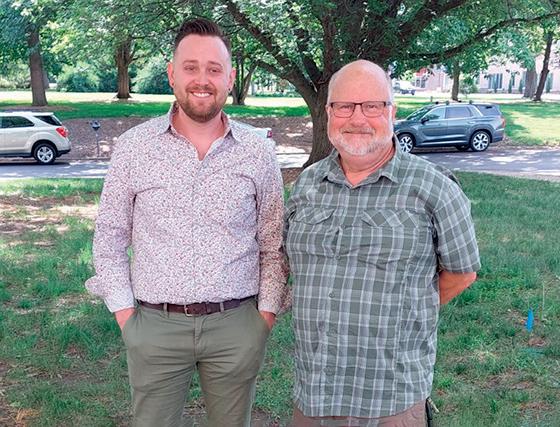
GLOBAL
America turns to grass to save water and carbon
Pages 72-73
MILK PRICES
Pages 60-62
info.uk@forfarmers.eu www.forfarmers.co.uk @ForFarmersUK
OF THE MONTH:
to monitor rumen health – p24
TIP
Different ways
Pages 14-15 High feed value
Volume 70 Issue 7
Break the cycle with a brassica crop July 2023



17-18 january 2024 LAMMAShow.com

Contacts
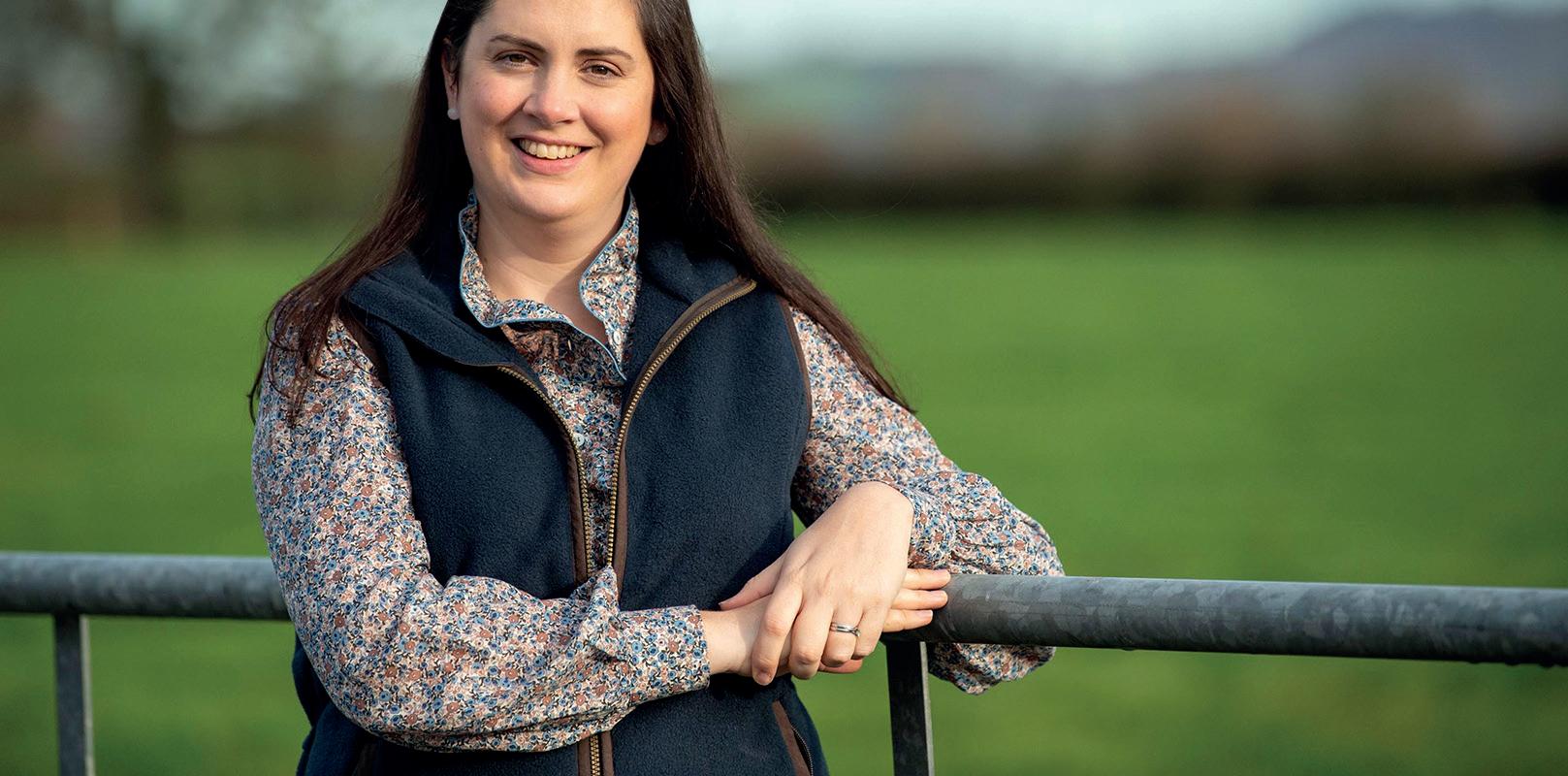
a word from the editor
It looks like the comments on the weather in my column last month were fairly accurate. We le the cold and wet weather behind and, as I write this, we nd ourselves in the middle of a very hot and dry spell.
We have quickly ipped from one extreme to the other, and up and down the country grass is already burning up. Worryingly, we still have a lot of summer to go.
Grass has certainly taken a hammering over recent years and experts tell us that much of our grassland is now in dire need of some rejuvenation following several years of challenging conditions.

So it is topical that in this month’s magazine we discuss the bene ts of a full reseed versus short-term solutions such as reseeding.
A full reseed is certainly a costly exercise, but the investment may well be worth it to ensure our grass leys are as productive as possible, particularly when we are still seeing relatively high feed costs.
In the grassland section we also look at the important questions to ask when deciding which grass seed varieties you should be purchasing, and we detail some trial work which is set to get underway looking at the bene ts of herbal leys in dairy cow diets. It is also interesting to see the value that farmers and researchers in America are pu ing on their grassland (see pages 72-73) not only as a forage, but also as a way of improving the environment.
Updated logo
And nally, you will see from our front cover a small change to the Dairy Farmer logo. is is simply rea rming our business links to sister title Farmers Guardian. Content within Dairy Farmer will remain the same, with articles exclusive to the relevant titles. For more from both titles check out our recently relaunched website farmersguardian.com

3
Dairy Farmer, Unit 4, Fulwood Business Park, Caxton Road, Preston, Lancashire PR2 9NZ Origination by Farmers Guardian, Unit 4, Fulwood Business Park, Caxton Road, Preston, Lancashire PR2 9NZ. Printed by Precision Colour Printing, Halesfield 1, Stirchley, Telford TF7 4QQ. No responsibility can be accepted by Dairy Farmer for the opinions expressed by contributors. Editor Katie Jones 07786 856 439 katie.jones@agriconnect.com Content Editor/Designer Mike Begley 01772 799 405 mike.begley@agriconnect.com Picture Editor Marcello Garbagnoli 01772 799 445 marcello.garbagnoli@agriconnect.com Sales Director Stephanie Ryder 07917 271 987 stephanie.ryder@agriconnect.com Account Manager Mark Jackson 01322 449 624, mark.jackson@agriconnect.com Classified Advertisements 01772 799 400 fgclassified@agriconnect.com Advertising Production Justine Sumner 01772 799 437 Fax: 01772 796 747 justine.sumner@agriconnect.com Circulation and subscriptions 0330 333 0056 help@subscribe.farmers-guardian.com Subscription rates: UK £65 a year Europe: £85 World: £95 ISSN 1475-6994 © Farmers Guardian 2023 All rights reserved. No part of this publication may be reproduced or transmitted in any form or by any means, electronic or mechanical including photocopying, recording, or any information storage or retrieval system without the express prior written consent of the publisher. The contents of Dairy Farmer are subject to reproduction in information storage and retrieval systems.
JULY 2023
What’s inside?
AHDB levy increase must deliver for dairy farmers
Dairy farmers have criticised the timing of a proposed increase in payment for AHDB services, warning the rise must deliver for them or a vote on the viability of AHDB’s future could ‘intensify’.
From next April, levy payers are likely to see an increase, as the organisation sets out its plans to grow its income in the backdrop of what farmers said were ‘unprecedented pressures’, including high inflation.
Some in the industry say the cost of the increased levy will be ‘minimal’, but livestock farmers

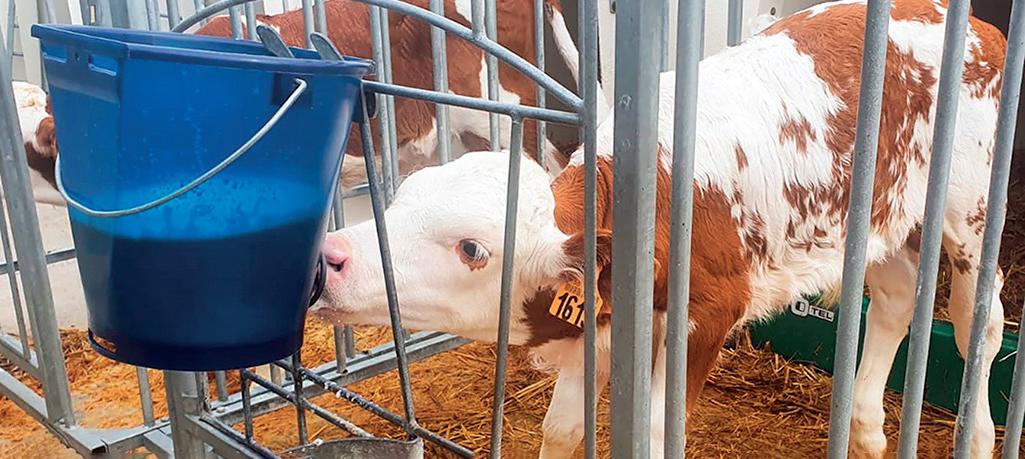
are left wondering what the actual cost will be.
Dairy farmer Colin Murdock, from south west Scotland, was shocked to hear the proposal and criticised AHDB’s work.
He said: “I am yet to see any tangible benefit for what we spend and would quite happily see it done away with.”
Economic climate
Warwickshire dairy tenant farmer Pete Ledbury said he was sympathetic to the economic climate AHDB is operating in.
He said: “I suppose they have running costs which will all have
Concerns that plant-based Lurpak could damage brand
JFarmers have raised concerns Arla could damage the image of its number one brand, as the dairy co-operative announced it will launch a plant-based version of Lurpak in the UK and Denmark in 2024.
But Arla Foods Europe chief commercial officer Peter Girotz-Carlsen has reassured farmers its main focus remains on dairy.
But he said they needed to attract the younger generation to have the ‘same love for Lurpak’, with most purchasers over the age of 45.
Dairy farmers online raised concerns the move would ‘devalue’ the brand, with those from other processors concerned about the effect on the whole industry.
Michael Oakes, NFU dairy chair, highlighted other dairy processing businesses had alternatives in their portfolio.
He said: “Even though the market is small and we can see recent failures such as Meatless Farm, it is a market, if not small. “A lot of dairy businesses worldwide have gone into it.
Premium brand
“I think the bit which has concerned Arla farmers is it is their premium brand.”
But Mr Oakes acknowledged that Arla will have researched the move in depth and believed it was a ‘good idea’.
NEWS 4
JULY 2023 VOLUME 70 ISSUE 7 JULY 2023 8 DAIRY TALK Updates from Gemma Smale-Rowland and Tom Rawson 10 ON FARM Dairy Shorthorns have stood the test of time 14 DAIRY MATTERS ‘We will just batten down the hatches and wait for the tide to change’ 16 VET’S VIEW Bovine ischaemic teat necrosis is widespread 18 WORLD DAIRYING Low-cost milking system in New Zealand 20 PHOSPHOROUS 22 SLURRY 24 RUMEN HEALTH 26 CONFERENCE 30 BRITISH FARMING AWARDS We catch up with last year’s Sustainability winner 32 SUSTAINABILITY 34 #FARM24 Back for 2023 36 GRASSLAND ESTABLISHMENT Variety choice, herbal leys and establishment advice 44 BREEDING & FERTILITY Managing dry cows, future genetics and herd indexes 58 MACHINERY Bedding machinery options 60 MILK PRICES 64 MILK ANALYSIS EU prices remain in the doldrums 66 NEW PRODUCTS Round-up of products and updates hitting the market 70 GOOD EVANS ‘People can’t eat trees and wildflower meadows’ 72 GLOBAL America turns to grass to save water and carbon 74 RESEARCH
66-67 New Products
34-35 #Farm24
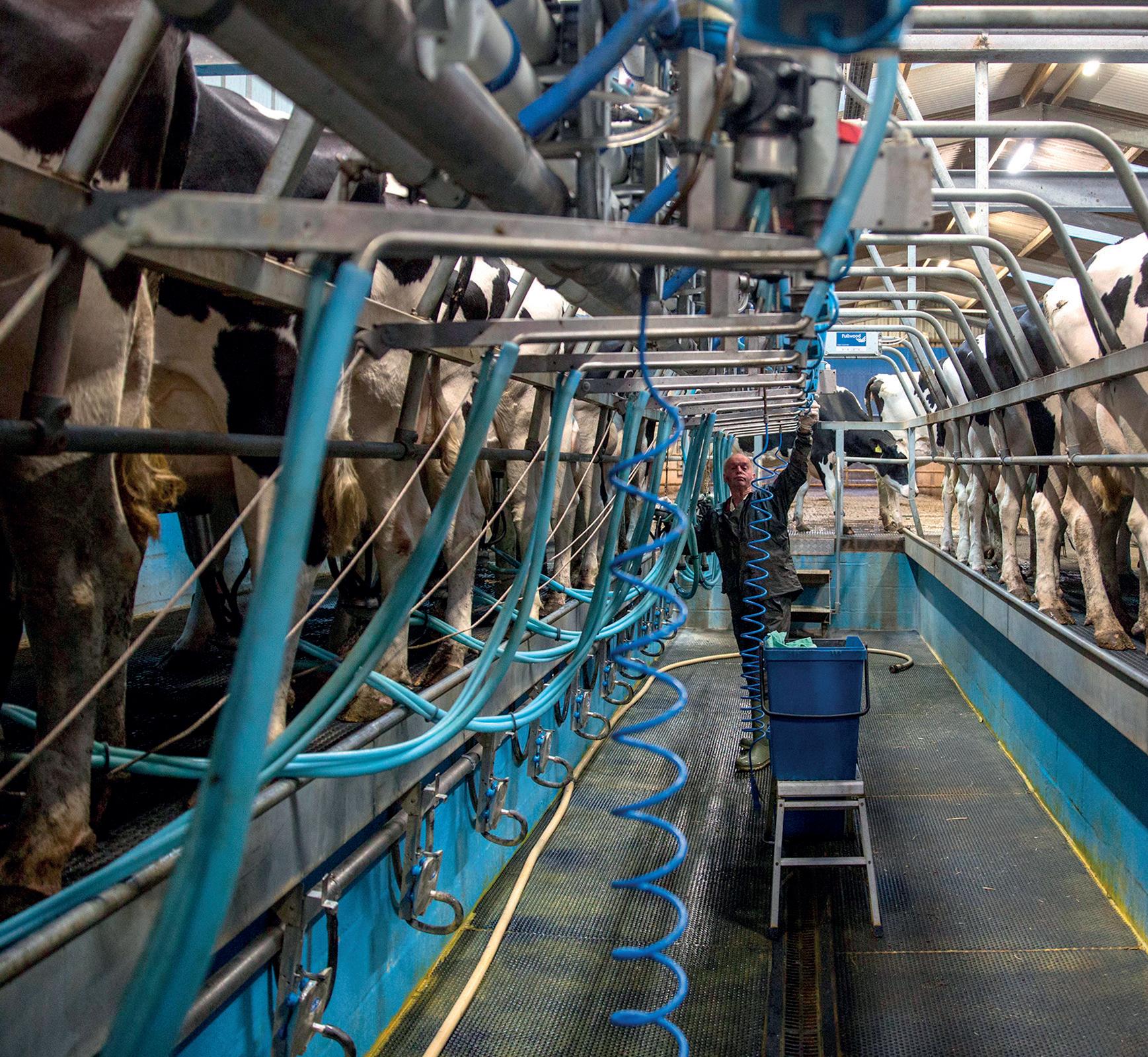
gone up so that is understandable. Personally I think they are a good thing.”
Organic regenerative dairy farmer Rob Harrison said the levy increase was long overdue, but going forward AHDB must ensure ‘costs are kept under control’.
Mr Harrison said: “I think it is a long time since AHDB put up levies, certainly in dairy, and with increased costs not helped by restructuring and VAT issues, the levy increase is understandable.
“I think AHDB performs an important role for the industry. However, increasingly, it needs to make sure costs are under control
and what it does is very focused.”
Last year, as part of the ‘Shape the Future of Farming’ consultation, AHDB approached levy payers to establish the priorities for each sector.
Opportunities
AHDB said each year the levy was ‘invested in tackling opportunities and challenges’ which were not addressed by Government, individuals or organisations, including independent research, the strategic farm network, identi cation of new export markets and domestic marketing.
AHDB’s divisional director





From next April, levy payers are likely to see an increase, as AHDB sets out its plans to grow its income.
of engagement Will Jackson highlighted there had been no increases for more than a decade, with the value of the levy eroded by about 40% in this time.
He said: “Without a levy increase, we will lose the expertise and impact the four sectors need.”
George Dunn, chief executive of the Tenant Farmers Association, said the key challenge for AHDB was making this move in the ‘midst of rebuilding condence in its brand’.
He said: “Increasing levy rates at this time will only intensify the pressure for a yes/no vote on the future of AHDB.”
FARMING EQUIPMENT & TECHNOLOGY FUND 2023
Eligible items in our ranges:

Omsco changes
JOmsco has confirmed that chair Neil Kennedy will officially leave the role in July after three ‘difficult’ years of trading.
Carl Ravenhall has been announced as the next new chair of Omsco to take over from Mr Kennedy.
Mr Ravenhall, who has 35 years’ worth of experience in senior level leadership roles at Ornua Foods UK, Milk Link’s cheese business and Muller Wiseman Dairies, will lead the British farmer-owned co-operative through the next phase of its development.
Arla departure
JArla Foods UK managing director Ash Amirahmadi has announced he will leave the company on July 31 to become chief executive of Sofina Foods Europe. His successor has already been confirmed as Bas Padberg, who is currently vice-president of Arla Foods Southeast Asia.
Mr Padberg will not start his new role until January 1 2024.
Mr Amirahmadi said it was a difficult decision to leave Arla after working for the company in many roles during a near 20-year stay.
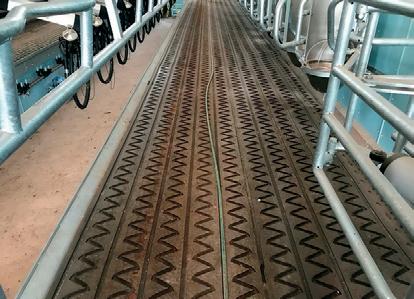






















Official Distrib f View our cow comfort range: www.wilsonagri.co.uk Contact us at HQ: 028 7086 8430 Mattress Dairy Grip rubber AgriCow Pendulum Cow Brush Calf De-horning crate
Gates Cattle Crushes Slat Rubber
Calving
Matthew Evans 07922 422556 Charlie Sutcliffe 07703 679023 Midlands & Wales Scotland & Northern England
Livestock Equipment www agrikit co uk A COMPLETE RANGE OF COW COMFORT PRODUCTS Pasture Mat the premium cow mattress
NEWS 5
JULY 2023
Derbyshire aiming to be TB-free in a decade
Abovine-TB free future in 10 years’ time in Derbyshire would be a huge undertaking, but is achievable if policy was ‘led by science and not politics’.
This was the message from a round table, organised by Dairy Farmer’s sister title Farmers Guardian, which brought together farmers from the county along with a farm vet and a Farming Community Network (FCN) volunteer.
Farmer Jane Bassett, who hosted the meet-up at her farm near Buxton, explained her herd last went down with bTB seven years ago and she was staying cautious about the future.
Ms Bassett said: “TB control is very much in the balance at the moment. If we keep science at the front and politics at the back, we have a chance.”
Sitting next to Ms Bassett was farm vet and technical director for the TB Advisory Service, Sarah Tomlinson.
Respected in the area by farmers and fellow vets for her tireless work in tackling bTB, she started to get visibly emotional thinking about the prospect of eradicating the disease altogether.
She said: “I am adamant that by the time I retire we will be TB-free.”
Acknowledging the effort by

farmers in the room, Ms Tomlinson said: “We fought really hard with the badger cull and, at the same time, farmers faced six-monthly testing, lots of gamma testing which resulted in the loss of a lot of cows.
“I think we have thrown everything at this disease here in Derbyshire.”
With a General Election looming, these farmers fear badger culling could be ‘stripped away’ if Labour was elected.
Dairy farmer Jess Worsey milks a 280-head mixed Jersey cross herd. She said she has been ‘in and out of TB all of her life’, but badger culling had reduced the risk in the area.
She said: “If we go back to not having the cull, we have not gained
anything. Badgers will start breeding again, they will overpopulate again and they will take over. We will be right back to where we started.”
Ms Worsey admitted she has ‘little faith’ in Derbyshire ever being a bTB-free county.
She said: “I have never known a time that we have not had the worry of TB.”
She said more focus needed to be on ‘changing the narrative to the wider public and Government around the badger cull’.
She said: “I love wildlife and I speak for a lot of farmers. I do not want to kill badgers, I want to control them the same as we want to control other animals. It is not farmers versus badgers.”
New welfare strategy launched by dairy industry
JA new five-year UK Dairy Cattle Welfare Strategy has been launched by Ruminant Health and Welfare. This is an update to the previous dairy welfare strategy, the first of which was launched in 2010, and has been designed to help the industry show progress
in animal welfare by 2028.
Speaking at the strategy launch, Gwyn Jones, vice-chair of Ruminant Health and Welfare, said importantly the strategy had support across all four nations.
He said: “The industry’s shared vision is for the UK dairy industry
to demonstrate evidence-based progress in six key areas of cattle welfare by 2028.”
These six key areas are: thriving cows; healthy feet; comfortable cows; appropriately nourished cows; healthy udders; and positive welfare.
James Fanshawe, a farmer and volunteer of FCN, which is currently running a survey to understand the impact on farmers, said farmers feel like they are being ‘steamrollered’ and are ‘helpless’. He said: “I think the Government does understand it, but does not know what to do about it and uses sticking plaster solutions.”
Emotional toll
Alongside the emotional toll of bTB, farmers often ring up the FCN helpline to share their financial worries.
Mr Fanshawe said: “Our products are trying to compete on an international marketplace.
“These international players do not have the same cost structure we have. Australia and New Zealand do not have this TB cost.”
An APHA spokesperson said: “We are acutely aware of the devastating personal impact of bTB on livestock owners and their families.
“That is why we are working hard to support farmers whose herds experience a TB breakdown and ensure that information and support is readily available.”
NEWS 6
JULY 2023
Left to right: James Fanshawe (a farmer and volunteer at Farming Community Network); Jess Worsey (dairy farmer); Andrew Mycock (dairy farmer), Farmers Guardian’s Rachael Brown; Sarah Tomlinson (farm vet and TBAS adviser); and Jane Bassett (suckler cow and sheep farmer).
BECAUSE IT’S ABOUT QUALITY

Creating generations of healthy cows.
Boost milk production and reduce feed costs with Evonik’s rumenprotected methionine for dairy cows. Mepron® delivers highly concentrated DL-methionine precisely where it benefits the animal most – in the small intestine. How? With science. Mepron® is equipped with a sustained release film coating that ensures handling and mixing stability. It can be mixed homogenously, and is not affected by potentially abrasive components, high temperatures or low pH.
Sciencing the global food challenge. | evonik.com/mepron
DAIRYTalk
Gemma Smale-Rowland
Fourth-generation farmer Gemma Smale-Rowland farms with her parents at North Petherwin, near Launceston, north Cornwall, where they milk 120 pedigree Holsteins under the Glebewin prefix. She established the Cornish Moo brand in 2018 and was one of the first farmers in the country to install an on-farm milk vending machine.
“ Our challenge now is what we as farmers can do to try and reduce the pressures on ourselves, the land and our animals
Is it a British obsession with the weather or is it just farmers? I wonder what it would be like to work in an office and the weather have no effect on your life other than deciding if it is a barbecue for the weekend or not.
W hat felt like a very long spring with endless days and weeks of rain, with harvesting and planting delayed by about three weeks, now feels a distant memory. It seems hard to believe that conditions were so wet that tractors were struggling for grip at planting, and a month on, we need a good dose of rain.
Winter cereals
W e have moved away from winter cereals due to our heavy soils and wet winters, but with a second dry summer affecting the spring crops, maybe another rethink is needed.
A local farming stalwart recently recited the old wives’ tale ‘a wet and windy May will fill the barn with corn and hay’ – well, the barns are definitely empty, so we are waiting.

With a second dry summer affecting the spring crops, Gemma is considering a return to winter cereals.


C ornwall has been under a hose pipe ban since last summer and the reservoirs only managed to fill to 80% over the winter. With most back at 38% now, it is a concern with no sign of any rain forecast anytime soon. Water sourcing is creeping up the list of priorities for us, as I am sure it is for many of you.
T he weather has always made farming interesting and will throw challenges at us that we have to adapt to, but these extremes seem to be becoming much more commonplace, and our challenge now is what we as farmers can do to try and reduce the pressures on ourselves, the land and our animals.
Excitement
E lsewhere, the excitement and fun fair of show season is here. For all of us, it is a time we manage a few hours away to socialise with friends. Locally, the turnout of stock numbers has been high, and the standard has ramped up.
A s you wander around county shows, the pure passion for what we do feels very strong this year, and as I stand back and look around, I have realised how clever we all are as farmers to be caretakers of the country, work hard to help feed the nation and work tirelessly to breed quality stock, grow perfect produce and showcase what we do so well.
8
JULY 2023
Tom Rawson
Tom Rawson, who lives in West Yorkshire, is a director of Evolution Farming, a business with a team of 55 staff. The business manages about 3,300 cows across nine units, two of which are organic and one which is in organic conversion, located in seven different counties in the North West, Midlands and eastern regions of England.
“ I have always seen the Netherlands as a major player in the dairy industry. This position now feels very much under pressure
Well the weather is again at the front of our minds. After what can only be described as a rubbish spring, it now appears to be hot and dry. I have mentioned it before in this article, so apologies, but as a timely reminder a photo cropped up on my phone from only two weeks ago with some 5,000kg of dry matter paddock surplus on the platform heading for silage.
Two weeks later, we are just about to open the clamp and start feeding out that same silage.
Again, lessons have been learned from last year and we will start supplementary feeding sooner rather than later. Meal in the parlour has gone from 1kg to 2kg per day to take the pressure off the wedge.
The milk price is hopefully levelling off which should hopefully bring some comfort. However, we are now 5ppl below where we budgeted to be for June, which at best can only be described as a massive pain.
Luckily, there are several elements of our budgets which are now coming under on cost spends, such as diesel and fertiliser. However, all of this comes back to Mother Nature performing and providing rain throughout summer.
Nuffield tour
I have just returned from a Nuffield dairy tour over to the Netherlands with the premise of the trip being to understand what pressures the farmers are under.
The situation over there is seriously worrying for their dairy farmers. From what we gathered, the Government there is planning to withdraw the derogation and reduce the organic nitrogen limit over the next couple of years from 250kg/hectare to 170kg/ha.
Dutch dairy farms are traditionally stocked around the 2.5 cows/ha mark and, on top of that, give 10,000 litres of milk per cow, which adds to the problem.
The solution would be to export your manure to someone else. However, we were told this is already happening, with many arable farms now at maximum application rates themselves and, in some cases, slurry is being exported across the border to Germany, adding a large extra cost to an already expensive operation.
The Dutch Government is offering to purchase

land from the farmers for which they are being offered 120% of the usual land value.
The interesting point here is that although this is a Dutch-based scheme, if the farmer takes the ‘golden handshake’, they in turn have to agree to not restart livestock farming anywhere in the European Union.
This is a red flag to me, as it is obviously being led by the EU in a bid to dramatically reduce livestock numbers by taking out whole farms not just to reduce cow numbers.
My knee jerk reaction is that with a sense of relief we chose the Brexit option, although the chances of our own Government looking over the channel and trying to ‘keep up with the Joneses’ is pretty strong I would say.
The other stand-out point for me was the lack of succession on farms in the Netherlands.
No interest
On a number of farms we visited, there were farmers in their 60s with all the next generation working away in town with no interest in working on the farm.
Inheritance Tax sits at 5%, but as the price per land is so high, I guess it would still be a mega retirement plan. One farmer was asked where he saw himself in 10 years. His answer was simple: ‘the Bahamas’.
In summary, I have always seen the Netherlands as a major player in the dairy industry. This position now feels very much under pressure.
9
DAIRY TALK
JULY 2023

The Amber herd is one of the oldest Dairy Shorthorn herds in the country but the cows are proving their worth across a wide range of modern farming systems. Chloe Palmer reports.
Dairy Shorthorns have stood the test of time
Dairy Shorthorns have been the breed of choice for the Hole family for almost eight decades.
James Hole’s grandfather established the herd a couple of miles from the family’s current home, Eddlestow Hall Farm near Ashover, Derbyshire, where they have farmed
since 1956. James believes the breed has stood the test of time and is still one of the most versatile, being particularly well suited to their farm, perched on top of a chilly east-facing hill on the edge of the Peak District.
He says: “Shorthorns are easy to manage and will adapt to any type of system. ey are very well suited to our local environment and are an
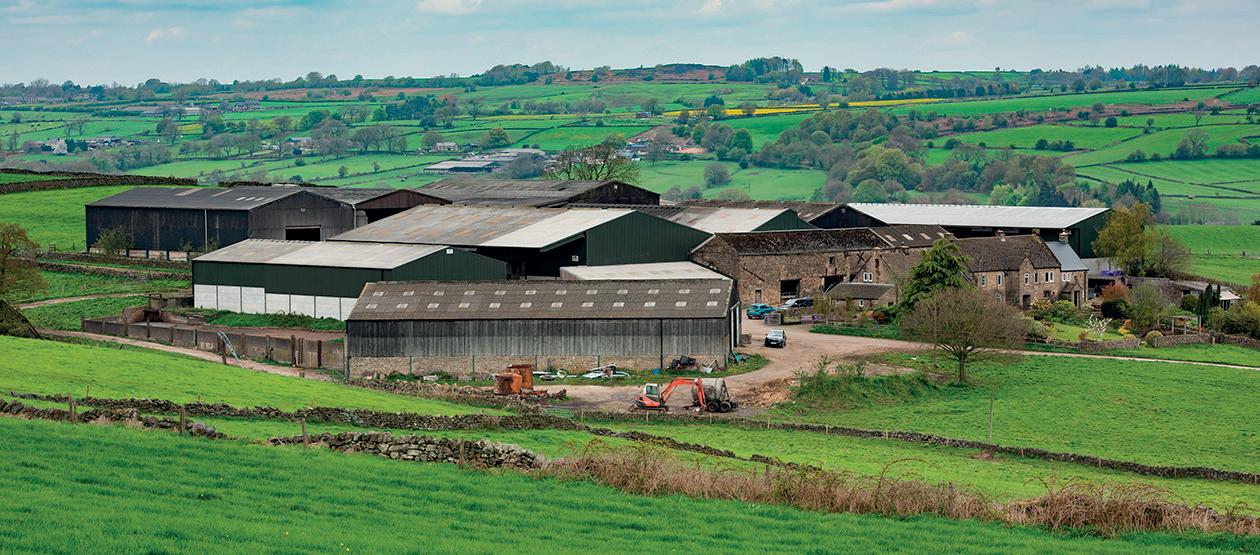

exceptional grazing animal, especially for extensive systems.
“We have seen renewed interest in our animals from people who have gone down the grazing route and are looking for a good grazing animal.
“We have also recently sold two bulls to Ireland where they were looking to improve fertility across their herd.
“Longevity and excellent legs and feet are just some of the a ributes of this breed and we have always bred for good udders.
“Our cows average six lactations, but we have several cows in the herd which are on their tenth lactation and are back in calf. We are not looking for a cow which is too tall or extreme, but rather we want a powerful cow which is compact.”
Mick Taylor, their herdsman and only full time employee, agrees, adding they are looking for sires which will ‘breed a good type of cow with reasonable yield and components’. e Dairy Shorthorn Society’s genetics company, Shorthorn Sires UK, has rented several bulls from the farm over the years, and semen is currently available from Amber Firefox and Amber Magnum.
Commission
James says the arrangement works well for them.
“ ey cover the costs of collecting, producing and selling the semen and we receive a small commission and also a certain number of free straws for our own use.
“We nd some private customers will see our bulls advertised and will
JULY 2023 10 ON FARM
PICTURES : John Eveson
In-calf heifers from the Amber herd of pedigree Dairy Shorthorns.
Eddlestow Hall Farm, Derbyshire.
then enquire whether we have any other bulls by the same dam for sale.
“We use our bulls’ semen on our cows, and also buy semen from other bulls.
“We usually keep two stock bulls here which we will use on the heifers until the bulls grow too big and then we sell them privately,” says James.
Mick has been working with the Amber herd for 18 years and knows the history and performance of each of the cow families.
Bulls
He says: “ e Amber Dainty Princesses are the most proli c cow family, having produced 330 cows and we o en select our stock bulls from this family.
“ ey are consistent for both type and milk yield and have also performed well in the show ring in the past.”
e family used to show and achieved considerable success in the ring, securing the breed championship at the Royal Show four times

and winning at the Cheshire and other county shows.
Now they limit their showing to the Society’s regional herd competition where this year they won the best heifer in milk category with Amber Princess Anne 143.
James and his wife, Julie, are joined at Eddlestow by Josh Neville, who has been working at the farm since he was 11 years old and now juggles his time there with studying
at Harper Adams University.
Josh shares their passion for cows and is clearly viewed as indispensable and part of the farm’s future by his senior counterparts.
Although breeding exceptional pedigree animals is what the farm is renowned for, it is a commercial dairy farm and the cows re ect this.
James says: “We blend some Red Holstein with the Shorthorn and, over time, yields have increased
from an average of 5,500 litres to 6,000 litres achieved 40 years ago to our current herd average of 8,600 litres.
“ is is also partly down to modern feeding methods where we are using diet feeders and have sown new leys.
“I think one of the secrets to our success is we produce most of our own ration here on the farm so we are not dependent on bought in feed.
“We grow oats, barley and wheat, which we mill and mix ourselves and just add in some soya protein and minerals as well as grass silage.
“On the arable land, we grow a short-term Italian ryegrass ley in the arable rotation as a break crop to help control grass weeds.
“We mow this every month through the summer and typically take four or ve crops which we bu er feed to the milking herd when they come in to be milked.
“ e silage from these one-year leys is very high quality and we nd









Faced with losing market share, Finance for Farms were able to help this farmer scale up his operations and fulfil demand by increasing dairy cows and milk output cost-effectively. Scan the QR code to watch the video
JULY 2023 11 ON FARM Finance for business use customers only. All finance is subject to credit status, approval, terms and conditions. Finance for Farms is a trading name of Shire Leasing PLC who is authorised and regulated by the Financial Conduct Authority for certain types of consumer credit lending and credit related activities that are regulated under the Consumer Credit Act 1974 and by the Financial Services and Markets Act 2000. 01827 300 333 farmers@shireleasing.co.uk www.financeforfarms.co.uk Discuss agricultural finance solutions for livestock, machinery, vehicles and more.
Open phone camera & scan
and learn more.
Left to right: Herdsmen Josh Neville and Mick Taylor, with Julie and James Hole, who run the Amber herd near Ashover, Derbyshire.
ON FARM
Longevity and excellent legs and feet are just some of the attributes of this breed
JAMES HOLE
it helps to iron out any uctuations in nutrition from the grazed grass so maintains yield.
“ is is important here as the cows would struggle to yield so well from some of our steeper, rough grazing elds,” James says.
Across the rest of the farm, longer-term leys are grown, but these are ploughed up and a crop of wheat grown there for a year before they are re-seeded back to grass.
Grazing
e grazing platform, situated around the farm is the ‘very di cult’ elds, according to James.
“ e elds are generally on heavy clay and are steep, with many land drains. We do re-seed them occasionally, but it is not an easy task and they need a lot of maintenance.
“We aim to turn the milking herd out by April 20, with the youngstock usually out before then.
“ is year was a challenge, because of the wet, cool start but we have a good network of tracks and

the cows need to be able to walk a long way, so good mobility is important to us.”
Heifers generally calve down at between 27 and 30 months and although a few will calve earlier. Mick says a younger calving age is not something they strive for.
“ e heifers would need pushing so much if we were to try and calve them all at two years. We have a few which calve then as if they have grown on really well, we will serve them a bit earlier,” he adds.
Calves are kept in individual pens for the rst two to three weeks of their life and then go into groups in pens.
James says their calf feeding regime results in a slightly later weaning date.
“We wean at eight to ten weeks; we keep them on milk a week or
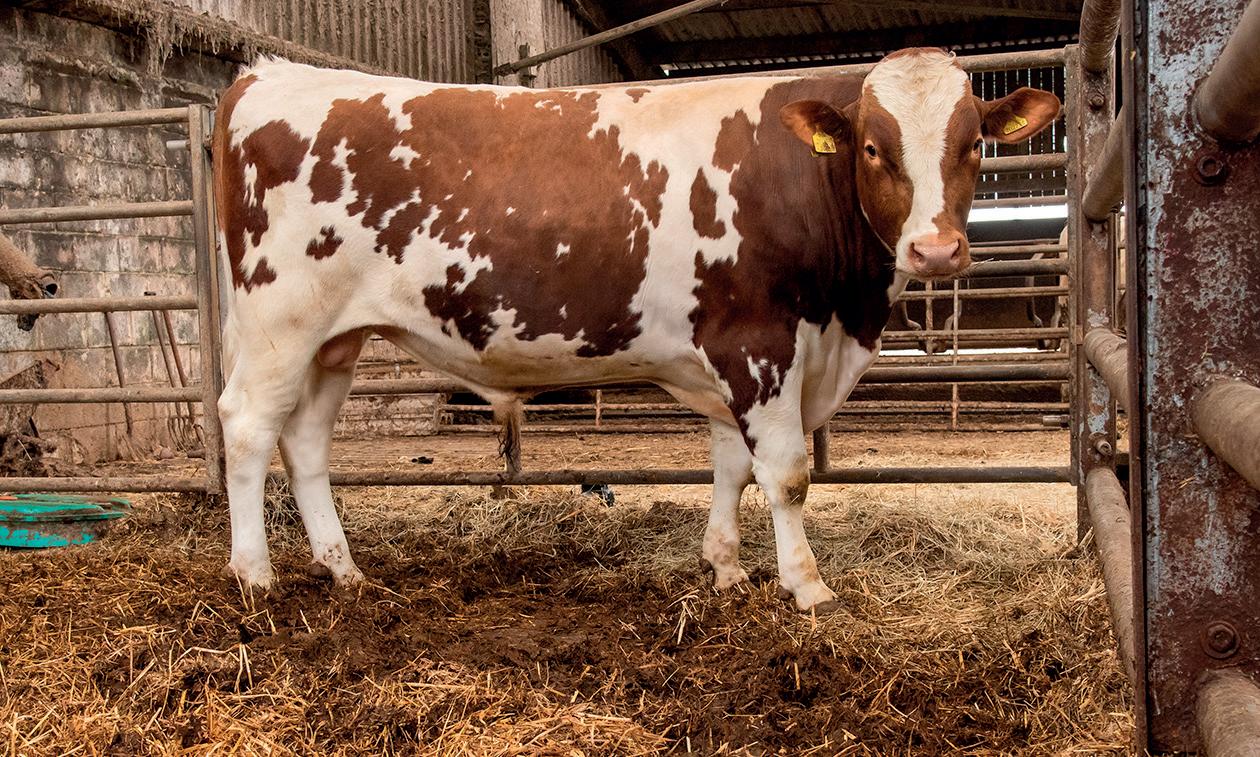

so longer because we do not feed a rearer nut. Instead, we mix our own calf creep feed from our own milled mix.”
When they are housed, they are introduced to cubicles and James says this means they are never a problem when they join the milking herd in the main cubicle shed.
At any one time, about 100 dairy cross beef bulls will be housed at the farm and nished on the homegrown ration.
“We use male sexed beef semen from Blue, Angus and some Limousin bulls on the lower end of the milking herd. is works well for us as otherwise if use conventional beef semen, we end up with small numbers of females which are
Farm facts
rEddlestow Hall Farm has land rising to 300 metres (990ft)
rThe farm is home to the Amber herd of pedigree Dairy Shorthorns from which the first animal was registered to the Society in 1944
rThe land extends to 202 hectares (500 acres) of which about 81ha (200 acres) is in the arable rotation, 56.5ha (140 acres) is temporary grassland and about 64.5ha (160 acres) is permanent grassland
rThe arable rotation

then more di cult to manage.
“We nish the bulls at about 550kg liveweight and sell them through Bakewell market.”
Looking to the future, James mentions genomics as something they will certainly look at although there is currently limited data for the Shorthorns.
Jame says: “We have to be open to these advancements and we are conscious that one of the issues with the Shorthorn is the limited choice of sires. We have looked further a eld for our sires, but we are looking for a grazing animal and this guides our choice of genetics. We are striving for continual improvement and the best genetics and feeding will help us achieve this.”
includes oats, barley, wheat and temporary grass
rThe herd comprises 150 cows in the milking herd, with a further 200 followers including replacements and surplus females which are usually sold privately or through Leek market. On average six bulls are sold privately each year
rCows average 8,600 litres at 3.18% protein and 4.5% butterfat
rMilk is sold on a liquid contract to Muller
JULY 2023 12
Stock bull Amber Diamond.
The Amber herd is averaging 8,600 litres at 3.18% protein and 4.5% butterfat.
Keep your butterfat levels on track this Spring





Boost your herd’s milk yield and milk fat content by adding Butterfat Extra to their regular feed throughout the Spring.

Butterfat Extra is:
■ Highly digestible with rumen-protected fat
■ Easy to store and ready to feed
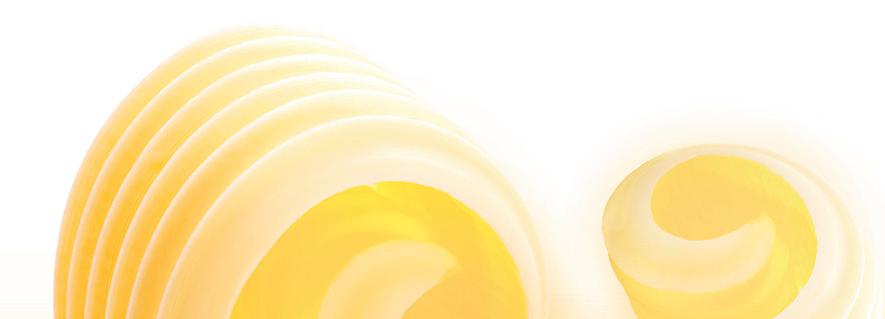







Butterfat Extra can help you achieve:
A typical rise in butterfat of 0.3% Increased milk yield by up to +1 litre per cow/day


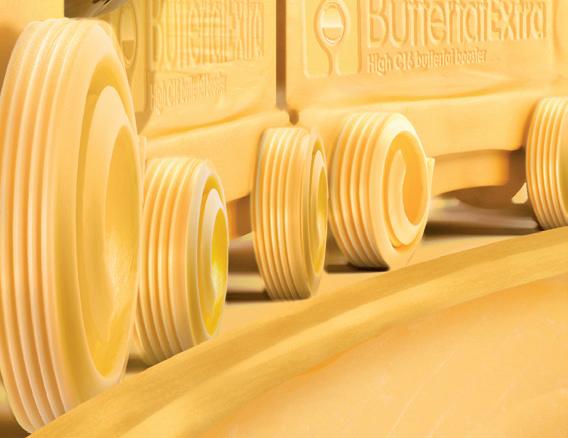







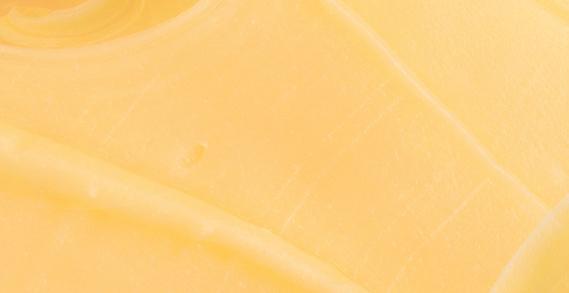













&TESTED BY UK FARMERS
TRIED
your local merchant or call Trident on 07540 819080 tridentfeeds.co.uk
Contact
DAIRYMatters
‘We will just batten down the hatches and wait for the tide to change’
Dairy farmer Liz
Haines and her husband Nick took on a tenanted farm in Staffordshire in 2020, where they milk 400 crossbred cows in a joint venture with two business partners. Liz is an AHDB dairy sector council member.
Despite the fact that we are well past the spring peak of milk production, milk prices have continued to tumble. It is frustrating that supermarkets have returned to their price wars so quickly, with milk now retailing at 1.55p for four pints at most retailers – even Marks & Spencer.
During the pandemic there was a sense that, amidst the fear of food shortages, people were beginning to value staples like milk and were happy to pay more, but with the cost of living crisis really biting now, every penny counts.
For the last few weeks, food price inflation has been
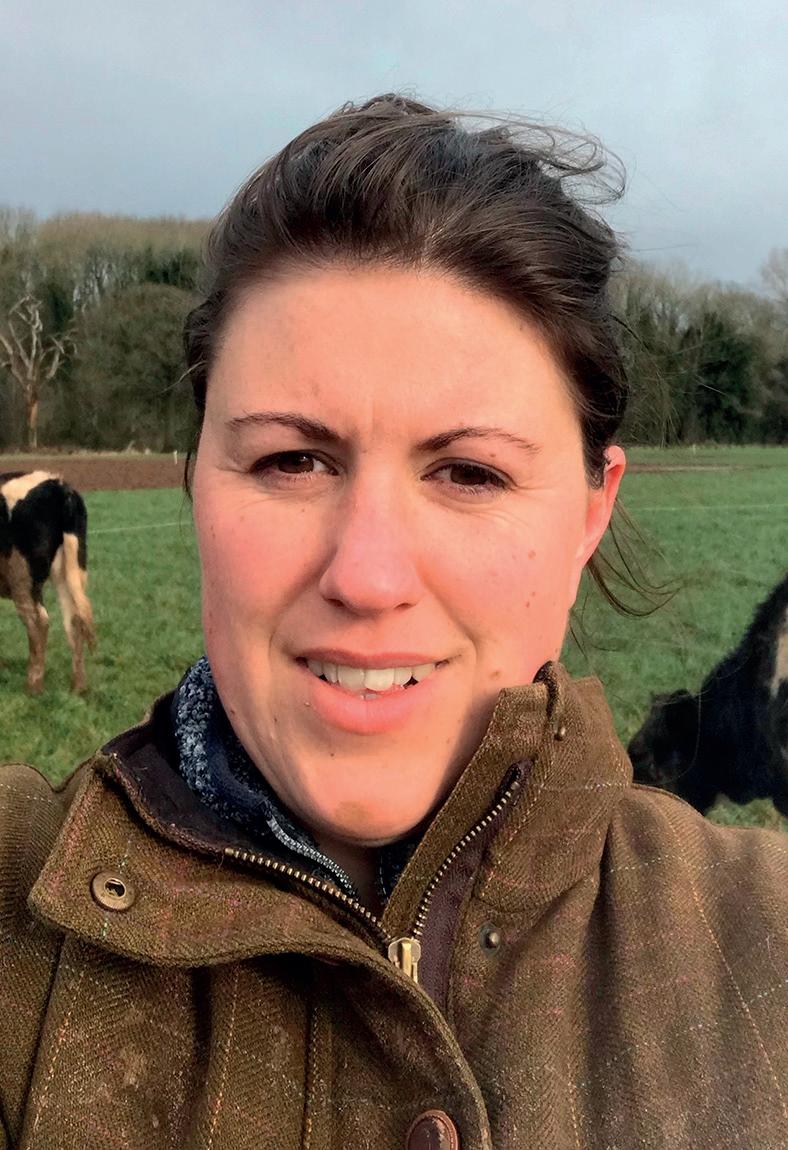 Liz Haines
Liz Haines
all over the media, with newspapers clamouring to report the 9% increase in May – even though dairy prices actually fell 15.1% according to the British Retail Consortium. I can’t help but feel that someone in the Government has done a blinding PR job of distracting from the real causes of the cost of living crisis; the hike in interest rates which has caused some people’s monthly mortgage payments to double.
Milk prices
In our business, the milk price has fallen by over 25% since Christmas, which is unprecedented in my decade of farming and has put real pressure on us. However, I do have to remind myself that the price rises last year were also unprecedented, and, despite the challenges with the drought and fertiliser prices, it was financially a good year for us and many others.
During April and May, on the back of the wet spring, we managed to get by on grass alone, and the resulting absence of feed bills was very welcome. But now, with no rain on the farm for a few weeks, the deliveries have started up again – just as I had finished paying off the finance payments on last year’s fertiliser. With the unfortunate bombing of the dam in Ukraine, we were concerned that today’s comparatively low prices could be driven up again and decided to buy another load as an insurance policy. Only time will tell whether this will be the right decision or not.
At the start of the year, I had hoped the milk price cuts would be short-lived, with indications that the market would rise again in the second half of the year as China used up its milk powder stocks and consumer demand improved as the economy recovered. But so far, any improvements have been slow to gain momentum.
While the continuing dry spell is unwelcome from a farming perspective, the only thing we can hope is that it will keep a lid on milk volumes and
14 JULY 2023


“ The only thing we can do on the farm is control our costs as much as possible and get the basics right
create some positive pressure within the market. e other way to create pressure within the market is to export; something Rishi Sunak recognised in his glossy ‘Farm to Fork Summit’ with the announcement of a £1 million fund to boost British dairy exports. But unfortunately, I can’t help but think that by the time the civil servants actually work out a way to deliver this money where it is needed, the current crisis will have abated and we will be dealing with a new set of challenges – and potentially even a new Government.
Long-term prospects
I also keep reminding myself that, despite the current squeeze, the longer-term prospects for dairy are good.
e global population continues to grow along with demand for dairy.
e sad irony of Ireland commi ing €600m (£514m) to cull 200,000 dairy cows a er spending the last decade growing its dairy industry into a small but mighty exporting success story is not lost on me, but perhaps creates a vacuum British dairy farmers could ll – if our own Government doesn’t go down the same path.
As always, the only thing we can do on the farm is control our costs as much as possible and get the basics right. is won’t be the year for experimenting or investing in new technology. We will just ba en down the hatches and wait for the tide to change.

15 JULY 2023 Call us on 01772 690131 FILL A BAG WITH YOUR COLOSTRUM PASTEURIZE IN THE BAG STORE IN THE BAG WARM & FEED IN THE BAG WHAT’S MISSING? Answer = Bags for Colostrum. Simple & Hygienic. Scan here with your phone camera for more information G Shepherd Animal Health ADVICE • QUALITY • VALUE 2022-11 Udda Bags Advert_210mm X 77mm_09_22 copy.indd 1 31/03/2023 14:21
There are concerns that the recent dam bombing in Ukraine could result in another increase in fertiliser prices.
Bovine ischaemic teat necrosis is believed to be widespread across Great Britain, but its cause is undetermined and treatment options are limited. Wendy Short reports.
Bovine ischaemic teat necrosis widespread
Bovine ischaemic teat necrosis is most commonly found in first lactation heifers in the first 30-90 days in milk, says vet Dr Hayley Crosby-Durrani, who works at the University of Liverpool.
The disease causes dark red or black lesions on teats, around the point where they attach to the udder.
“In some cases these initial lesions can remain for days, or even weeks,” she says.
“In other instances, infection can progress rapidly and the teat may even fall off due to necrosis.
“Farmers tend to treat the symptoms with a topical spray or cream and, while this is not necessarily the wrong response, it is usually ineffective.
Culled
“If heifers are not culled in the first 90 days when the symptoms first show, they are often removed at the end of their lactations.”
Dr Crosby-Durrani says that the affected teats of recovered animals will have scar tissue that is formed as the lesion heals.
“This can lead to the teat becoming ‘banana-shaped’ and although it may still function, it will cause problems at milking.”
And she adds that studies have shown that 60% of cases will go on to contract mastitis or lose the teat.
Dr Crosby-Durrani says teat necrosis is an expensive disease, with one investigation indicating that only 20% of animals made a full recovery

at a minimum associated cost of £720/animal for treatment and production losses, while more than 22% were culled and the remainder were left with long-term complications.
One sample farm had 20% of heifers affected, but most reported just one or two cases.
The disease has been confirmed in older animals, but this is a rarity, she adds.
Bovine ischaemic teat necrosis history
J The first official report of bovine ischaemic teat necrosis was made in 2004, but anecdotal evidence dates back as far as 1985.
Most recorded cases occurred from 2008 onward, with a spike in numbers from 2014-2017, says Dr Crosby-Durrani. A questionnaire she sent out
The risk of a dairy animal contracting teat necrosis has been found to be higher on farms which have recorded cases of udder cleft dermatitis and chapped teats. The disease was thought to be linked to digital dermatitis but Dr Crosby-Durrani
to farmers in 2018 showed that half of respondents had witnessed a case and there was no bias in terms of geographical area, or whether herds were pedigree or commercial.
It seems to affect all dairy breeds, including Holsteins and Channel Island cattle.
disputes the connection, as only 30% of cattle she investigated had records showing both diseases.
JULY 2023 16 VET’S VIEW
Bovine ischaemic teat necrosis with the characteristic dark red and black lesions close to the udder.
VET’S VIEW
Treating bovine ischaemic teat necrosis
JDr Crosby-Durrani says: “Ideally, the affected teat should not be milked and it should be thoroughly cleaned and dried, before being smothered with some type of moisturising agent.
“If the disease has progressed to the licking stage, the prognosis is usually poor.
“Antibiotics will only be appropriate for treating any secondary infection, such as mastitis, and should be discussed with the vet.”
Vet
Dr Crosby-Durrani urges any producer who thinks they may have a case of teat necrosis on their unit to contact their vet.
“Some dairy farmers will recognise the symptoms and assume that it is just an issue which occurs sporadically within the herd.
“In addition, the lack of general information on bovine ischaemic teat necrosis means that some vets may not include
Cows su ering from teat necrosis will o en lick the a ected area and producers may observe blood on the noses of infected ca le.
“Infected teats show a reduction in the range of skin micro-organisms that are usually present on a healthy teat. It is possible that something is causing this decline in diversity.
Licking
“ e skin also has a higher level of pasteurella bacteria than normal.
“ ese bacteria are frequently found in the back of the mouth and may be introduced due to the excessive licking of the area caused by pain or irritation.
“Examination of a diseased teat under the microscope will reveal a type of white blood cell that is associated with
it when they are considering a diagnosis,” she says.
“Udder herpes is a wellknown ailment, but teat necrosis is less well-known so it is worth flagging up the suggestion during the vet visit.
“Much more research on the issue is required to give us a greater understanding of the disease and it would be very useful to have a surveillance system and a central database for recording case numbers.
“It would also be helpful to see whether there is any genetic connection or predisposition; at the moment we do not know if a calf from an affected dam is more likely to get teat necrosis.
“In the meantime, my goal is to continue my research to try and find some solutions so that we can minimise the risk to our dairy herds, while at the same time raising awareness among producers and among the veterinary profession in general,” she says.
hypersensitivity and allergic reactions. is is interesting because a newly-calved heifer will be exposed to a range of chemicals when she joins the herd and this factor could prove to be relevant.”

SPONSORED CONTENT

CLASS-LEADING HEAT DETECTION AND INSEMINATION TIMING
The SenseHub® dairy cow monitoring system from MSD Animal Health provides best-in-class heat detection accuracy and precise insemination timing guidance for better reproduction efficiency.

By constantly monitoring the subtle behavioural and activity patterns associated with the various stages of the fertility cycle, SenseHub’s neck collars and eartags accurately and reliably detect 95% of heats, including silent and weak heats.
The SenseHub app subsequently analyses the data collected from the collars and tags before sending a text message or email alert to highlight the optimum time for insemination to take place when using sexed or conventional semen.
This unrivalled heat detection accuracy, along with SenseHub’s ability to filter out any false heats, eliminates the guesswork from artificial insemination (AI) timing and contributes to improvements
in first service conception success and subsequent pregnancy rates.
It also eliminates the need for staff to make visual observations to spot bulling cows and heifers and reduces AI and semen costs.
SenseHub’s clear and easy-tounderstand charts and graphs also help herd managers to make informed breeding decisions. This can fast-track the herd’s genetic improvements by shortening the calving interval and reducing the number of open days.
The SenseHub system can also detect anoestrus cows, cystic cows and suspected abortions and can be used to monitor the health and well-being of cows during the transition period.
To find out how more about how SenseHub could improve heat detection accuracy in your herd, please call the SenseHub team on 01207 529 000. Alternatively, to send us an email, please contact us at allflexuk@msd.com For more information, visit farmersguardian.com/MSDSenseHub SenseHub is not intended to diagnose, treat, cure or prevent any disease in animals. For the diagnosis, treatment, cure or prevention of disease in animals, you
JULY 2023 17
Dr Hayley Crosby-Durrani
match that of medical devices or scientific measurement devices.
should consult your veterinarian. The accuracy of the data collected and presented through this product is not intended to
Following a number of years sharemilking, Blair and Penelope Drysdale bought their own farm in 2018 and now aim to run as low cost a system as possible. Chris McCullough reports.
Low-cost milking system to pay off debt
Taking over a dairy farm comes with an immense cost and sometimes with crippling bank loans which must be paid back.
is is a story Blair and Penelope Drysdale know too well. Following a number of years sharemilking, the couple bought their own dairy unit at Te Miro Farm in Norsewood, on New Zealand’s North Island, in 2018. But, with loan interest rates currently si ing at 8.6%, they are aiming to operate a low-cost system in order to make as much pro t as possible to reduce debt.
In order to do this, their unit has been converted to organic production. Milking is done once a day, and the focus is on breeding cows that are as e cient as possible at producing milk from grass.
Blair says: “We bought this 146-hectare farm in 2018, a er leaving a 50/50 sharemilking agreement. We also run a lease block next door of 63 hectares and another 67 hectares
lease block three kilometres up the road.”
is season, cow numbers total 320 and will increase to 340 next season.
Blair says his goal is to breed the most e cient cow for a grass-based system on the farm’s rolling terrain and with once-a-day milking. For him, this is the cross-bred cow.
“I carry out AI work for three weeks using two sexed semen straws a day. I also use a total of 100 Premier Sire straws, plus about 140 straws of beef semen.
“We then use four Jersey bulls, rotated two at a time, for another six weeks. We also use Jersey bulls on our heifers but do not retain any replacements from these,” he says.
Cows, which are kept outside all year round in one group, are milked in a 40-aside herringbone Waikato parlour with automatic cluster removers.
Surplus grass is cut as silage, baleage and hay. Blair says they aim to make about 500 bales of hay, 300 bales of baleage, and 200 tonnes of grass silage a year.
Taking over the farm incurred
signi cant debt which the Drysdales want to pay o as quickly as possible by keeping their costs low, and this means cu ing out major investments.
Organic
Blair says: “We have already reached the goal of becoming organic and now want to make as much pro t possible so we can pay down debt, as interest rates have climbed to 8.6% for us.
“Simply, we just need to produce as much milk as possible at the lowest cost possible. erefore, to do this, we cannot make any heavy investments in technology for now.
“We have had a really hard time here with two seasons of really bad droughts, followed by two seasons of really bad grass grub.
“Our production su ered a lot in these seasons, falling to 300kg milk solids per cow.”
He says the farm was run as an intensive system before they bought it, and soil fertility was an issue.
A Tow and Fert machine was bought to apply sh fertiliser, lime, magnesium, boron and trace minerals at least ve times a year.
Blair says: “We are already seeing the bene ts from this, as well as drilling more diverse species of grasses in.
“Also, we increased planting of summer crops to 24ha this year, which involves double discing one month apart to kill the grass – as we cannot spray – then power harrowing and air-seeding.”
e crops Blair has planted include: oilseed rape, peas, oats, sun owers, phacelia, vetch, radish, turnip, millet, clovers, chicory, plantain and grasses, phalaris, cocksfoot, prairie and timothy.
“Next year, I expect to drill in








JULY 2023 18 WORLD DAIRYING NEW ZEALAND
Blair and Penelope Drysdale, with children Billie, eight, and Joe, six.
Blair and his employee carry out the milking once a day.
Farm facts

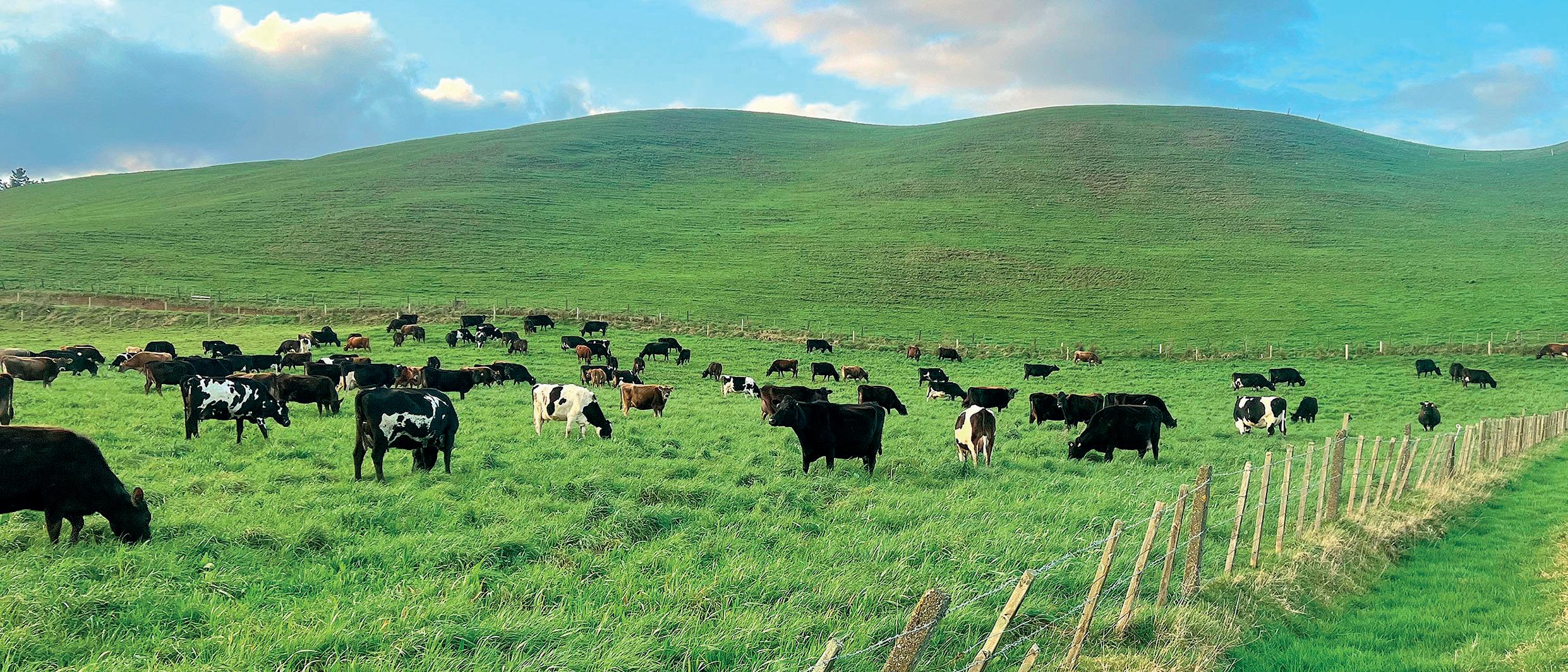
the italians and perennials a er the second grazing, as these have not survived due to drought in the past.”
Milk prices
With milk prices being cut every month, Blair and Penelope say they are con dent their low cost system will enable them to still make a pro t going forward, and therefore reduce the debt.
for the future of this system we have put in place, and I believe the timing has been good with lower milk prices forecast and higher costs going forward.
“It has de nitely been an interesting road ge ing here. For me, in my early sharemilking days, I found the intensive farming systems to be reactive farming, which I found led to a lot of stress for all involved.
done right – were more pro table.
“And now, we have taken it one step further by going organic, which has giving me a new level of excitement for farming.”
e couple’s passion for nature has been demonstrated by their planting of over 40,000 native trees on the farm.
Blair adds: “We have also fenced about 15km of waterways, which is an ongoing project with plenty of community groups involved.” The farm currently runs 340 cows on a pasture-based system.
Blair says: “We are very excited
“As I moved sharemilking jobs, I found the lower cost systems – if
rThe cows are all cross-breds and milked once a day, with a yield of 350kg per cow at 5.64% butterfat and 4.32% protein
rBlair and one full-time worker take care of the cows, while Penelope looks after the calves and relief milking
rThe milk is sent to Fonterra, who are currently paying a milk price of $8.30/kg (£4.08/kg) of milk solids
rAs this farm is EU-certified organic, the Drysdales receive an extra 60 cents (£0.29) per kg of milk solids

JULY 2023 19
028 6774 8377 (NI/UK) / 048 6774 8377 (IRE) www.teemoreengineering.com
Gates
Cubicles
Mats & Mattresses
Drinkers
Feeders
Crushes & Handling
Calf Equipment and more ... TEEMORE ENGINEERING INNOVATIVE LEADER IN LIVESTOCK HOUSING AND HANDLING EQUIPMENT
Tel:
›
›
›
›
›
›
›
Phosphorous can be a fertiliser, a feed ingredient, a problem and a solution, but what does it do for dairy cows and how can farmers ensure they have the right balance in the diet? Ruth Wills reports.
Phosphorous nutrition is all about balance
Phosphorous is an important element for energy in dairy cows. It is a highly reactive chemical usually found in salts and the reactive nature is useful for energy storage and release.
Dr Graham Shepherd, founder of G. Shepherd Animal Health, says: “Phosphorous is vital for energy to power everything in the body; a way to think about it is if glucose is the petrol, phosphorous is the spark.”
And energy is incredibly important for dairy cows. “Phosphorous equals energy at a cellular level and high-yielding dairy cows need energy for maintenance – just to exist, eat, drink and walk around.
“On top of that, they need to produce milk. The energy required to produce 42 litres of milk a day is three times the maintenance level.
“Most dairy cows will milk off their backs at peak lactation, but some cows take it to an extreme due to their genetic programming. So they need four times the resting energy when at peak lactation.”
If there is not enough energy to support peak milk output, the cow will fill the energy gap by using fat
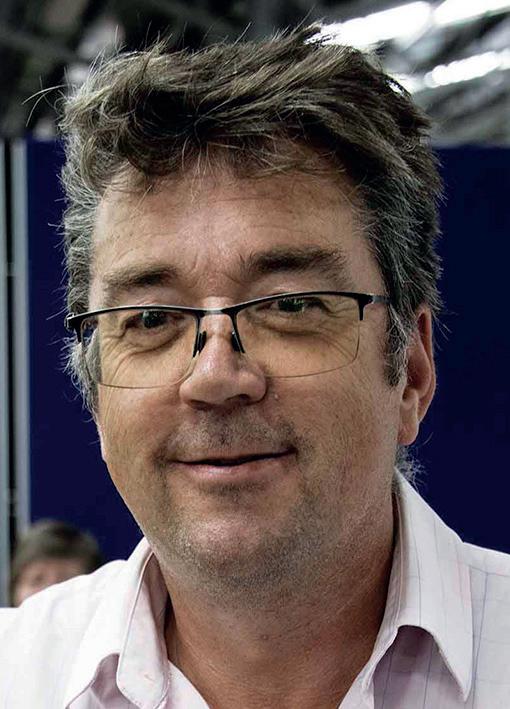
reserves and breaking down muscle, but this can become excessive.
Dr Shepherd says: “This could be due to low feed intake, which could be caused by a lack of feeding space or time, or low appetite.
“Other causes are low-energy forages, a ration which is too low in metabolisable energy or poor balance of energy to protein, which means rumen bugs are not fed properly.
“Finally, it might be due to a fatty liver from previous issues or poor processing of the energy due to mineral imbalances.”
A lack of energy can lead to problems with excessive loss of fat and muscle, lack of vigour, reproduction stress, lameness due to no fat cushion in the hoof, ketosis or milk fever due to an upset Krebs Cycle and poor immunity.
The Krebs Cycle transfers energy from molecules to electron carriers, which will be used in the transportation chain to produce adenosine triphosphate, which carries energy within cells.
When it comes to investigating energy issues, start with late lactation cows and dry cows, says Dr Shepherd.
The calcium to phosphorus ratio is important; they should be fed in line with each other
DR GRAHAM SHEPHERD

“Get the body condition score and rumen preparation sorted here. Speak to the vet and nutritionist, ideally together.
“It is all about intake; ensure cows are getting a balanced, properly mixed and well-presented ration.”
Sometimes something extra is needed, which is when a liquid feed can help, says Dr Shepherd.
“The liquid energy feed is high in energy and, although it is not a substitute to dry matter in the ration, it does support the Krebs Cycle. It can be fed through robots, in out-of-parlour feeders and in rotary parlours, as well as in water or a total mixed ration.”
One of the phosphorous-related issues in cows is milk fever.
Dr Shepherd says: “When cows have milk fever, the problem exists from calcium and phosphorus getting sucked into rapid milk and colostrum production.
“Red water or haemoglobin in the urine is a quite rare low-phosphorus condition, but often fatal, and usually occurs around calving. This is caused
by low phosphorus, resulting in red blood cell breakage.”
When it comes to phosphorous nutrition, it is about balance, says Dr Shepherd.
“The calcium to phosphorus ratio is important; they should be fed in line with each other and there should be enough of each of them. Involve a nutritionist to check you are not over-feeding or under-feeding phosphorus.”
Grain
Grain and grain by-products, such as palm kernel, maize gluten and distillers’ grains, are good sources of phosphorous, but low in calcium, he adds.
Dr Shepherd says: “It is important to consider there are no benefits to over-feeding phosphorous, as it can cause problems with urine stones, cost and pollution upon excretion.”
To understand the already present phosphorous levels, Dr Shepherd advises involving the farm vet to take blood samples.
JULY 2023 20 PHOSPHOROUS
Phosphorous is vital for energy to power everything in the body.
RUMISTART GREEN
An energetic booster to support the milking ruminants





• Improves Feed E ciency
• Limits Ketone Production
• Reduce Risk of Energy Deficiency
• Lower Carbon Footprint
Propylene Glycol (vegetal origin) and Sorbitol
Energy intake
Volatile Fatty Acids and Sodium Propionate
Energy intake
Yeast extracts and Cobalt
Ruminal activity stimulation

To find out more open your camera and hover over the QR code or use your browser www.ruminantad.com
T: 01576 205 480 E: enquiries.uk@kersia-group.com
The use of electrocoagulation to recover phosphorous contained in animal slurry and the benefit this would have on grassland is being investigated at Harper Adams University. Jonathan Wheeler reports.
Europe could completely remove the need to import phosphorous for use in farming if the industry could recover all that contained in animal slurry. And the idea of using electrocoagulation to do this is currently being investigated by a project being run at Harper Adams University.
Work at the University’s 400-cow dairy unit has proved that electrocoagulation can remove virtually all of the phosphate from animal slurry.
And early results from glasshouse and eld grass crop trials suggest the recovered phosphate is in a bio-available form and could be used as a fertiliser.
Trials on small outdoor grassland plots are testing the theory further, Dr Marie Kirby, senior lecturer in animal science at the university, told visitors to an open day examining the project.
Electrocoagulation is a method
Maximising the value of slurry
for removing dissolved and suspended constituents from liquids.
An electric charge is applied to iron/steel electrodes immersed in the screened slurry liquid. e electrodes dissolve at a controlled rate, with the concomitant production of positively charged metal ions in the liquid.
ese freshly formed coagulant particles are e ective ‘binding agents’ which interact with constituents such as phosphates in the liquid, enabling their removal.



Phosphates and other constituents bound to coagulant particles can be readily separated from the liquid and harvested from the solution.
Stripping metals
e technique is already widely used to strip heavy metals from the wastewater leaking from sites like mine workings and land lls.
Harper Adams’ work suggests it could also work in slurry – a chemically more complex material than those it has been used in previously.
Mike eodorou, emeritus professor of anaerobic digestion and fermentation technology at Harper Adams, said: “ e project is building on Research Council-funded work done at the university over the past decade.
“Currently the work is funded by Defra and Innovate UK through the Farming Innovations Pathways competition, which is intended to develop and support a productive, resilient and sustainable agricultural sector.”
e latest project initially aimed to provide a technology solution to help farmers meet forthcoming Farming Rules for Water regulations, while also complying with Nitrate Vulnerable Zone (NVZ) regulations.
e university has a particularly keen interest in meeting these rules, as its entire farm is in an NVZ.
And it saw the potential issues that it might cause dairy or pig farmers with substantial volumes of slurry to manage, said Dr Kirby.
She said: “Back in 2020 we knew
the proposed Farming Rules for Water regulations would have a huge impact for our pig and dairy farmers.
“ ey would either be able to spread less slurry before breaching the regulations or they would need a much greater landbank to spread it on – and for some farmers, that would just not be possible.”
e system now installed at Harper Adams can handle all of the slurry the 400 cows produce – an average owrate of more than two tonnes per hour.
Slurry is rst pumped through a separator to remove large solids and then passes through a microltration unit which takes out the ner solids, with the remaining portion then passing through the electrocoagulation unit.
All of the equipment ts on a neat footprint alongside the farm’s existing slurry handling system, with the electrocoagulation elements and control panels ing inside a container.
e fact the system has only modest power requirements, could be powered by renewable energy and is both modular and scaleable, means it could be used on pre y much any livestock unit, no ma er its size or location, she said.
Any fears the viscosity of ca le slurry might foul the equipment –either blocking it or coating the electric elements – appear to have been overcome.
Dr Kirby said: “We have not had a problem yet and we have been running ca le slurry through
JULY 2023 22
SLURRY
Dr Marie Kirby of Harper Adams.

our systems for months now. In that time, we have treated slurry batches with vastly di erent compositions, not just in dry ma er content, but also in nutrient levels.”
Early results from the growing trials look encouraging.
Four applications are being trialled: raw slurry; a standard arti cial fertiliser regime; the low phosphorous slurry treated through the system; and the phosphate-rich portion extracted from the slurry.
A h set of plots is receiving just water as a control.
ey will all be harvested several times during the year, with grass yield, quality and nutritional value all being measured.
Dr Kirby said the early cuts suggested the phosphate did seem to be bio-available and was helping the plots treated with it to grow more than the others.
Handling slurry
One of the dairy farmers visiting the facility, Tom Halton, Chance Hall Farm, Congleton, Cheshire, said he thought a system could help handle the slurry from his family’s 530-cow herd.
Like Harper Adams, the farm is entirely in an NVZ, and Mr Halton said he saw an advantage in being able to extract phosphate from slurry and then only apply it on elds where it is needed.
He said: “Storing and handling slurry is one of our biggest headaches. We have the added problem that our soils’ phosphate indices are already quite high.
“It would be a real advantage to be able to retain the nitrogen and spread it, but separate out the phosphate so we could choose where to use it ourselves.
“But we are surrounded by arable farming neighbours who need it and if that phosphate is readily available that would be an advantage for them.”

We have not had a problem yet and we have been running cattle slurry through our systems for months now
DR MARIE KIRBY



Your one stop shop for all agricultural sales Search

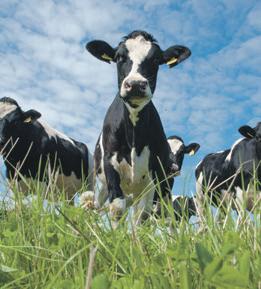



JULY 2023 23 SLURRY www.auctionfinder.co.uk
by sale type, mart, auctioneer or region
The project initially aimed to provide a solution to help farmers meet forthcoming Farming Rules for Water regulations.
Rumen health is integral to cow health, and healthy cows are the foundation of a profitable herd – so how should rumen health be monitored? Anna Bowen reports.
The rumen is one of four chambers of the cow’s stomach and is the largest by volume, accounting for about 80% of the stomach structure, explains Dr Lies Beekhuis of Tivy Vets.
Microbes in the rumen break down most feed stu s through fermentation. is process results in the production of volatile fa y acids (VFAs).
“ e main three VFAs produced in the rumen are acetic, propionic, and butyric acid,” says Dr Beekhuis.
“ ese VFAs are absorbed into the bloodstream via the rumen wall and are converted into other products like glucose in the liver.
“ e proportions of production of these di erent VFAs are impacted by diet and need to be balanced to avoid a negative e ect on rumen function – acetic acid should be the main product of fermentation.
“For example, excessive concentrate intakes can cause a reduction in rumen pH due to the production of unwanted lactic acid
“When concentrates are increased there is also a reduction in saliva production as the amount of rumination will decrease. is reduces its bu ering e ect on rumen pH. ese processes can lead to a more acidic environment and ultimately acidosis.”
Dr Beekhuis says there are several ways to assess whether cows are receiving the correct balances
Fibre is essential for rumen health as it is a food source for rumen microbes DR
How to monitor rumen health

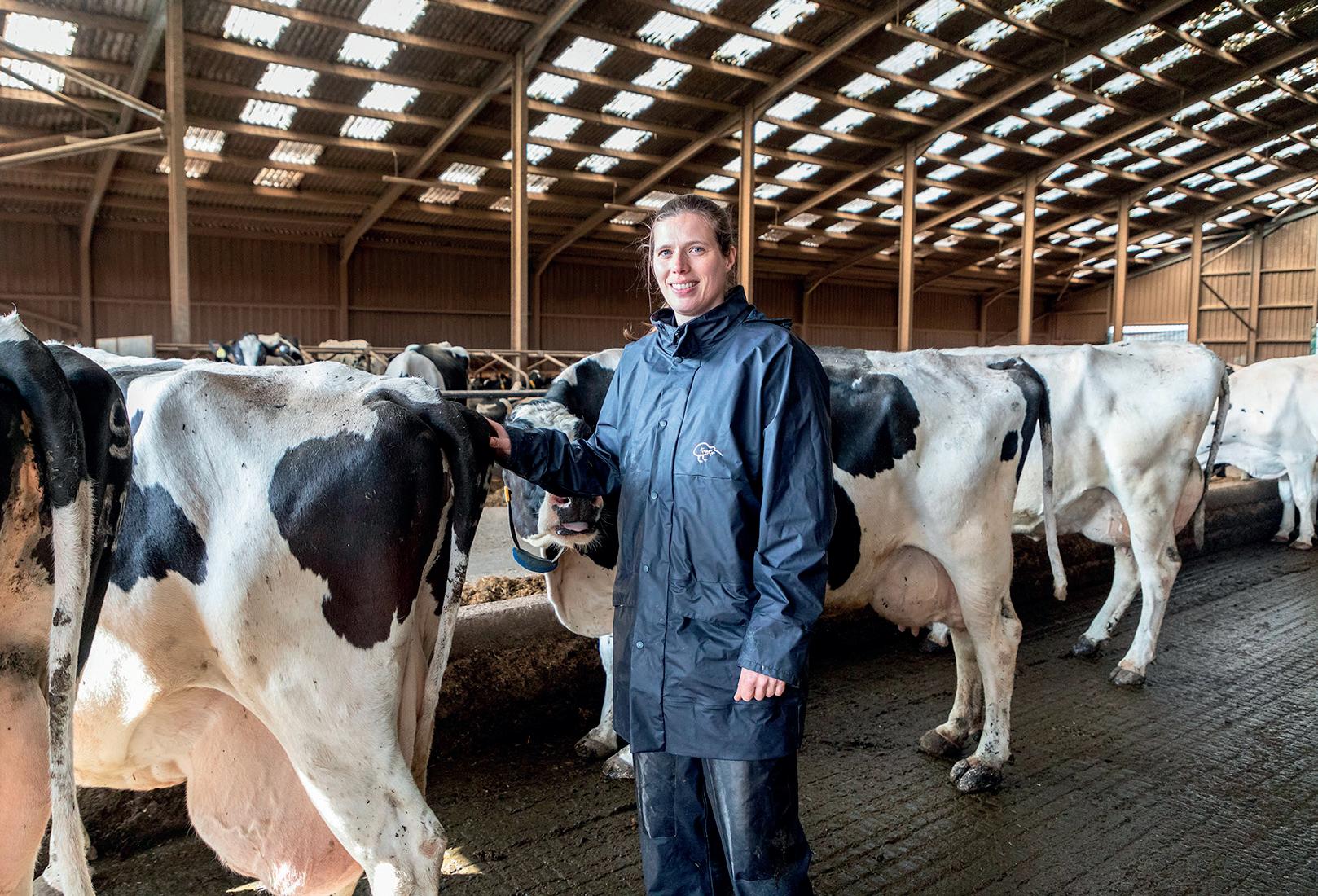
of energy and protein, and to assess rumen health.
Milk urea levels
High levels of rumen degradable protein can result in more urea than the cow can utilise for the production of protein, says Dr Beekhuis. is is indicated by an increase in milk urea levels, which can be used as a proxy for protein utilisation and monitored to make decisions on feeding.
“Milk urea is usually only available at the herd level because it is not a metric included in standard milk recording packages,” says Dr Beekhuis
“However, fat and protein percentages can be monitored for the whole herd and pulled out for individual cows, and the di erence between them can be important for
determining whether the rumen is producing enough energy.”
Dr Beekhuis warns that fat percentages more than 1.5 times higher than protein can indicate the cow has insu cient energy to produce protein and is mobilising her own fat reserves.
“ is di erence applies to Holsteins and can be harder to monitor in Channel Island breeds and cross-breds. With those animals, it is important to monitor your data and react to any changes that might mean there is a problem.”
Rumen fill
Scoring rumen ll is an easy way to determine whether cows are eating enough dry ma er and have a good quality bre mat. Scored one to ve, a lactating cow is ideally at score three, whereas the rumen of a
close-up dry cow needs to be more lled.
“Fibre is essential for rumen health as it is the food source for rumen microbes and so maintains the correct pH and microbe balance. rough fermentation, bre is used as an energy source for microbes,” says Dr Beekhuis.
“Rumen ll is particularly important to monitor in transition cows.
“In heavily pregnant cows the uterus takes up a lot of space, which can reduce the size of the rumen as cows eat less bre. A er calving, there is a lot of space in the abdomen which gives the abomasum the opportunity to ip, leading to a displacement.
“By scoring the rumen and giving cows close to calving access to low-energy, high- bre feed you can keep the rumen bigger and reduce
JULY 2023 24 RUMEN HEALTH
LIES BEEKHUIS
Dr Lies Beekhuis
Forage in faeces indicates that feed has spent insufficient time in the rumen
DR LIES BEEKHUIS
Scoring rumen fill is an easy way to determine whether cows are eating enough dry matter. the risk of abomasal displacements.” e lower the rumen ll score in the transition period, the higher the risk of the cow su ering a negative energy balance in early lactation. is could have an impact on ge ing the cow back in-calf.
Faecal consistency
Like rumen ll, faecal consistency can be scored on a scale.
“It is not an absolute science as it is variable, but it can give a good idea of protein digestion, bre intake, and overall health,” says Dr Beekhuis.
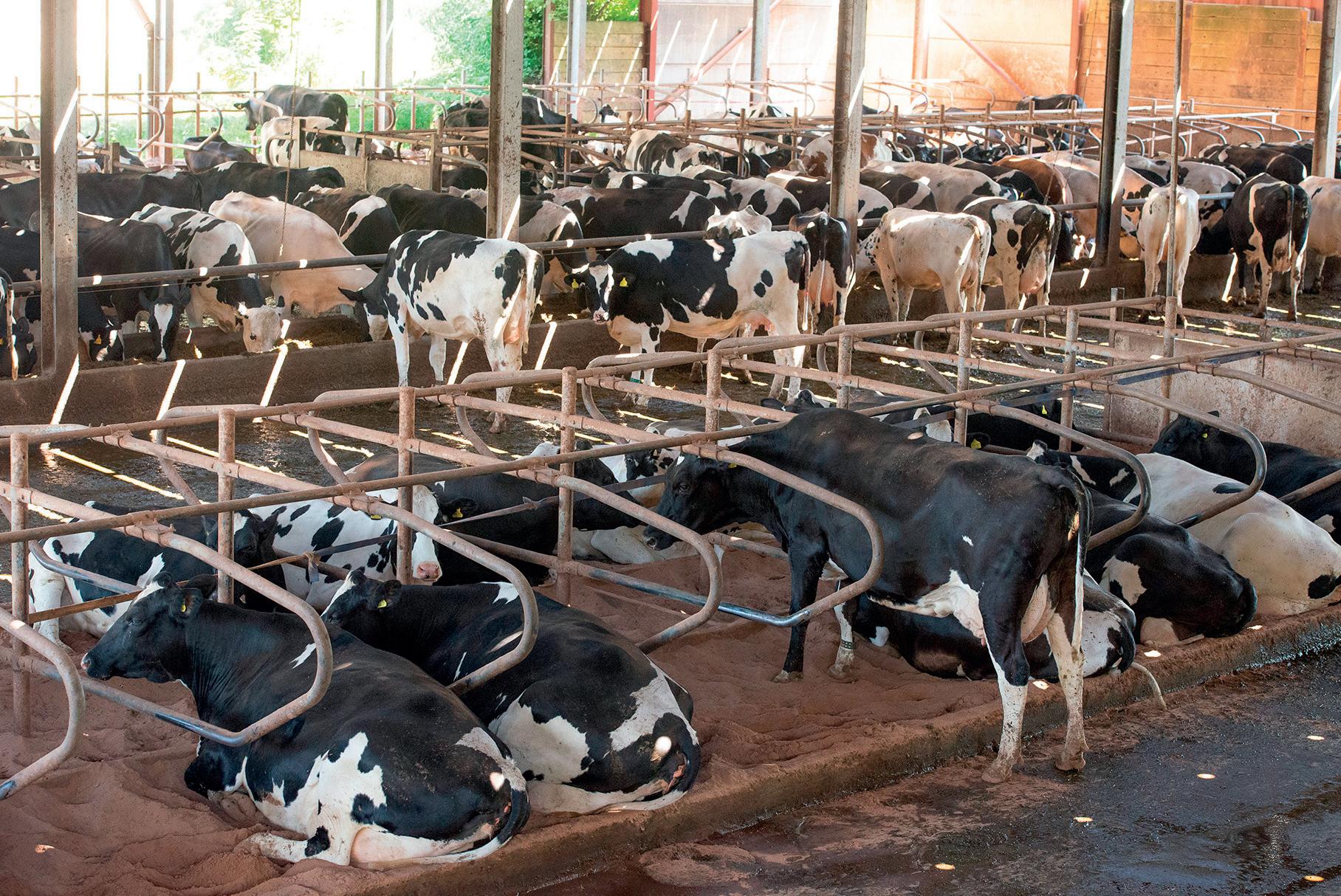
“Loose faeces can indicate high levels of rumen degradable protein or insu cient bre intake. Loose faeces tend to happen with feed stu s that have a high throughput to the rumen.
“In dry cows, dry faeces is not unusual, but in a lactating cow it can indicate issues with the diet; not
enough protein for optimal milk production, for example.”
Close examination of faeces to look at particle size can help monitor rumen health.
“Large pieces of forage in faeces indicates that feed has spent insucient time in the rumen. is means the cow is not utilising it properly
SPONSORED CONTENT
Managing wholecrop and maize
Wholecrop and maize can be a valuable addition to any ration, but attention to detail both pre- and post-harvest is key.
Jamie Morton, of Krone, lists a few vital checks to make before heading into the field to harvest wholecrop.
He says: “Setting the header pressure correctly provides sufficient float without bouncing, thus avoiding soil ingress or knife damage and preventing premature bed wear. Adjusting the drum bottom and blower correctly optimises crop flow and blow, resulting in better crop transition into trailers. Consider installing a grain saver plate to stop grain loss below feed-rolls.
“For crops at the soft cheese growth stage, a crop processer will be needed on the harvester to enable starch digestion by the cow.
“Ensure the processor roller gap is aligned to the value shown on the harvester screen to avoid misinterpretation
Sponsored by

in the cab of the actual setting, resulting in uncracked grains. Chop length will need to be adjusted according to the dry matter [DM] value of the wholecrop to ensure good consolidation in the clamp.”
Peter Smith, of Volac, suggests wholecrop tends to be more difficult to consolidate as it is generally harvested at a higher DM than grass silage.
He says: “Deciding what type of feed is required will dictate when wholecrop is harvested. Farmers looking for bulk will mow at 30-40% DM.

“Most harvest it at 40-50% DM to balance digestibility with good starch levels.
“At 50% DM, wholecrop is a high fibre feed and a processor will be necessary to crack the grain to allow the cow to digest it properly. Additives such as Ecocool or Ecocorn help prevent heating in wholecrop silage. Fill the wholecrop evenly in the clamp with layers no thicker than 100-150mm to aid consolidation.
“Place a layer of fresh grass at least 0.5 metres deep on top of the wholecrop to deter vermin and add weight before covering carefully and weighting down.”
Zinc and magnesium are the two most widespread nutrient deficiencies found in maize crops, according to Yara’s Philip Cosgrave.
He says: “Maize is high yielding, but only if the nutritional demands of the crop are met. The critical stage for nutrition is when the crop reaches six leaves and rapid plant development begins.
“Using foliar applications bypasses the


and will not be ge ing all the nutrients from her feed. is could be due to the food not being processed properly for the cow, or the cow sorting a ration.
“Any sign of grain can indicate waste and/or insu cient fermentation. When this occurs, it can be useful to rethink the cow’s diet.



root system and ensures fast and efficient absorption of nutrients and other bioactive compounds through the leaf.
“Results from Yara’s 2022 maize trial demonstrated the positive effect from combining foliar nutrition and a biostimulant on crop performance, increasing DM yield by an extra 2.5 tonnes/hectare.
“YaraVita BIOTRAC contains zinc, magnesium, potash and phosphate, stimulating root growth. The biostimulant in the product helps protect the crop against biotic factors, such as drought and cold temperatures.”

JULY 2023 25
out more about Campaign for Better Silage at farmersguardian.com/ bettersilage, or scan the QR code
Find

Over 17,000 Wagyu-sired calves were born in England, Wales and Scotland last year.

The UK’s leading Wagyu beef business, Warrendale Wagyu, has revealed it is planning to more than double its production by 2025 due to continued demand and the thriving market. Katie Jones reports.
Two-year target for doubling production
Yorkshire-based Warrendale Wagyu currently processes 130 ca le a week, which is equivalent to 105,000 burgers and 18,000 steaks, but has ambitions to take this number to over 500 ca le a week within the next two years.
Speaking recently at the company’s inaugural two-day conference held in Shropshire, Tom Richardson, managing
British Wagyu is the fastest growing breed in the UK – up 30% in 2022
TOM RICHARDSON
director at Warrendale Wagyu, explained the business had grown signi cantly since it was formed in 2018 and was now looking to secure more farm partners at every stage of the process – from dairy farmers to calf rearers and nishing farms.
“It has not been an easy ve years, and we have had to contend with Brexit, Covid-19, the war in Ukraine, a rise in veganism and sustainability challenges,” he said.
But he added that, despite this, the past ve years had seen the company successfully growing its critical mass of farming partners to over 500.
Now, the focus would be on quality – in particular, ‘ nessing the marbling’ a ributes of Wagyu beef – as well as creating more value for the products by accessing the right markets and developing the right products, and focusing on industry net zero targets.
He said that while there was already a ‘good story to tell’ around a reduced carbon footprint, thanks to using dairy cross wagyu and its ability to utilise the full animal, it was also important to use data gathered over the last ve years to make further improvements.
Market
When questioned about the potential market for these products, Mr Richardson said there was still high demand and they would
always ensure they had a market for the number of animals coming through their supply chain.
He said: “British Wagyu is the fastest growing breed in the UK – up 30% in 2022 – and we are con dent that, together, we can increase this even further over the coming years.
“Ultimately, our goal is to protect the premium quality, while growing the full supply chain sustainably.”
Detailing its consumer home delivery service, Mr Richardson
More about British Wagyu
JThe British Wagyu Association was set up 10 years ago, and was the first ‘brand new’ breed society to be formed in 20 years.
British Cattle Movement Service figures for 2022 show there were over 17,000
Wagyu-sired calves born in England, Wales and Scotland. Of these, 15,933 were crossbred (sired by a Wagyu bull) and 1,150 pure-bred or fullblood. This forms a total 17,093-head of Wagyu animals, compared to 13,457 born in 2021.
JULY 2023 26
The importance of data
JTom Richardson explained that advances have been made to the collection of carcase data through the use of Meat Image Japan (MIJ) carcase camera technology.
He said: “We have been using this for over a year now, whereas previously the carcases were being graded manually.”
The MIJ mobile camera
said Warrendale Wagyu was now delivering between 200 and 500 parcels each week directly to UK homes, and that over a quarter of these customers (28%) were 25- to 34-year-olds.
He added the products were gaining exposure to the important ‘TikTok generation’ by ‘selling the meal, not the meat’ through digital marketing strategies.
Nick Rose, buying director at Aldi, said while Wagyu products
can assess marbling score, firmness, meat and fat colour, and ribeye area among other traits.
Images translated into data and recorded via an app can then be linked back to the Breedplan Performance Recording system to aid breeding decisions and genetic improvement.
were not currently available at all stores, the supermarket wanted to increase distribution across the UK, and also wanted to explore export opportunities to Europe.
However, he added it was important that ca le numbers were increased in a sustainable way.
He said: “We have been gentle with our advertising of our Wagyu products so far, as they have not been available in all stores, but our advertising will


Warrendale Wagyu is aiming to protect the premium quality of its beef, while growing the full supply chain sustainably.

increase as we get the products into more stores.”
Buying habits
He said he did not envisage people’s buying habits of ‘premium’ products like Wagyu beef to be a ected by the recent hike in cost of living.
“In periods of recession, we

usually see people trade down, so they will buy a premium tier of steak rather than go out to eat at a restaurant.
“
e rst Wagyu products launched in our stores during the Covid-19 pandemic, and we are con dent that we still have enough support behind the range.”



















JULY 2023 27 CONFERENCE
Autumn grass reseeds have an important place in reseed programmes, but caution is needed if there is not a break in grass crops. John Spence, forage crop manager at Limagrain, says the pest burden can be massive – particularly in an older grass ley.
“We cannot rely on pesticides to keep the pests at bay any longer. But it is also be er practice to rotate crops,” he says. “Apart from helping to control the likes of frit y and leatherjackets, which can be particularly damaging to grass crops, it helps to improve soil condition.”
Rotations are a good way of improving weed control, and they will also clear up residual turf in longer term leys, making it easier to create a good seedbed for the new ley.
“And a forage crop for autumn and winter increases home-grown forage supplies and can take the pressure o housing and feeding,” says Mr Spence.
“If a sward can be ‘out of grass’ for six months at least, then the life cycle of these pests is broken and there will be li le chance of any residual problems. Sowing a brassica crop removes the food source for these grass-borne pests and can turn an otherwise unproductive ley into a high value feed, before leaving the eld ready for reseeding in the spring.”
ose on a mixed farm have the
Growing tips
JLimagrain estimates growing costs for forage rape at £408 per hectare (£165 per acre) if drilled after grass. Free-draining light loam with a pH of 6 to 6.5 is ideal, but forage rape has the ability to perform well across a broad range of sites and soil types. There is also flexibility in drilling date.
Mr Spence says: “Crops for winter grazing will produce the most yield if sown at the end of July, with yield potential declining with later sowing dates. But forage rape crops
Following grass with grass can be a risky business, but a brassica filler to break the pest cycle and give home-grown forage a high feed value can be a win-win. Dairy Farmer reports.
Make the break with a brassica


option of rotating grass and arable crops. is will also break the pest cycle in grassland and, depending on the crop, leave the ley ready for reseeding the following year.
But for those with purely livestock units or where an arable rotation is not an option, Mr Spence says rst or second cut silage could be followed by a break crop, and for dairy farmers, forage rape – possibly mixed with stubble turnips and kale – is a good choice.
sown in September can still give significant production.”
A firm, fine seedbed is best for sowing the crop, and rolling after sowing will consolidate the seedbed and hold in moisture better. It will benefit from farmyard manure, slurry pre-sowing, or 60kg to 90kg of nitrogen and 25kg each of phosphorus and potassium.
“If the crop looks hungry after four or so weeks, it may benefit from a top dressing of 75kg N/ ha, but on most dairy farms this is unlikely to be required.”
Forage rape is sown between May and August so it can follow second or third cut silage or the main grazing period in late summer, he says.
“It is a fast-growing crop and ready for grazing in 12 to 14 weeks. So, if the crop is sown in early August, ca le can be grazing it by early November.”
He also highlights forage rape’s long shelf life.
“It will ‘sit and wait’ even until a er Christmas with li le deterioration in feed value. It can withstand frosts –it is one of the most winter-hardy forage crops available.”
e crop’s feed value, particularly its crude protein content, is also impressive at 19% to 20%. Dry ma er averages 12% to 13%, with an ME of 10 to 11 MJ/kg of DM.
Mr Spence says: “What else can provide this amount of protein for grazing through winter in such a short time? With high feed prices,
many farmers are looking for alternatives – particularly for dry cows or youngstock.
“And using a mixture of forage rape, stubble turnips and kale will add extra energy and increase the forage output.”
Varieties
When it comes to varieties, Mr Spence’s advice is to look for a combination of yield and winter hardiness. He says good disease resistance is also key, as a healthy plant is more palatable and more tolerant of frost damage.
“Varieties have been developed speci cally for mildew and alternaria resistance – two diseases which can have a major impact on varietal performance and intakes.
“ ere are signi cant di erences in these important traits between di erent varieties, so it is important to make the right choice.”

Forage rape is a good choice of break crop for dairy farmers.

JULY 2023 28 GRASSLAND
ROTATIONS
John Spence
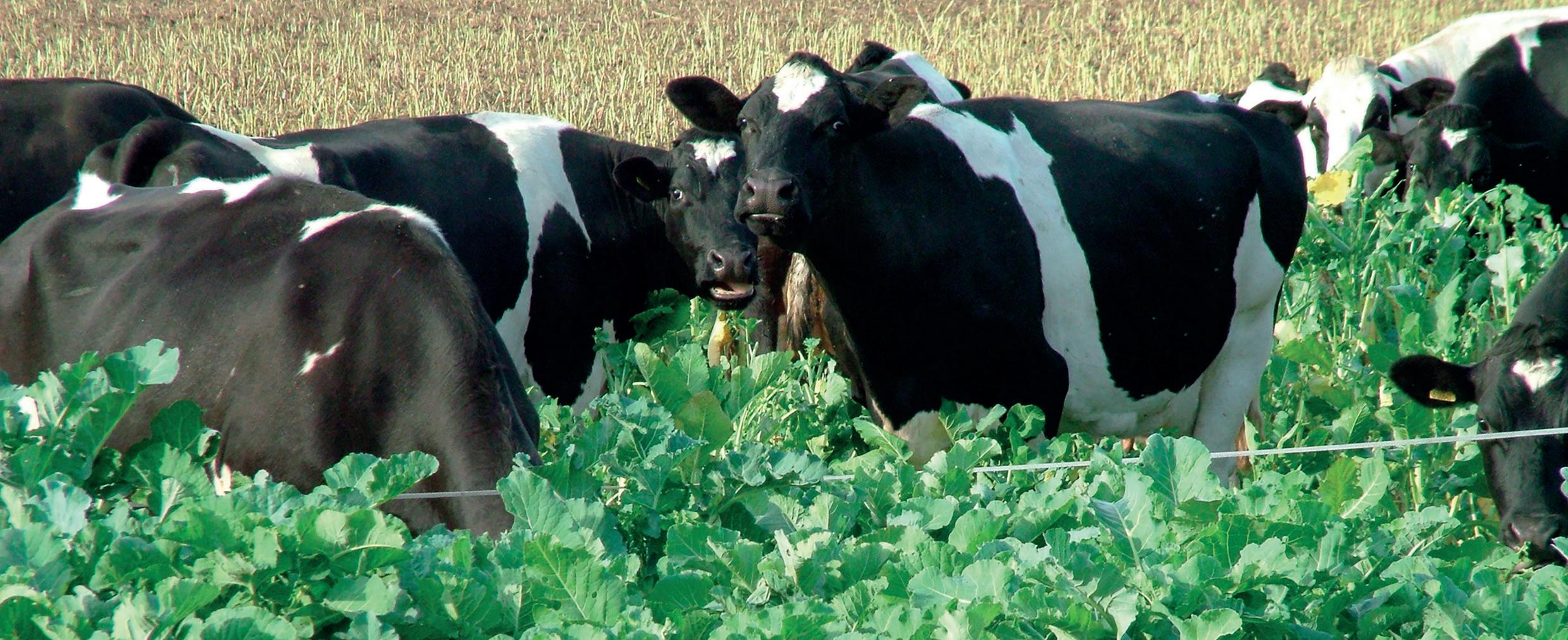

Limagrain has been running trials at its UK site and testing forages, including forage rape varieties, every year since 1998. “We compare our own varieties with others on the market, and also bring in new improved varieties,” says Mr Spence.
“We have seen signi cant improvements in yield and feed value among the more recent forage rapes now on the market, as well as be er disease resistance. New varieties have a higher proportion of healthy leaf, and this is where much
of the improvement in feed value is.”
Results from the 2022 eld trials put the forage rape hybrids Interval and Unicorn in rst and second place, ranking 14% and 10% higher than the control variety Emerald on relative DM yield.
New trial site
JLimagrain UK has introduced a new trial site in the East Midlands to extend its testing of grass and forage crops.

“Both of these top forage rapes have the best disease resistance among all varieties on trial, but the variety Hobson has the highest winter hardiness ranking, so it highlights the need to pick the variety to best suit the farm,” says Mr Spence.
SLURRY LAGOON LINERS AND FLOATING COVERS
SLURRY LAGOON LINERS AND FLOATING COVERS
SLURRY LAGOON LINERS AND FLOATING COVERS
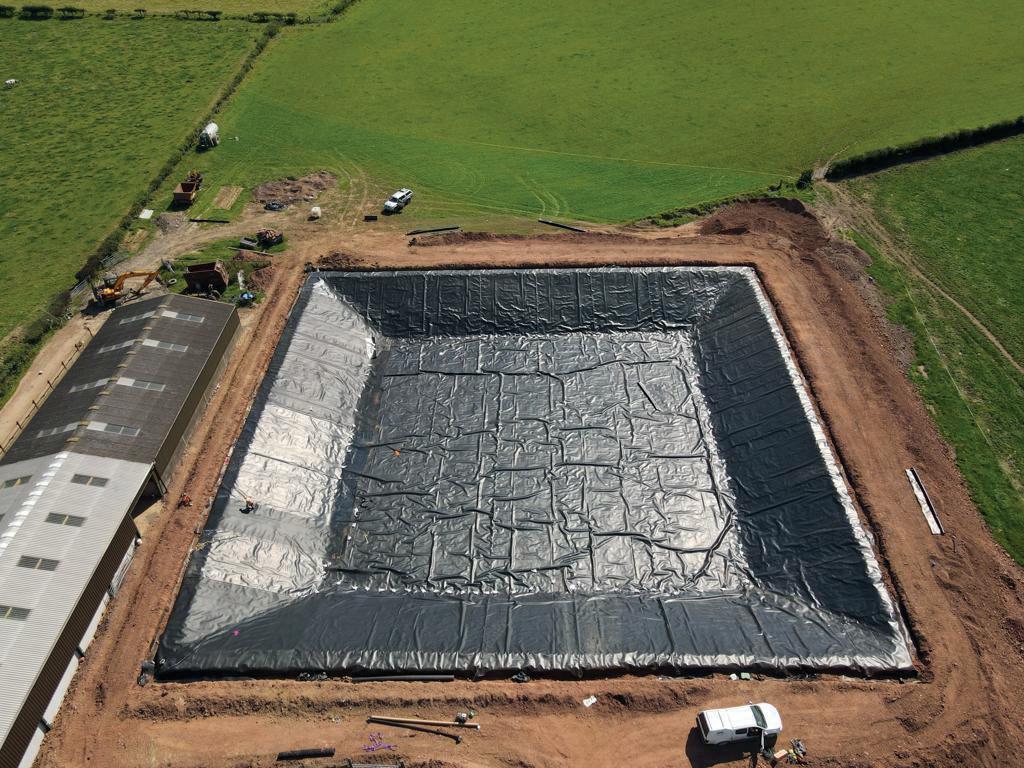
Each year new varieties and mixtures are introduced, and Limagrain tests these under UK growing conditions alongside more established varieties of fodder crops. An extensive range is trialled, including fodder beet, forage rape, kale hybrids, stubble turnips and swedes, plus grass seed varieties and grass seed mixtures.
“The new site will allow us to

OVER 30 YEARS EXPERIENCE
OVER 30 YEARS EXPERIENCE MATERIALS & INSTALLATION
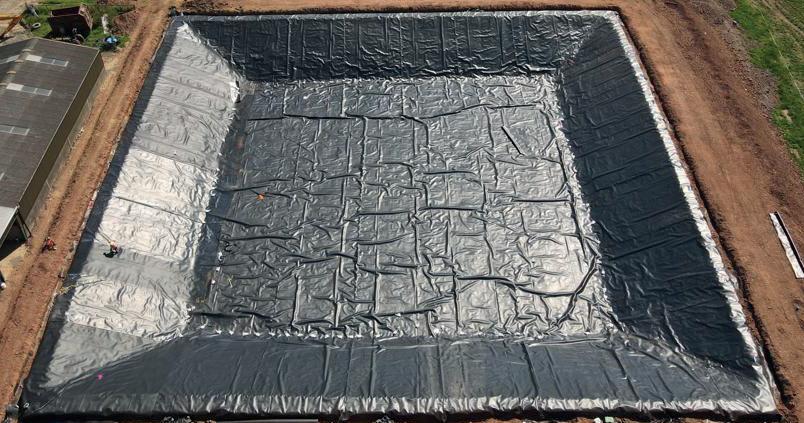


WATER STORAGE IRRIGATION RESERVOIR

test new varieties and species and look at innovative solutions to producing home-grown forage as well as continuing our longterm forage crop trials, which already includes 14 consecutive years’ worth of trial results for some species,” says Mr Spence.
“The site is open to distributors and farmers, and we make the results widely available so we can see how new varieties shape up. It allows farmers to take advantage of new varieties and grow the crops with confidence.”





Tel: 01745 823674 Mob: 07739 711208
Tel: 01745 823674 Mob: 07739 711208
Email: sean@seancarrlining.co.uk
Tel: 01745 823674 Mob: 07739 711208
Email: sean@seancarrlining.co.uk
www.seancarrlining.co.uk
www.seancarrlining.co.uk
Email: sean@seancarrlining.co.uk
www.seancarrlining.co.uk
Materials meet EA and SEPA requirements, installed and fully tested by TWI / CSWIP CERTIFIED TECHNICIANS Covers comply with EA and SSAFO legislation
Full UK & Ireland Coverage PONDS LAKES
Materials meet EA and SEPA requirements, installed and fully tested by TWI / CSWIP CERTIFIED TECHNICIANS Covers comply with EA and SSAFO legislation
Full UK & Ireland Coverage













JULY 2023 29
OVER 30 YEARS EXPERIENCE MATERIALS & INSTALLATION GUARANTEED
meet EA and SEPA requirements, installed and fully tested by TWI / CSWIP CERTIFIED TECHNICIANS Covers comply with EA and SSAFO legislation
UK
Materials
Full
& Ireland Coverage WATER STORAGE IRRIGATION RESERVOIR PONDS LAKES
John Spence advises farmers to look for forage rape varieties with a combination of yield and winter hardiness.






SUSTAINABLE FARMER OF THE YEAR
Mark Means is a big believer in the power of what implementing small changes can bring to a farm business. Emily Scaife nds out more about his approach.
Mark Means confesses he’s the opposite of what most people imagine when they think of a sustainable farmer. But, regardless of his own perception, the judging panel for the British Farming Awards thought otherwise as he was named Sustainable Farmer of the Year at the 2022 British Farming Awards.
“To win the award was a huge surprise,” Mark says of the moment he found out he had won.
“I am the opposite of what most people would say is a ‘sustainable farmer’ - I’m not a tree hugger.
“A lot of local people have told me they’re doing similar things to me on their farm. The award is for my farm, but it also showcases what many farmers are doing as standard.
“It’s great the award went to someone who is still ploughing once in a while and hasn’t planted catch crops or cover crops on a lot of their land. Because it’s not all about those things – the resources we’re looking after include electricity, water, the soil and people.
“We employ local people and give them the right training so that we can all keep moving forwards.”
Mark’s farm operates under the name J.S. Means and produces crops
A word from the sponsor
XLloyds Bank is delighted to be able to support the Sustainable Farmer of the Year category in the 2023 British Farming Awards.
We are committed to helping farmers, landowners and agricultural businesses transition to a more sustainable future and are excited to learn about the innovations being made by this year’s entrants.
and vegetables at Terrington near King’s Lynn. Mark works alongside his wife, Sharon, and four other employees to grow produce for most of the main supermarkets.
In addition to his own land, Mark has two longstanding shared farming arrangements with nearby farmers, bringing his total farmed land area to 1,000 hectares.
“Some of our land grows continuous wheat, some is in a wide rotation of eight years producing potatoes, sugar beet and peas,” he explains.
Prior to returning to the farm, Mark spent time as a potato buyer for Morrisons and a potato merchant in North Yorkshire, giving him a unique insight into what the supermarkets want and how to work with them.
The crown jewels
Mark’s approach to farm management and sustainability has always come down to what is best for his soil.
“We farm on some of the best land in the country and the soil is our crown jewels – our aim is always to look after it as best we can,” he says.
“Every decision or purchase always comes down to whether or not it will it help the farm; will it improve safety, will it boost efficiency and will it be kind to the soil? Anything that meets that criteria, we will do – like Sir David Brailsford’s Sky cycling team, we believe in small, incremental changes as they all add up.”
Mark has always been interested in sustainability.
X
SUSTAINABLE PRACTICES
XInstalled irrigation in 2004 in order to supply recycled water for potato crops
XLeaf Marque certified since 2002
XCarbon auditing the business using the Cool Farm model for the past 10 years
XHas three small wind turbines and 130kW of solar to sustain and reduce energy for 5,000t of cold storage and irrigation
XCurrently exploring options for battery storage
“It’s the right thing to be doing – I wholeheartedly embrace it,” he says.
An early adopter of the Leaf Marque, Mark’s farm has been certified since 2002 and he has been carbon auditing the business using the Cool Farm model for the past 10 years. He believes his efforts have boosted biodiversity, and he hopes populations of tree sparrows, bumblebees and marsh harriers will continue to rise on the farm.
Located just a mile from the sea, installing irrigation on the farm in 2004 meant Mark could recycle water, which proved particularly useful when producing high-quality potatoes for supermarkets.
“Excess winter rain is recycled from farm drains and wellpoints, and we get water from there rather than putting additional pressure on the drinking-quality water,” he explains.
The farm also has three small wind turbines and 130kW of solar to
We’ve got to know the answers to our questions before we all race towards catch crops and cover crops on certain soil types and embrace methods such as direct drilling
Mark Means
sustain and reduce energy for 5,000 tonnes of cold storage and irrigation.
Knowing when to say no
Although Mark is passionate about sustainability and trying new things on the farm, he says winning the award has given him the confidence to question whether certain practices would suit his soil type and demand more information before embracing new methods.
“It’s given me the confidence to challenge the direction we’re heading in and question if it’s the right thing for our soil type and our commercial cereal rotation,” he explains.
“I still naively believe that the UK should be growing a lot of its own food, to the high standards we’re currently growing it. So, when it has felt as though the Government is trying to force us to do certain things that go against that, I now have the confidence to highlight the potential issues.
“We’ve got to know the answers to our questions before we all race towards catch crops and cover crops on certain soil types and embrace methods such as direct drilling.”
Mark describes himself as an ‘inquisitive person’ which has enabled him to make changes that have boosted yield and quality while using the minimum amount of inputs.
“I’ve always enjoyed looking at different techniques and I like what I’m seeing with regenerative
britishfarmingawards.co.uk
Vox Conference Centre, Birmingham Thursday, October 19, 2023 JULY 2023 30
This award recognises farmers who are safeguarding the land for future generations and are embracing sustainable farming practices which work in harmony with the environment.
will be proactively reducing your carbon footprint whether that be through exploring regenerative
biodiversity, soil health, water management, stockmanship and renewable energy to name but a few. ENTER OR NOMINATE
more information on the category and the British Farming Awards, visit britishfarmingawards.co.uk ENTER OR NOMINATE NOW
You
agriculture,
For


J.S. MEANS
XMark Means farms 1,000ha near King’s Lynn, just a mile from the sea
XGrows wheat and sugar beet alongside potatoes and peas, for most of the main supermarkets
agriculture, companion cropping and cover cropping. But it doesn’t suit everyone,” he says.
“You need to be careful what you’re doing because you might not be able to do it. Or you might find that it could be detrimental in five to 10 years’ time. You could introduce a species you’ve never grown before that could host or increase certain fungi or bacteria.
“It’s serious and there is a lot we don’t know yet.”
Many will be able to sympathise with Mark’s uncertainty as it’s a feeling most farmers are used to. And, with the past 12 months proving particularly
XIn addition to his own land, Mark has two longstanding shared farming arrangements with nearby farmers

says. “I question why we can’t just produce enough in this country.”
challenging and unpredictable, making long term business decisions is more difficult than ever.
“We’re in a period of limbo at the moment and it’s frightening,” Mark admits. “Farming sustainably must mean farming profitably too and this year, after taking into account electricity and labour costs, we’ve made a loss on our potatoes.
“I don’t know what we will be doing next year right now. I don’t know which fertilisers I should be ordering. The wheat price looks as though it is dropping considerably, so do I want to keep growing that? Or should I go into more environmental
The profitability of the farming business has a direct impact on which sustainability projects Mark can pursue.
XMark works alongside his wife, Sharon, and four other employees or stewardship schemes, because at least they provide a steady payment? I just don’t know.”
“Making a loss isn’t sustainable,” he says. “If we don’t make any money from the farming side of the business, we can’t do any of the other things we love doing. I love planting hedgerows and sowing pollen and nectar areas – I do it because I want to, not because there’s any money in it. We like doing it for the people who live near us, the environment and the wildlife.”
As well as farming sustainably, Mark is a passionate food producer –something he fears isn’t valued by the present Government.
“It’s tough when food production is your raison d’etre,” he says.
“We are going to run out of food and we’ll then have to import more expensive, lower quality food,” he
The future
Despite the current obstacles, Mark hopes to continue blending sustainability and food production within his business moving forwards.
“One of the farmers I’m in a shared farming arrangement with is really interested in beef production,” he says.
“As well as producing very good, sustainable beef we would put the organic matter back on our land and I would like to have more grass in the rotation. It’s an exciting prospect for both of us.”
He is also exploring the role battery storage could play on the farm, which is particularly pertinent given the past year’s rise in energy prices.
“We’re always looking to make incremental improvements so we’re learning about battery storage at the moment,” he says. “We’ve still got a lot to learn – but it’s exciting.”
Sponsored by 31 JULY 2023
Left to right: Awards night host Patrick Kielty, with award winner Mark Means and Bob Kendal from 2022 award sponsor Alltech.
Making a number of investments to add value to its milk and cut down on energy costs has helped a Northern Ireland farm estate become more sustainable. Chris McCullough reports.
Adding value and reducing energy costs
Located near Bangor in Co Down, Clandeboye Estate has over 800 hectares (2,000 acres) of farmland and woodland; it is one of the last and largest privately-owned estates in Ireland.
Now held in a Trust, the estate had previously been run by Lady Du erin, the late Marchioness of Du erin and Ava, who passed away in 2020.
e estate has invested £3.5 million within the last 10 years constructing an anaerobic digestion (AD) plant and, more recently, a yoghurt production facility.
e farm itself extends to 271ha (670 acres), which is broken down into 188ha (465 acres) for grass, 48ha (120 acres) for forage crops, 28ha (70 acres) of maize harvest and 6ha (15 acres) of wild ower meadows.
Under the expertise of estate manager Mark Logan, the dairy

farm runs a pedigree herd of 70 Holstein cows and 30 Jersey cows, both under the Clandeboye pre x.
Mr Logan, who has worked on the estate for the past 32 years, runs a team of three other farm sta .
He says: “Our Holsteins are averaging 10,005 litres per cow per year at 4.28% bu erfat and 3.35% protein, and the Jerseys are just over


7,236 litres at 5.39% bu erfat and 3.95% protein.”
Seven years ago, the estate built its own 250kW AD plant with an investment of £1.5m, and a payback of six years.
Mr Logan says: “ e AD plant and the cows utilise all our acreage on the farm. Actually, the AD plant is hungrier than the cows, as we feed it around 15 tonnes of grass silage, forage rye and forage maize per day. e cows receive the same forages, but the grass for the AD plant must be chopped ner.
“All the farmyard manure and slurry from the ca le, plus the whey and the rst washings from the yoghurt factory, are also fed to the AD plant.”
Gas turbine
e gas produced from the plant powers the gas turbine, which generates electricity. is power and heat is used on the farm, estate buildings, and provides hot water for the yoghurt factory.
“ e estate is using around 40% of the electricity we produce, and the rest is sold to the national grid,” says Mr Logan. “In terms of heat, we
The estate is using around 40% of the electricity we produce, and the rest is sold to the national grid
pump it from the plant to the mansion house 1km away, and to the yoghurt factory.”
Farm succession is a bit of a taboo subject to discuss on any farm, but Mr Logan, who is 64, says the issue is being addressed.
“We need to seriously look at this over the next two years,” he says. “I will retire soon and we need to nd new sta to carry on the work here. We have already employed a new person to help look a er the cows, but more new sta will be required.”
Back in 2007, Clandeboye Estate launched its own range of yoghurts under the guidance of estate owner, the late Lady Du erin.
At that time, the yoghurt was made in rented factory premises in the nearby town of Newtownards, but in 2022 the estate invested £2m developing its own production facility right beside the farm.
e yoghurt factory processes about 8,000 litres of milk per day, ve days a week, from the dairy herd, including some from a neighbouring farm.
About 20 sta work at the factory, which produces a full range of natural, Greek style, avoured and
JULY 2023 32 SUSTAINABILITY
PICTURES : Chris McCullough
MARK LOGAN
The yoghurt factory produces a full range of natural, Greek style, flavoured and layered whole milk yoghurts.


layered
Yoghurt
Bryan Boggs, general manager of Clandeboye Estate yoghurt, says: “ e milk is taken fresh from the farm each morning and is processed and incubated slowly overnight to produce a rich and creamy natural yoghurt. Some of this natural yoghurt is then strained through
cheesecloth in the traditional way to produce our authentic award-winning Greek style yoghurt. We are quite unique in carrying out this process.
“We only do whole milk yoghurt, and do not skim the milk or use milk powders.”
As well as producing its own range of yoghurts, Clandeboye Estate supplies other retail outlets with produce under their own
branding labels, such as Starbucks, Aldi and Lidl’s Deluxe range.
“At the moment we are producing 50% under our own labelling and 50% for other brands, although we do insist Clandeboye Estate is mentioned on the other brands too,” says Bryan.
“About 60% of our business is in the Republic of Ireland, so we really need to ensure the access to that market is maintained.
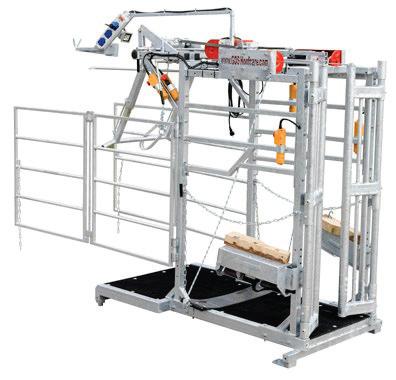






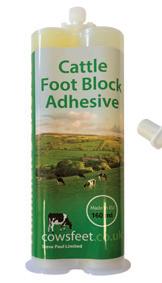


Farm facts
rThe herd is milked twice a day in a Boumatic eighta-side parlour that was installed in 2002
rThe yoghurt factory produces about eight tonnes of yoghurt per day, five days a week, and is growing at about 30% per year
rThe yoghurt pays the farm the current going milk price plus an extra two pence per litre
“We are also entering the market in GB in the future and require this new Windsor Framework to work for us. Northern Ireland is at an added advantage if we can have dual access to both the UK and EU markets.”

From farmer cattle crushes to wooden blocks, we have everything you need to keep your cows' feet healthy!


JULY 2023 33 Prefer to speak to a human? Give us a call on 01963 824448
JOHNNY MILLER, LANCASHIRE LAMENESS WORKSHOPS October 22 £125 per person Steve Paul Limited
• TRAINING •
ORDER
3PM
you
excluding
ring us
you’d
"Thank you to Steve and his team for an excellent and very quick service and very competitive prices every time, thanks!”
The UK's leading cattle foot care company TRIMMING
SUPPLIES Free next working day UK mainland & Ireland delivery
BY
when
spend £100 online
VAT Make your life easier with our Electric Farmer Crush Do
if
like more information!
Cowsfeet advert Farmers Guardian 200x130mm March 2020.indd 1 14/02/2020 09:40
whole milk yoghurts for both the retail and food service markets.
Clandeboye Estate Farm is well-known for its Holstein and Jersey breeding.
Search #Farm24 on social media
As Dairy Farmer’s sister title Farmers Guardian launches its flagship campaign, we will look at areas in to achieve positive outcomes. In this article, we take a look at how those in the industry are working as
Supporting each other in
In an increasingly digital world, the art of conversation can now be expressed through an array of technologies and there is sometimes no need to see another person face to face.
But farming is still one of the most communal sectors there is, and that ‘love thy neighbour’ spirit is something we must and should not lose, especially given the nature of the job.
Long hours and isolated working conditions could mean farmers do not see another soul for weeks.
Our auction marts are still, of course, at the heart of the industry; our agricultural shows remain top priorities for thousands on the calendar and, in times of great change and intense pressure, the need for peer support is crucial.
Agriculture faces a unique set of pressures, from prices to Government policies, to lack of labour, financial worries and uncertain markets.
Farmers, however, take it upon themselves to make sure that other rural dwellers have somewhere to go or someone to turn to, knowing how imperative that cup of tea and a natter can be to someone living out in the vast British countryside.
Uniting
Coming together is one of our industry’s best abilities, and someone who has created a social space for those struggling to do so is Tom Ware, who set up Just Talk Agriculture.
Tom, who is just 20 years old, has had quite a journey himself. Recently, one of his close

friends and his brother were involved in a serious car crash.
Many in the farming community will have heard of Len’s Light, the campaign set up in memory of young farmer Len Eadon, who took his own life on New Year’s Day in 2022.
Tom had worked with Len the previous summer, and the news of his passing hit him hard.
“I have struggled with mental health, after coming to terms with hearing Len had taken his own life and, more recently, I lost a best friend,” says Tom, who is from the Lincolnshire/Nottinghamshire area.
“I became extremely low and luckily I had a few really good people there to talk to and gain support from.”
Just Talk Agriculture was set up after Len passed away and it now has almost 4,500 followers on Facebook.
Tom’s goal is to raise awareness about mental health in farming and Just Talk Agriculture is aimed at the younger community within the rural sector.
Tom says: “We work alongside and with the Farming Community Network and the Yellow Wellies Mind Your Head campaign.
“We incorporate well-known people within the farming industry to push the message that it is okay not to be okay.
“If someone sees their idol openly say this, then hopefully they will take that away from watching the video and that we will be able to get that message to the people that need it most.
“A total of 94 per cent of UK farmers under the age of 40 rank poor mental health as the biggest hidden problem facing farmers today.
“It is a growing problem in the







industry and, due to this, it needs to be spoken about before it is too late for some people.
“Working long, lonely hours in the isolation of a machine cab gives those manifesting thoughts time to manipulate.”
Starting conversations is key, and even if the conversation is not about how they feel, a bit of connection can make a real difference.
Tom says: “Having that communication between farmers can change someone’s life.
“Hopefully we can get the message across to wider communities, and the
helplines are there to support the more vulnerable and those susceptible to poor mental health.
“If you see someone, maybe they are quieter than usual, maybe they have suffered a loss, they are struggling to pay the bills, they maybe just are not themselves. Just gently ask them ‘how you doing mate?’
“Because who knows, they might just need that support or chat.”
Around the marts
There is also action from the community, including auction marts. As the key hub to the farming industry,



Visit farmersguardian.com/Farm24
Tom Ware has set up Just Talk Agriculture.
JULY 2023 34
Long hours and isolated working conditions sometimes mean farmers do not see another soul for weeks.
which the farming community is working collectively one to support each other in times of need.
times of need


#Farm 24 is back



the marts are most likely where you will be able to catch a farmer to talk about anything from their mindset to their physical health.
Field Nurse is a rural charity based in Lancashire, establishing itself at Gisburn, Skipton, Brock and Clitheroe auction marts.
The idea is that if farmers will not take time away from their jobs to get a health check, then the nurses and professionals must go to them.
It has been a great success. Although you might be there to have your blood pressure taken, you might just get chatting and feel a little brighter or even give a small insight into your mental state.
There are also communal setups, such as the Rural Coffee Caravan, which has been around for 20 years and became a registered charity in 2008.
Based in Suffolk, it exists to help people in rural communities feel less isolated, providing people with the chance to meet up and engage and improve the lives and well-being of people out in the countryside who may feel lonely.
It is positive to witness so many caring individuals, groups, charities and social media pages being set up to ensure farmers have a place to feel like they can openly talk
about what is going on. And our industry is being recognised for such work too.
In May, Sam and Emily Stables, from Herefordshire, received a Points of Light Award from Prime Minister Rishi Sunak for their dedicated work to try and break down the stigma around mental health in the farming community.
Sam, who was named Farmers Guardian Farming Hero at the British Farming Awards in 2020, has always wanted to be a farmer, but struggled with the isolation which affected his mental health. The couple went on to set up We Are Farming Minds, a charity to help others with similar struggles.
Emily says: “We are very honoured to have won The Points of Light Award.
“The more that poor mental health within the farming community is recognised and talked about, the more the stigma surrounding it is broken.
“The farming community is a close, supportive community, but sometimes this can go against farmers talking to other farmers about their mental health.
“It is brilliant that our hard work has been recognised and will hopefully help us to reach out to more people who are struggling and put support in place for them.”
August 3-4, 2023
AGRICULTURE’S biggest digital campaign –#Farm24 – is gearing up to be the biggest and best yet and we need your support.
Sponsored by Morrisons, 24 Hours in Farming showcases the role of British farmers to the general public as the nation’s most trusted producers and as custodians of our iconic countryside.
On August 3-4, we are asking farmers and industry organisations across the UK to unite once again and take farming to the masses by sharing what your typical day in farming looks like and using the #Farm24 hashtag, tagging @FarmersGuardian and @Morrisons so we can see you.
To pledge your support ahead of this special day and find out how to get involved, visit farmersguardian.com/Farm24 and share on your social media that you are proudly backing this much-loved campaign.


Search #Farm24 on social media
farmersguardian.com/Farm24
Visit
JULY 2023 35
This special feature takes a closer look at the options for rejuvenating swards, including reseeding options, timings and variety choices.
Before speaking to your seed merchant, it is important you know your ‘hopes and dreams’ for the grass you want to grow, says Janet Montgomery, agricultural manager for Barenbrug UK. ose ‘hopes and dreams’, she says, will in uence every subsequent decision and will ultimately allow selection of the most appropriate variety.
Although the end result it is rarely one variety, she adds.
“We favour seed mixtures, which deliver a more exible, more resilient sward.”
First consideration, Ms Montgomery suggests, should be how long the eld will be in grass, then the livestock it is intended to support.
“Are you looking for maintenance, gain or production? Cut or graze? How does this eld t the farm’s overall fodder ow?”
Intended sward lifespan is generally the most important factor in any variety selection decision, she says.
And another decision point is heading date.
She asks: “Do you want grass which jets away in early spring? Or something which maintains its quality through the rst cut of silage? “ ink about heading dates across the farm. It is best to have a mix. Plan them sequentially if you can so spring management is not too hectic and you do not face an everything-everywhereall-at-once moment.”
By considering and identifying these factors – their relevance to your farm, your system and your production objectives – it is easier to si the options, says Ms Montgomery.
“At a basic level, your eld’s intended lifespan indicates which species – Italian ryegrass, perennial ryegrass, hybrid, Westerwolds –suits your needs.
“A short-term ley of two to three years makes Italian ryegrass
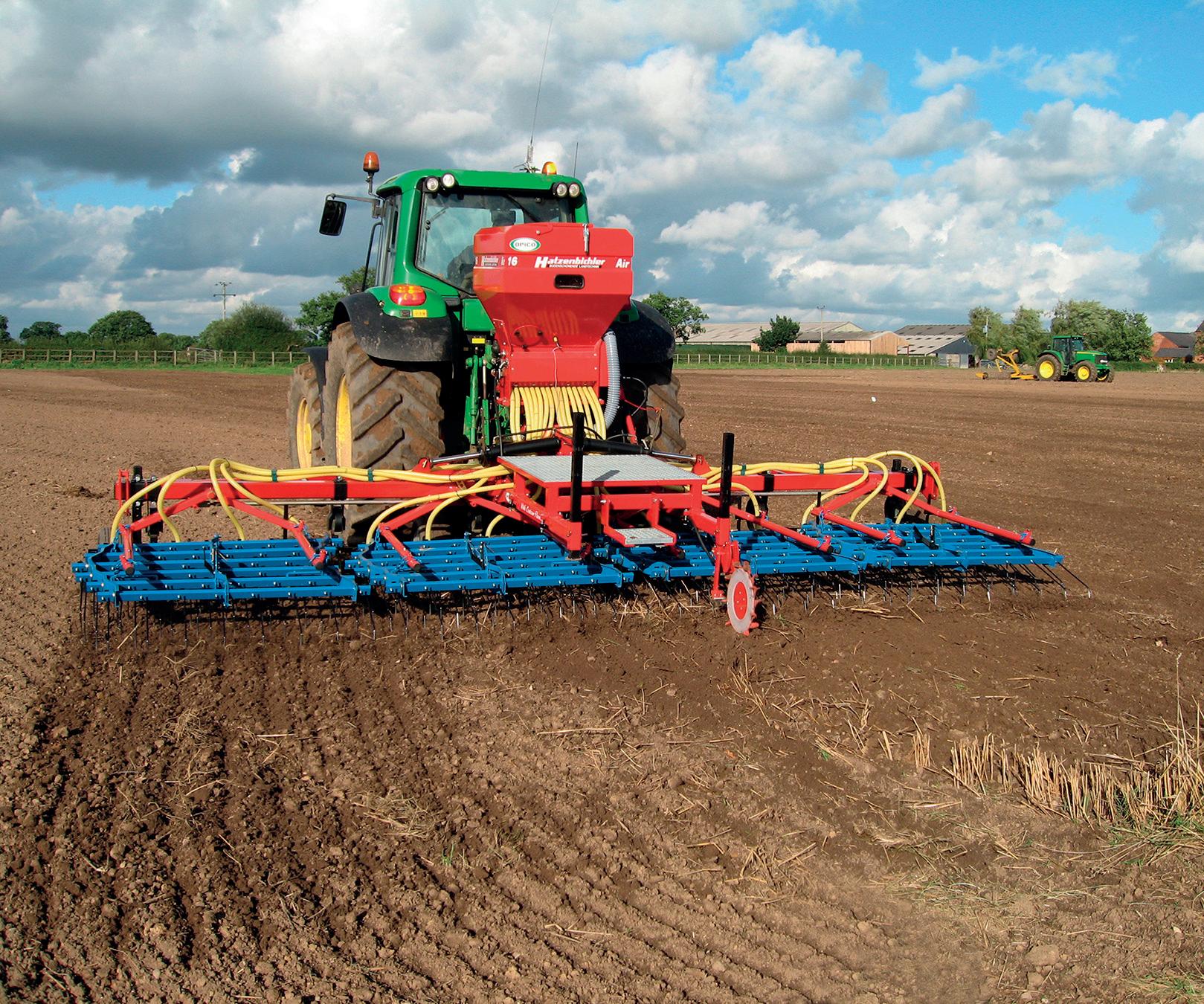

Intended sward lifespan is generally the most important factor in any variety selection decision.
Rather than just accepting what your seed merchant has to sell, it is important to first talk about your grass-growing needs when planning new leys and swards. Dairy Farmer reports.
Considerations for variety choice
your likely bet. Long-term commitments favour perennial ryegrass, while hybrids fall in the middle.”
Many growers shy away from ge ing into deliberation or discussion about diploid or tetraploid varieties, Ms Montgomery says, but it is important.
“I nd it is usually the point at which eyes glaze over, and yes, it can seem esoteric. But it really is not and each type has key characteristics.
“Get beyond the terminology
and it is simple. Diploid ryegrasses possess two sets of chromosomes in each cell, whereas tetraploids have four. at is all there is to it.
“It is the characteristics you should be concerned about, rather than the genetics.”
Ms Montgomery says the e ect of the extra sets of chromosomes is to increase the size of the plant’s cells – larger tetraploid cells have a higher ratio of cell contents to cell wall material.
She says: “Bigger cells, more cell contents, more of the nutrients like sugars and starches needed for good digestibility is what you will nd in tetraploids.
“Generally, they provide be er feed quality and those extra sugars can o en improve palatability, which encourages higher intake.
“Diploids, conversely, have smaller cells and lower water-soluble carbohydrate content. Diploids also display higher tiller densities
JULY 2023 36 GRASSLAND ESTABLISHMENT
Starting the discussion
MS Montgomery sets out three broad options to help identify appropriate characteristics for differing production goals. She says: “Use these suggestions to define your needs and discuss with your seed merchant.”
FOCUS
ON CONSERVED FEED
JFor those seeking high output, high quality conserved feed, Ms Montgomery suggests a hybrid tetraploid ryegrass as a mainstay in a mixture.
She says: “Bar Forage Hybrid 4x4, for example, relies on Bannfoot hybrid with diploid supplements.
“That will give you four cuts in a year and a three- to five-year rotation.”
QUALITY WITH FLEXIBILITY
JSome farmers want a solution which does not commit them to a fixed outcome, Ms Montgomery says.
“A mixture which is suited to both forage and grazing use can include clover alongside a blend of intermediate and late-heading perennial ryegrasses.
“Galgorm and Seagoe feature on the 2022-2023 Recommended Lists,
and, despite smaller leaves, generate higher and thicker swards.”
Ms Montgomery points out that this makes a diploid sward more competitive against weeds, more forgiving under grazing stress, more resilient to harsh weather and more persistent over time.
“Now, while some people will say that tetraploids are better nutritionally, that does not mean diploids are a poor choice.”
The advantage of sowing a mixed sward, says Ms Montgomery, is the ‘best of both worlds’.
She says: “Benefit from improved tetraploid digestibility, while diploids endow the sward with longevity and resilience.”
Resilience will become increasingly important, Ms Montgomery says, owing to climate change.
“More drought-like periods in spring and summer, wetter winters and greater swings in temperature – all these things take their toll on a grass sward.
“Barenbrug has its own breeding operation in the UK, where we are breeding UK varieties to suit UK condition. We are already thinking about what will be needed in the grass varieties of the 2040s, such as deeper rooters which are more drought resistant and increase soil biomass for greater carbon capture.”
topping them for highest grazing and conservation yield, respectively.”
PERENNIAL PASTURE
JPermanent pasture enjoys a loyal following, says Ms Montgomery.
She says: “It is ideal for those who want productive grass without getting too involved with grass management.”
She suggests Ballyvoy, a diploid PRG with strong spring growth, and Ballintoy, a tetraploid PRG with strong seasonal consistency, as strong choices or varieties with similar characteristics.


JULY 2023 37 GRASSLAND ESTABLISHMENT For more information visit www.ecosyl.com Grow more milk Trust Ecosyl to make your silage more productive Copyright © 2023 Volac International Ltd. All rights reserved.
Janet Montgomery



Proven Precision
Achieve germination rates of up to 96% the highest germination rate in comparison to other systems

The Vredo range of overseeders offer a quick, precise operation, saving you up to 80% in time and fuel compared to renovation through ploughing, cultivating, levelling, sowing and rolling. Call 01260 224 568 or visit www.campeyagriculture.com
Herbal leys offer multiple benefits to health and resilience in sheep and beef systems, but what about dairy? Ruth Wills looks at some preliminary trial work into the topic.
Research looks at benefits of herbal leys
Most studies on the impact of herbal leys on dairy farms have been completed in New Zealand; currently, there are none from the UK. is is something that Innovative Farmers, along with Farm Net Zero, are trying to address. As a result, they are embarking on a research project into the bene ts of herbal leys for dairy, with some pilot studies already underway.
Speaking at an Innovative Farmers event which discussed the project, Dr Daniel Enriquex-Hidalgo of the University of Bristol Veterinary School says that, a er continually using monoculture crops like ryegrass for years, farmers were turning to herbal leys to improve drought resilience and soil structure.
He said: “We know how to manage monocultures properly, and through intensive genetic selection we have ltered traits for certain conditions.”
However, he added that the industry was changing.
“Climate change and sustainability have become a major issue for everyone. Global warming is
Global warming is a reality and the things we took for granted with monocultures are now uncertain
a reality and the things we took for granted with monocultures are now uncertain.
“We cannot rely on weather conditions; droughts are normal now, the cost of inputs have been skyrocketing and it is unlikely that they will drop dramatically. I am not sure we can call monocultures a resilient tool anymore.”
Productivity
Bene ts of herbal leys include increased productivity and an extended grazing period, Dr Enriquex-Hidalgo said.
“ e di erent root systems of the various species can take
JULY 2023 38 GRASSLAND ESTABLISHMENT
AGRICULTURE
DR ENRIQUEX-HIDALGO
Farmers are turning to herbal leys to improve drought resilience and soil structure. PICTURE : Farlap Photorgaphy
Herbal leys research pilot study
Meet some of the farmers involved
JAndrew Brewer was the first farmer to join the pilot, having grown chicory and herbal leys for two years at Ennis Barton, Fraddon, Cornwall.
“I wanted to see if there was a major difference between herbal leys and straight ryegrass swards,” he said.
He split his Jersey cross herd into two groups of 250 cows, each with 16 hectares (40 acres) of a ryegrass sward or a herbal ley.
“I have two separate milk bulk tanks, so although it has been more work it has also been rewarding,” he said.
And he has had good results. “We initially found that we had 5% more milk from the cows grazing the herbal ley, but lower fat and protein. But if I then added the two together there was virtually no difference.
“The cows are a lot more settled and it made a big difference last year in the drought; the mixed swards kept growing and the ryegrass started going backward – it has given us a lot more resilience.”
Mr Brewer also stopped using bagged nitrogen in preference for slurry and dirty water.
“We had the same dry matter production; in the first week of May, the ryegrass was yielding 100kg of dry matter per hectare per day, and the mixed species swards were doing 160kg.”
JAnother farmer involved in the pilot study is Phil Kent, who farms close to the sea near St Minver, Cornwall. Due to his location, Mr Kent experiences his fair share of drought.
He said: “The herbal ley
advantage of the nutrients in the soil and prevent nutrient losses. Overall, these characteristics give improved resilience.”
But there are a lot of questions
works well here; it seems to keep us going through the dry summers. I have farmed in partnership with my aunt and uncle for 18 years – we have not yet had a summer without a burnt-off spell, so we are aiming to get ourselves as far through the dry spell as we can.”
He grazes 300 cows, comprising a mix of Jersey, Irish Friesian and Norwegian Red, rotationally across the farm.
“The cows are fully housed for no more than three months, then out for as long as possible.”
He aims to reseed 10% of his grazing ground a year, and is gradually converting his monoculture grass leys to herbal leys.
“The herbal leys suit us down to the ground; there is not a lot of soil - we go from top soil to shillet - but the chicory will mine through it, and we have gained ourselves 10-14 days of grazing.
“The leys react a lot quicker when we do get rain – probably down to the improved soil structure.”
It made a big difference last year in the drought; the mixed swards kept growing
ANDREW BREWER
about how herbal leys can t into a dairy system, so Innovative Farmers and Farm Net Zero are aiming to answer some of these queries with trial studies.



JULY 2023 39 GRASSLAND ESTABLISHMENT To find out what is available to view in your area and book a free demonstration contact us today: https://gofurtherwithyourforage.kuhn.co.uk/contact/ KUHN balers and combi balers are on tour. KUHN is touring the UK with a selection of combination, fixed, and variable chamber balers. The tour will go to every corner of the UK and offers the opportunity for you to book a free demonstration. KUHN will be offering a variety of products including the: GO FURTHER with your forage FB + VB Round Balers FBP, VBP and i-BIO+ Combination Balers 80cm + 120cm Large Square Balers BALER DEMO TOUR Be Strong Be KUHN KUHN GFWYF Baler Demo 2023 254x89 Dairy Farmer.indd 1 14/06/2023 15:04
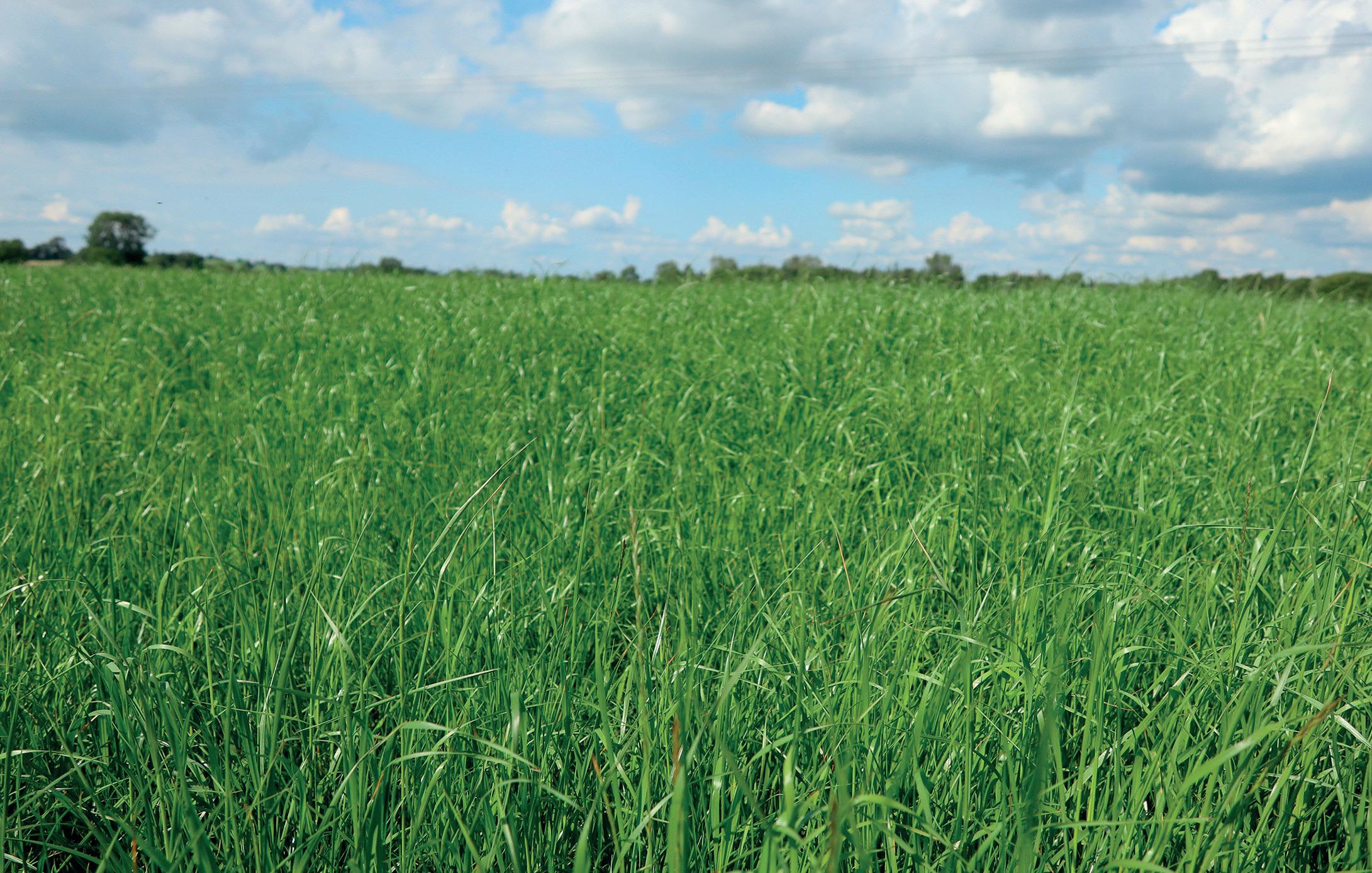
The challenging growing conditions of recent years have led to an increase in sales of rapidly growing one-year leys as a quick fix to boost forage stocks, but are these masking deeper problems in the UK’s grassland? Dairy Farmer reports.
Are high-performance short-term leys masking longer term grassland issues?

Much of the country’s grassland is in urgent need of serious renovation following several years of challenging conditions, says Jim Juby of forage specialists Horizon Seeds.
While short-term solutions such as overseeding have played a key role in helping dairy producers alleviate the worst of the forage shortfalls, they could be creating a false sense of security for many, he believes.
He says: “We have seen a signicant increase in sales of Westerwold grasses and tetraploid-based grass mixes for overseeding in recent years and there is no doubt they have played a vital role for many.
“But this last spring also saw a
25% drop in sales of mainstream mixes for full reseeds and so there is a real concern that producers have cut back on investment in longer-term pasture management and this could be storing up problems for the future.
“On dairy farms where waterlogging in the winter has damaged swards or the lack of rainfall in early summer has e ectively killed o the most productive species, producers really need to bite the bullet this autumn and focus on full reseeds.
“It is not an easy decision when cash ow is tight, but home-grown forage remains the most cost-e ective feed you can produce, and investment in grassland management to build resilience into long-term production is never a false economy.”
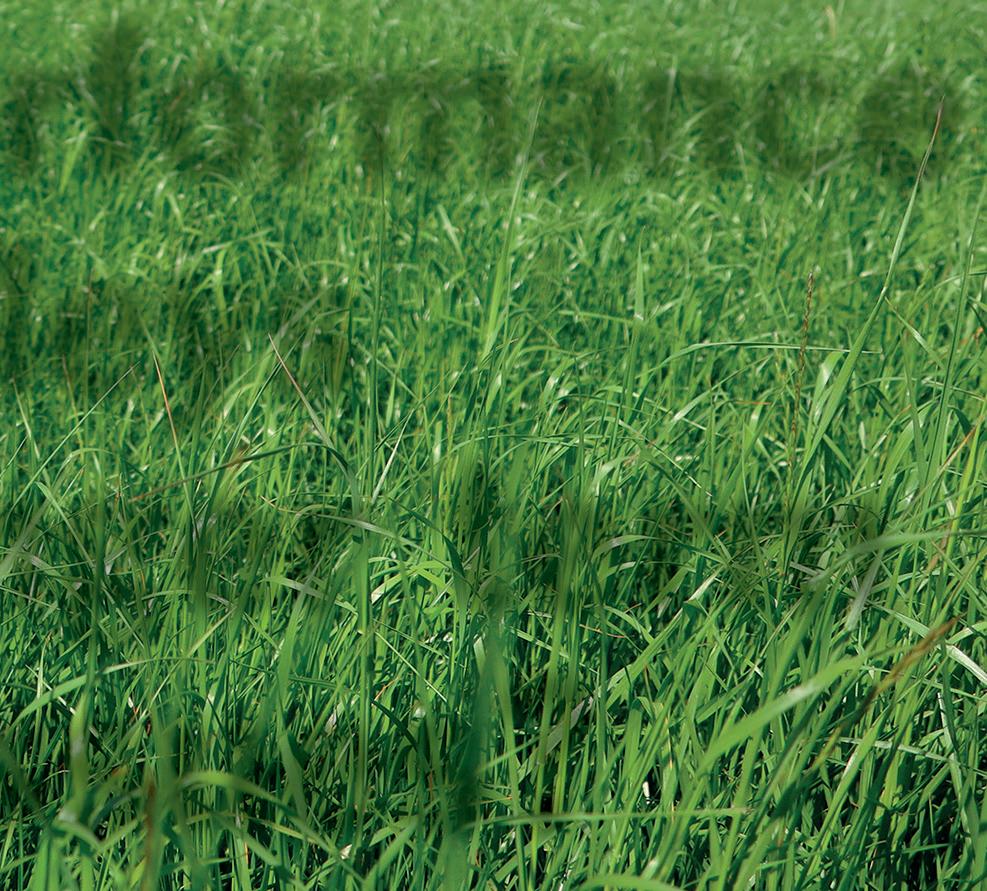
Mr Juby adds that delaying the decision to reseed at least the worst-hit parts of your grassland this autumn could have signi cant implications with inevitably higher costs to remedy the situation later and increased reliance on increasingly expensive bought-in feeds in the meantime.
Carried out properly reseeding has the potential to deliver a 20:1 return on investment, but at a cost of £400 to £500/ha, growers need to make sure they are making the right decisions to stack the cards in their favour, he says.
Nitrogen
“One of the biggest improvements comes from greater nitrogen utilisation e ciency.
“A modern perennial ryegrass will give a 50% be er response to nitrogen than something like Yorkshire Fog or most of the other weed grasses that thrive when reseeding is delayed or swards are damaged.
“So, if you do not address your grassland issues in the short-term, you will e ectively be wasting half the nitrogen you apply and that is a cost few businesses can live with, especially with the high fertiliser costs of recent years.”

grass mixes used, Jim Juby says.
“Mixes are much more robust than single species varieties and have a greater resilience to disease threats as well as be er ability to cope with diverse growing conditions.”
Dairy Farmer July 210mm wide by 139 mm high (5mm bleed)

Building the highest levels of risk mitigation into leys and ensuring producers get the most out of inputs, puts the focus on the
A good starting point is to make sure all the varieties in a mix are on the current Recommended List, he advises.
“A lot of advances have been made in recent years especially in critical areas such as performance consistency and response to nitrogen inputs.
“Understanding what is in your mix will also help you establish what the likely milk yield you can expect from your grass and allow comparison of di erent options to be made.
“A good quality silage ley should be capable of producing 18-20t DM/ha and a grazing ley should be
JULY 2023 40 GRASSLAND ESTABLISHMENT
with the UK’s largest independent manufacturers of liquid fertiliser. Offering 24/7 dedicated support to UK grassland farmers, with national coverage and local service CONTACT US TODAY Call 01526 396000 Visit www.omex.com
Go Liquid
Jim Juby
Prioritise protein production
JLow silage crude protein values have resulted in particular problems for highoutput dairy producers in recent years and this needs to be factored into the autumn reseed equation, says Grainseed’s Wilson Hendry.
“High yielding grass swards need a lot of nitrogen to maintain protein levels as volumes increase, so you need to think about this when selecting the ideal reseed mix. Protein is at least as important as energy.
“Clover has fallen from grace recently as it presents a conflict of interest for producers. It
not too far behind this. At current price levels this is worth about £2,000/ha with 25 -30% dry ma er (DM) silage worth £110/t DM and a yield of 18t/ha.


can provide a valuable addition in grass protein, but it is also vulnerable when it comes to sward herbicide applications. Some varieties can also be severely affected by sclerotinia, too.
“But there are now some very aggressive growing red clover varieties available as well as high performance white clovers with high nitrogen-fixing potential.
Clover
“A good two-year red clover ley, for example, should contain 25% of Merviot red clover which shows very good resistance to Sclerotinia. For longer-term options, the Aberclaret red clover in the best
“Many of the worn-out and damaged leys now prevalent on UK dairy farms would only be capable of producing 30-50% of this, so the economics of delaying a
four-year red clover leys has outstanding persistence which can deliver high production for more than five years.”
Mixes containing white clover can also have significant advantages over straight grass options, he adds.
“Having 30% white clover in your sward could fix the equivalent of 150kg N/ha per year while also increasing the digestibility of the sward, leading to higher grazing intakes. The resulting silage also has a much higher protein content than forage based purely on perennial ryegrasses which can lead to 20% extra milk production.”
reseed simply do not stack up.”
Achieving all the bene ts of a full reseed means investing in good quality seed, he points out.
“Your grassland is the heart of
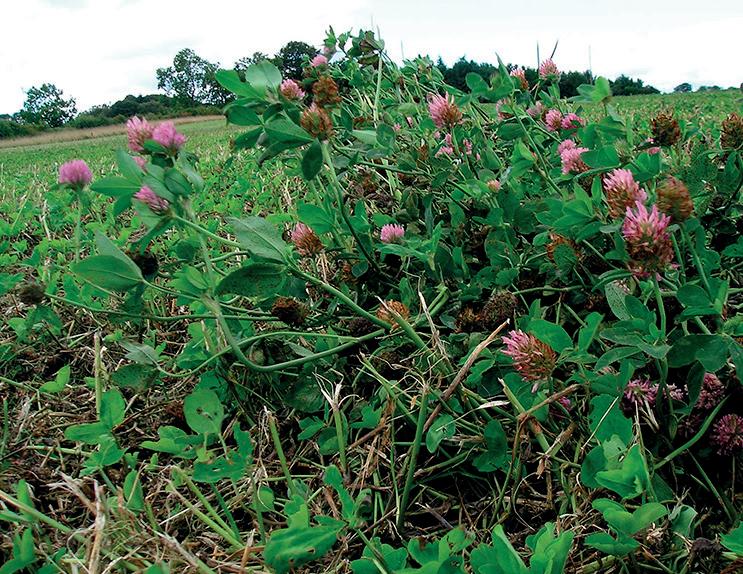
your production system so it is pointless taking shortcuts and opting for lower quality seed or mixes.
Advantages
“You may save some money in the rst year, but you are likely to lose out on many of the advantages that come in subsequent years.
“Short-term leys are a great strategic option in di cult conditions, particularly when a full reseed is not possible due to weather or ground conditions, but they are not an alternative to a longer-term reseed.”
TAKE CONTROL OF MAIZE SILAGE QUALITY



MAGNIVA PLATINUM MAIZE inoculants contain a unique combination of proven bacteria and enzymes providing complete flexibility on clamp opening times, plus:





GRASSLAND ESTABLISHMENT
mj/t MORE energy 250 UP TO % MORE DM 15 % LESS YEASTs & MOULDS 99 Find out more about MAGNIVA Platinum Maize Inoculants LALLEMAND ANIMAL NUTRITION SPECIFIC FOR YOUR SUCCESS www.lallemandanimalnutrition.com + 44 (0) 1684 580022
UP TO
Clover can boost silage protein
















































NEW MEMBERSHIP PACKAGES


To complement our brand-new website, we have taken the opportunity to redesign our membership offering.
Following consultation and focus groups with our members and the wider farming community, we have changed our membership packages to provide you with the knowledge and tools in the areas where you need it most.













Our exclusive new packages include a unique membership option, FG Farm Futures, which gives you all the in-depth knowledge and essential information you would expect from FG, plus vital oversight on changes in key areas for farmers adapting fast to maximise profitability.
See below for more details about each package to find the one that is right for you.







































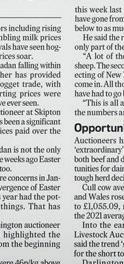


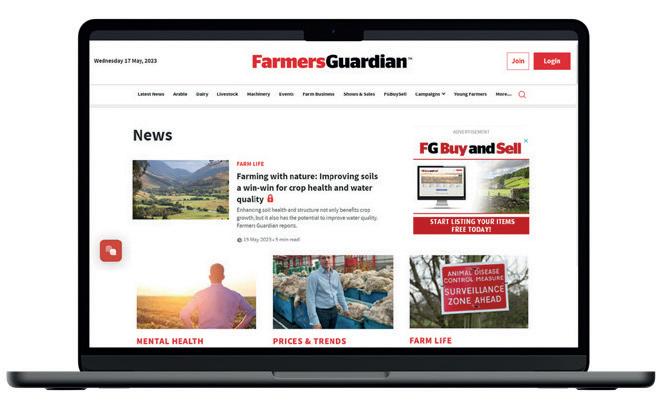


Instant access to Farmers Guardian news across all your devices. You will receive: Full access to farmersguardian.com Use of the Farmers Guardian app


Receive the weekly magazine directly to your door every week and full digital access, plus brand-new features which include:
Farm Futures Weekly Digest (NEW)
From the desk of FG’s editor every Sunday morning, discover exclusive insights that impact the business of pro table farming
Farm Futures Insight (NEW)
Quarterly, in-depth, analytical reports into the latest agricultural trends to optimise your farming practices
Farm Futures Member Exchange (NEW)
A series of digital events focused on learning from real case studies and exchanging knowledge with agricultural thought leaders
Farm Futures Members Lounge (NEW)
Enjoy an exclusive space for members at leading events, such as LAMMA, CropTec, Future Farming Expo Scotland and Farm Business Innovation, to network
Membership contact
The classic print magazine delivered to your door. You will receive: Farmers Guardian magazine delivered to your door every week
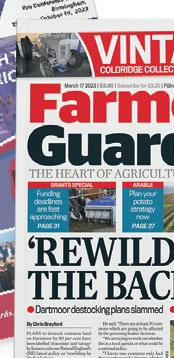

A member’s newsletter delivered every quarter with your magazine highlighting key events, competitions, special o ers, and agricultural diary dates
Earn rewards for being a member through our FG Rewards loyalty scheme, gain points and transfer them into prizes and discounts
Corporate

Full access to FG Farm Futures for your entire team or business. Our membership team will help give your business an edge by providing employees and business owners with the knowledge to assist them in making vital decisions Available when purchasing for 2+ team members
Contact us to learn more about our corporate discounts
To find out more about our packages and to become a member, visit:
farmersguardian.com/membership or call us on 0330 333 0056










farmersguardian.com
As well as advice on how best to avoid heat stress in the dry cow group, this special also features farms which have clear breeding goals and discusses what the future of genetics looks like.
Home Farm is the base for Hartpury College’s 500 agriculture students who are taught through a mixture of full-time and apprentice courses.
e 400-hectare (988-acre) farm supports a ock of sheep, a dairy beef system and arable crops, but it is the herd of 230 Holstein and Guernsey cows which forms the farm’s main enterprise.
And to drive the herd forward, the college has started using a personalised herd index – the Hartpury Herd Index.
Professor and director of agriculture at Hartpury, Prof Ma Bell, created the index and says the aim of it is to identify sustainable milking cows and herd replacements within the herd using a customised pro t and carbon total merit index. e original idea of the index was sparked by the carbon audits the college regularly carries out.
Hartpury College is educating the next generation of farmers with a data first mindset and is creating its own herd index. Ellie Layton reports.
Hartpury’s index to breed more sustainable cows
He says: “As part of our journey to net zero, we are trying to identify cows which are the most sustainable for Hartpury’s farm conditions.
“So, we developed our own Hartpury Herd Index to select cows which are not only productive over their life, but also have lower carbon emissions.”
Prof Bell says: “Knowledge is
power and the data we are collecting is what will help take the farm to the next level.
Data
“Collecting data is important for any business and we want our students to see how they can collect it and the extent of what it can do.”
He adds the index can be

replicated on any dairy herd, with the relevant data, to select and breed cows which are best suited to farm conditions.
Hartpury carries out carbon footprinting across the entire farm and uses these gures to estimate the carbon output per cow.
Prof Bell says he hopes that by selecting for a sustainability trait, the carbon emissions from each cow can be reduced by at least 10%. He says: “We estimate that about 80% of our cows are sustainable under our index terms, so we are looking at ultimately replacing the other 20% with younger animals which have been bred on the farm that apply to the index.”
e index has already had an impact with the farm’s younger cows already showing a reduced carbon footprint.
Prof Bell says: “Other farms could produce their own herd index
Farm facts
rHome Farm comprises 400 hectares (988 acres)
rCows achieve an average milk yield of 9,982 litres, which has increased by 7.8% on the previous year
rCow conception rate stands at 48%
rHerd has a predicted calving interval of 386 days
JULY 2023 44 BREEDING & FERTILITY
48 FUTURE BREEDING A focus on sustainability 52 EFFICIENCY Team approach to fertility improvements 56 HEAT STRESS Pay attention in the dry cow shed
Prof Matt Bell (left) with Bryan Carter.


to become more targeted in identifying and selecting cows which are suited to their farm.
“We hope we have been able to demonstrate how this can be done and the impact it can have.”









He says: “Historically, farmers may have bred a show standard cow, but when you look at her gures, she may not be the best cow within the herd.
“
e index enables me to
select the most suitable heifers to bring into the herd, meaning we can continue to strengthen the herd each year and make it more sustainable.
“ is also encourages




















































































































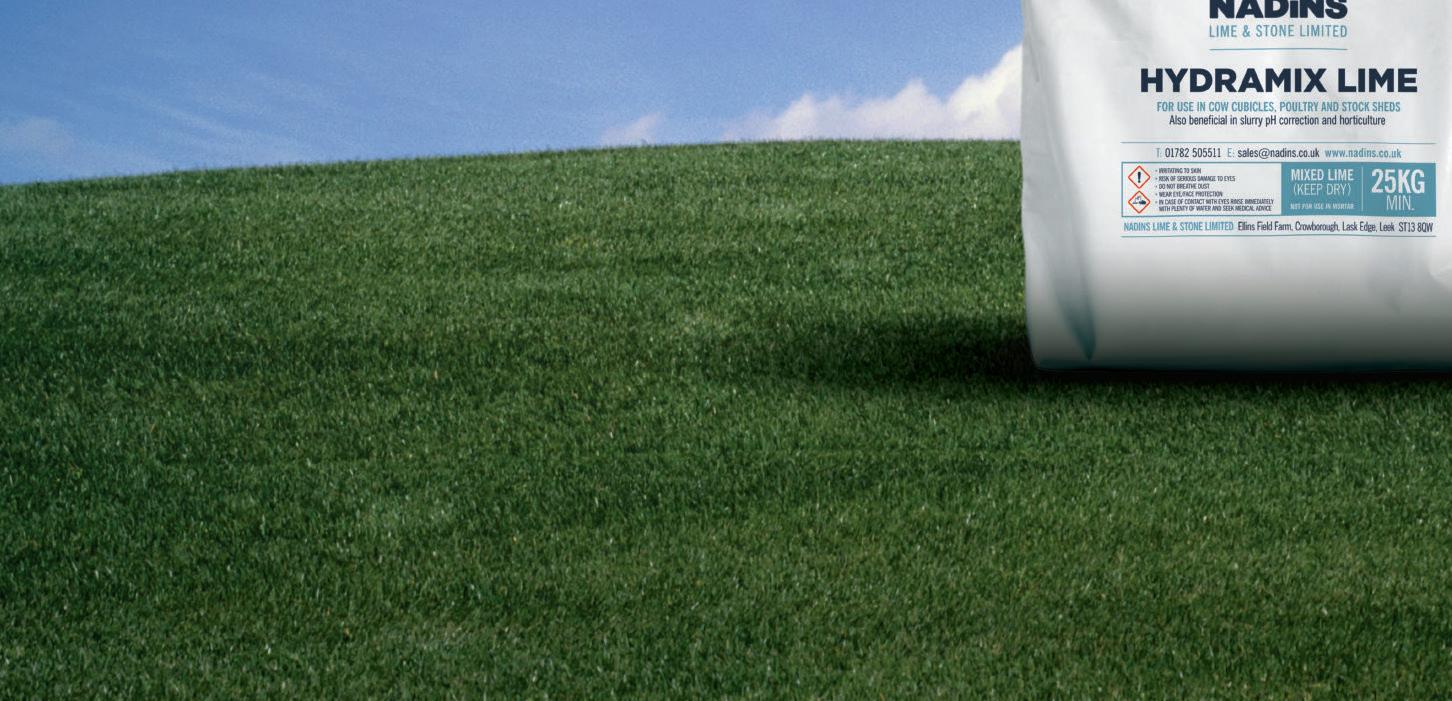





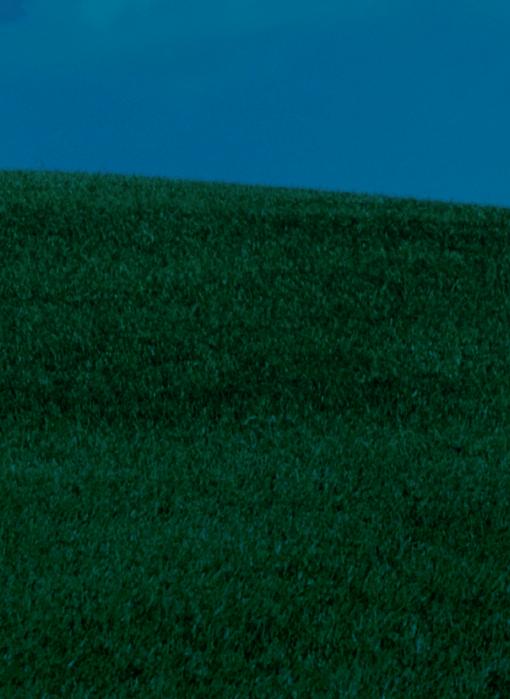

JULY 2023 45
Bryan Carter, herd manager at Hartpury, says by using the index he is able to pinpoint individual cows within the herd and evaluate them on an individual basis rather than as a collective.
The Hartpury Herd Index allows the farm to select animals which are not only productive over their life, but also have lower carbon emissions.
BREEDING & FERTILITY
longevity and the cows will produce more calves before they retire.”
e Hartpury Herd Index is structured in the same way as the classic Pro table Lifetime Index and is based on data which is received from AHDB four times a year and combined with the animals’ data collected from birth when they are genomic tested through Zoetis.
Mr Carter says: “If we can accurately identify each trait on individual cows, there is the potential that saving can be made while gaining productivity.
“Cows are recognised by economic and environmental traits. e main traits we study are no di erent to other herds’ indexes. However, we are se ing out our own targets to make the most out of the index.” e initial work on the index started last summer. It simply runs from a spreadsheet to allow easy use for all sta members. It also enables them to see what e ects di erent breeding choices may have on the herd.
Mr Carter then carefully selects sires and matches each cow to get the best possible production in the next generation.
Mr Carter says milk, fertility and locomotion are the three main traits to focus on for the herd.
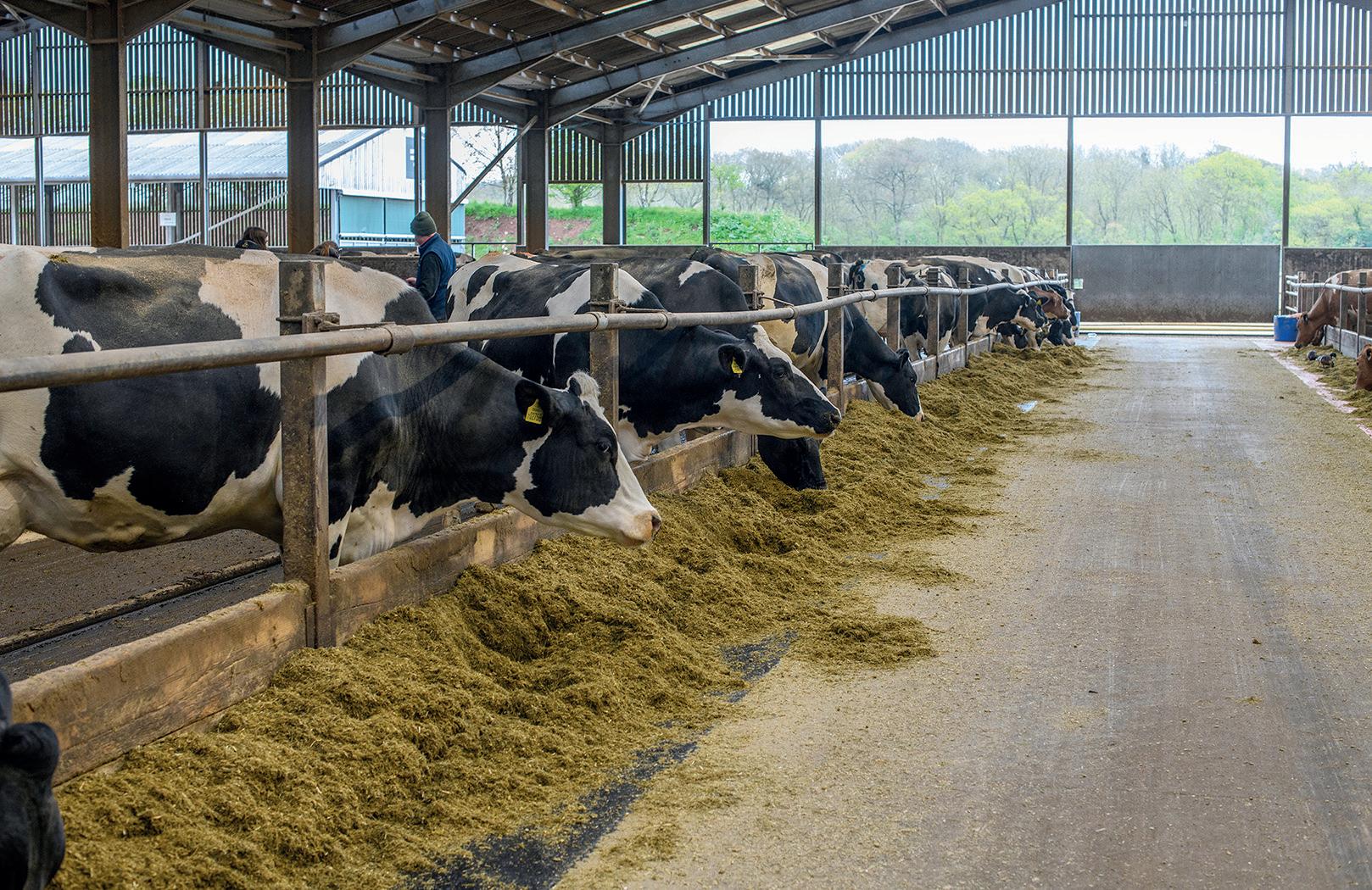
Looking to take the farm forward, the college is exploring the possible use of milking robots.
Mr Carter says: “ is will enhance the student experience on-farm and access technology which they might not have outside the campus.”
Cows currently calve all year round, with a bias towards autumn for heifers. However, in the future, the herd will be split into autumn and spring blocks to
allow for be er planning around the college curriculum.
Mr Carter says the existing Guernsey cows are also slowly being bred out, mainly for practicality.
He says: “Due to the size of the cow, we have di culty milking them in the same parlour as the Holsteins. ey used to be required to bring the herd’s bu erfat levels up, however that is no longer needed on our Muller contract.”
Previously, cows were housed

The herd will be moving from all-year-round calving to autumn and spring blocks in the future.

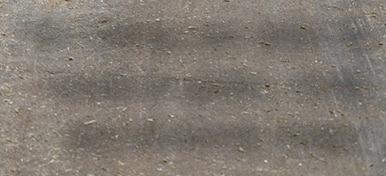
during the evening and grazed during the day, but they are now rotationally grazed during summer and only housed when conditions are not suitable.
Grazing
Mr Carter says: “Grazing at Home Farm can be a challenge as it is very dry in summer. However, with the new grazing management we hope to work around this.”
When housed, cows are fed a ration of silage grown on-farm which is harvested by students. Maize and wholecrop is added to grass silage and heat-treated rape has been added to replace soya.
Mr Carter says: “We have seen no health or production di erences since moving from soya and bu erfat levels have risen to 4.13% and protein levels to 3.32%.”
Mr Carter says the move to heat-treated rape has shown him they were too reliant on soya, despite it having no nancial bene t. He says: “Working with the index we are trying to be as sustainable as possible, so I wanted to re ect that with the diet.
“We currently have a decent milk margin of 20-30p, so this helps us experiment with things like the diet, while proving to the college board we are remaining a strong enterprise.”
JULY 2023 46
The milking cow ration is based on grass, maize and wholecrop silage.


Call us today on 01270 616681 or scan the QR code to discover how to profit from genetic progress Faster genetic progress with a personalised genetic plan? That’s GENEadvance®. That’s Genus ABS. www.absglobal.com/uk
Where does the future lie for genetics and breeding? Richard Halleron spoke to three Northern Ireland dairy industry experts to get their views.
Improving genetics will boost sustainability
The outgoing Dairy Council for Northern Ireland chief executive, Dr Mike Johnston, believes that improved genetics will play a key role in delivering higher levels of e ciency plus enhanced economic and environmental sustainability for all milk producers.
He steps down from his role at the end of June, having given many years of service to the milk industry throughout the UK.
Signi cantly, Dr Johnston also buys-in to the principle that enhanced dairy output and environmental sustainability are two sides of one coin.
He says: “Yes – there is the potential to increase milk output here, provided farmers address the challenge of ge ing the carbon footprint of their businesses reduced.
“Regular carbon auditing will be important in this regard. But farmers must also invest in the improved

genetics and management systems that will allow them to meet their sustainability commitments in full.
“If we are to achieve the various targets that are laid down within the climate change legislation now operating within all regions of the UK and Ireland, we need to re-equip our research and development toolbox in the coming years.



“Developing improved breeding strategies will be crucial as milk producers look to the future.”
According to Dr Johnston, information represents the superhighway to success for the dairy sector.
“ e key to enabling this research will be data, and one of the key roles of a sustainability body will be to bring together the various data sources that are already out there, and that will be generated in the future,” he says.
“ ere is a lot of information already available from a wide range of sources. However, it cannot be accessed from a single source; it is all over the place.
“Bringing it together will be highly bene cial and will allow us to align all the elements of sustainability, including animal health and welfare.”
is crucial.
Where dairy breeding is concerned, Dr Johnston says the focus up to this point has been on traits, such as production, milk quality, fertility, plus good feet and legs. But looking to the future, he says nding ways to improve inherent health levels within dairy populations will also be crucially important.
Methane
Hand-in-hand with this work, Dr Johnston says, will be a commitment to breed for lower levels of methane production.
Dr Steven Morrison, programme leader on sustainable livestock production at the Agri-Food and Biosciences Institute (AFBI), agrees and says this trait can be implemented in future livestock breeding strategies without forgoing improvements in production abilities.
He says the adoption of new and nearly new technologies can bring about a 23% reduction in
JULY 2023 48 BREEDING & FERTILITY
Dr Mike Johnston says finding ways to improve inherent health levels within dairy populations
By breeding for methane reduction, it should be possible to reduce greenhouse gas emissions by 24% up to 2050.



Improving herd performance and fertility can often feel like an uphill battle –BUT YOU DON’T HAVE TO TACKLE IT ALONE.
Our industry-leading sexed semen, extensive range of trait-topping genetics, innovative herd management solutions, and the unparalleled knowledge of our Genetic Consultants are your perfect partners to accomplishing the peaks you never thought you would reach.
WE HAVE THE MEANS, WHATEVER THE CHALLENGE…’
FREEPHONE: 0800 783 7258 | WWW.COGENTUK.COM
BREEDING & FERTILITY
greenhouse gas production levels. But this gure assumes a very high level of uptake for these advancements at farm level.
Dr Morrison points out that the further a ainment of signi cant net reductions in greenhouse gas emissions will require two key drivers: the development of new science, and the development of much improved knowledge exchange systems within the farming industry.
He says genomics and fast-evolving genetic technologies have an important role to play.
“ e goal of genetic improvement is to breed be er animals for particular traits or economically derived indices. is will not be a quick x: it will not happen overnight. But it is an issue that we de nitely have to address.”
Long-term
Research has con rmed that genetic improvement within animal populations is both permanent and cumulative, but Dr Morrison says it is all about taking a long-term approach.
“ e genetic variation within animal populations does exist to allow the identi cation of those deliver speci c, production-related bene ts.
“Heritability is also important. In other words: can a speci c trait be passed from one generation to the next? Where methane emissions are concerned, we are seeing heritability range from 15 to 30% – so this is something that we can aim for.”
But the key challenge, says Dr Morrison, is the identi cation of the animals that can actually deliver these bene ts.




The future will be determined by the science of multiomics


DR STEVEN MORRISON

“To make this happen, we need data. Genomic information will be critically important in this context.”
e latest research has indicated that by breeding for methane reduction, it should be possible to reduce greenhouse gas emissions by 24% up to 2050.
is gure could be even greater, assuming the continuing advancement in scienti c research, says Dr Morrison.
“Genomics is the science of the here and now. But the future will be determined by the science of multiomics. is will allow us to precisely identify what factors switch a speci c gene on and o . “ is is new science that will bring us well beyond methane. It has the potential to open doors where issues such as disease susceptibility
The everfaster rate of technological advancement will allow these breeding-related breakthroughs
LARRY BURKE
and resilience are concerned.”
Larry Burke, the recently appointed chief executive of Ai Services – which has been at the fore of delivering improved genetics to livestock farmers in Northern Ireland for the past 35 years – says animal breeding programmes can respond to the changing needs of agriculture within a very short period of time.
He says: “Recent years have seen dramatic improvements achieved in terms of animal performance, all driven by enhanced animal breeding standards.”
“Where dairy is concerned, an initial focus was placed on milk production. e emphasis was then switched to bu erfat and, subsequently, to milk protein levels.”
Fertility
Mr Burke continues: “Improving fertility rates among ca le populations has been a major challenge for the industry, and technology is playing a key role in driving improvements in this aspect of ca le breeding.”
“Breeding more fertile cows that provide the option of voluntary culling, therefore requiring less replacements, will greatly help in the reduction of methane emissions.”
According to Mr Burke, all these performance-related advances have
been achieved on a cumulative basis.
“ e same principle will hold when it comes to identifying those bloodlines that inherently produce lower amounts of methane and other greenhouse gases,” he says.
“ is strategic breeding target can be met without having to relinquish any of the performance and e ciency drivers that have been secured within our ca le populations over many years.”
Looking to the future, Mr Burke says there is a need to identify animal populations with superior health traits.
“ ere is su cient variation within all animal populations to make this a reality.
“And the ever-faster rate of technological advancement will allow these breeding-related breakthroughs to be achieved within a relatively short period of time.”
He adds he is con dent the farming industry will meet its climate change targets. But he makes the point that the journey ahead is one that must also involve the general public.
“Consumers must be kept fully in the loop where farm management changes and the introduction of new technologies are concerned.
“If they do not buy-in to what agriculture is doing, there will be no future for the industry.”
JULY 2023 50

Outstanding fertility is underpinning the development of the dairy business run by the Daniel family, who farm near Callington in East Cornwall. Dairy Farmer reports.
A team approach to fertility improvement
Like all dairy farmers, the Daniel family has had to evolve their system to improve e ciency to allow it to remain nancially, but also environmentally sustainable.
And the foundation of this has been a team focus on improving fertility which has seen them ranked in the top 5% of Genus ABS RMS herds in the UK while delivering bene ts across the business.
Jack Daniel, who farms with his wife Karen, his dad Chris, and sons Ma and Alex, at Lower Rillaton, near Callington, Cornwall, says the emphasis is on nding the right balance between the land available and the numbers carried, maximising productivity.
Achieving exceptional levels of fertility based on a team approach is certainly allowing the family to move in the right direction.
He says: “If we are ge ing cows and heifers in calf quicker, we can cull harder to improve the quality

of the herd and avoid carrying passengers.
“But we can also reduce average days in milk, improving feed eciency and milk yield.
“Combined with the use of sexed semen, we can reduce the number of heifers carried and create the opportunity to produce more beef calves.
“By working closely with our nutritionist, Ma hew Dymond from Harpers Feeds, our Genus ABS breeding advisor David Bosley and
the Genus reproduction management specialists Lynn Pridham and Tim Willcocks, as well as Calweton Vets, we have been able to make signi cant progress.”
Like many businesses who have moved to RMS, Jack says the main reason for the decision 10 years ago was to add a specialist to the farm team, employing the skills without employing someone directly.
Heat
Ge
If we are getting cows and heifers in calf quicker, we can cull harder to improve the quality of the herd
JACK DANIEL
risk, the cows eligible to serve in a 21 day period that are actually seen, is 65%.
Over the past 12 months the Daniels have averaged 79%, with a conception rate of 52% and a pregnancy rate of 40% with 1.9 straws per conception.
e vet visits every two weeks to PD cows and heifers and to check the very few cows not seen bulling.
Sexed semen is used on heifers and any young cows with up to two services per animal, before switching to beef.

•
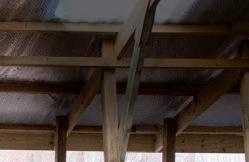




•
•
•
•
ing cows and heifers in calf quickly is vital and be er heat detection was fundamental to improving performance.
en the data provided would allow fertility to be monitored closely, allowing improvements to be made.
e cows calve all year round with a few more heifers calving in the autumn, so a steady ow of calvings is important for an even milk pro le.
David Bosley comments that with most Holsteins cycling within 18-24 days, the target insemination
All cows three lactations and above, are served directly to beef sires, predominantly British Blues.
Stocking
In the past, Jack concedes the farm has produced and carried more heifers than they needed, but argues that this has allowed them to select the best, to cull harder and reduce the average herd age by bringing in around 50 heifers per year.
And they have been able to sell
JULY 2023 52 BREEDING & FERTILITY
Cow kennels
Perfect Shelter
Designed for Animal Health
Excellent Ventilation
•
•
•
•
Shelter from Wind & Rain
Shade from the Sun
•
Plenty of Fresh Air
Ample Space
Minimum Draught
Many options available Telephone: 01772 785252 www.farmplus.co.uk RECRUITING REPS See website for details
Alex (left) and Jack Daniel at Lower Rillaton, Cornwall.

The aim of the Daniel family is to reduce the number of heifers needed to be reared.

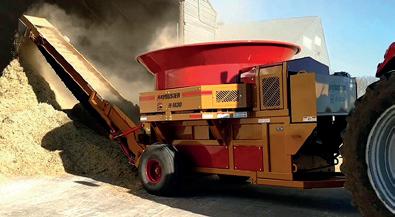
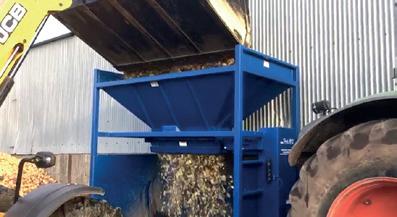





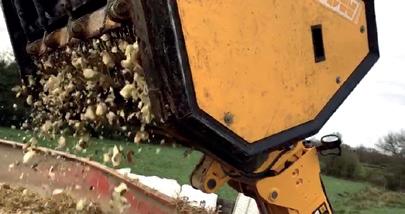



JULY 2023 53 BREEDING & FERTILITY Feed Processing Specialists Please visit www.enegis.co.uk for more photos or call 01789 205132 or 07721 442979 Tub Grinders - Exclusive UK Distributor of Haybuster & Rotogrind Grinders. - Range of models from 5t - 25t / hour output. - New, used & refurbished machines available. - Ideal for straw, hay, green waste, roots, biogas feeds etc Root Choppers & Cleaners - Loader, 3 point linkage, free standing PTO and electric drive available - UK Distributor of VDW range of choppers, cleaners & feed dispensing equipment - Output from 10t/hour to over 120t/hour available Diet Feeders - Largest stock of mixers in the UKover 50 ma chines in current stock - Refurbished, used & nearly new units available - New Mini Mixer available - Diet feeder parts available- Blades, Conveyor belts, gearboxes, weigh cells. - All feeders undergo 30 point service - Finance available subject to terms - Nationwide delivery available Current Used Stock: - Trioliet 20 x 2 - Strautmann 10, 20m - Bvl 10, 12, 15, 20m - Kuhn 12, 14, 27 - Siloking 14 x 2, 14 duo, 18m - Shelbourne Reynolds 13, 19 - Hi Spec 12, 16, 20 - JF 18, 22m - Redrock 14,16 - Rotogrind 760 x 4 - Farmhand Tub grinder - Enegis Multi chop 4 - VdW 2.4m root chopper bucket - VdW 2.4m mixing bucket - VdW Duo Compact loader straw blower on pin & cone - Profi root Chopper x 2 Used Diet Feeders always wanted Call Andy Berry about “Crypt-Occur” 07969 164 066 www.berrysagriculture.co.uk Maintaining Calf Health
BREEDING AND FERTILITY
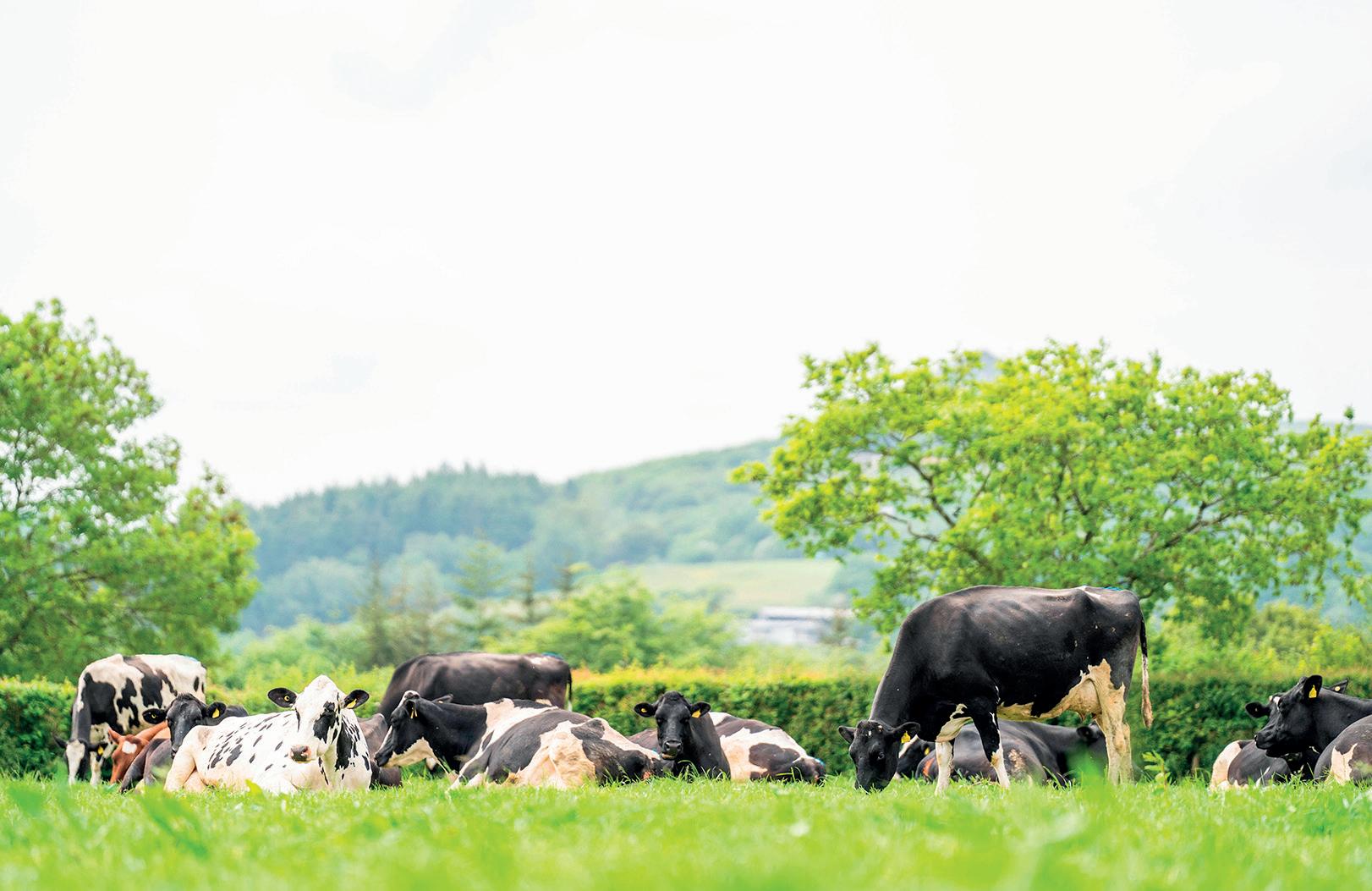
Farm facts

Exceptional levels of fertility are being achieved through a team approach.
15-20 heifers, usually at bulling age, per year.
Now, the aim is to pull back on the number of heifers reared and to produce more beef calves.
is will give the option to grow beef calves on, either nishing or selling as stores.
In addition, Jack believes that rearing fewer heifers will mean it will be possible to rear them be er and reduce age at rst calving down to 24 months.
Fewer, younger calving heifers will reduce the carbon contribution from the youngstock enterprise and reduce total rearing costs.
Jack is the rst to admit that the fertility improvements would not have happened without good nutrition. In the winter, the cows are
fed a mix of maize and grass silage, urea-treated home-grown wheat, fodder beet, a 40% protein blend and a bespoke mineral.
In the summer, cows graze by day and are housed by night on the winter diet minus the fodder beet. In the parlour, they are fed 8kg/day of home-grown barley with a 25% protein balancer for 90 days, before the rate is stepped down. e overall herd feed rate is 0.4kg/l.
Ma hew Dymond, of Harpers Feeds, stresses the importance of energy density in the milking diet while avoiding overfeeding protein to help keep condition on the cows.
Diets are based on quality silage.
About 80 hectares (200 acres) of rst cut are taken followed by 40ha (100 acres) of second cut.

ird and fourth cuts are baled.
First cut typically analyses at 27% dry ma er (DM) and 11.8MJ ME/kgDM with second cut at 32% DM and 11.1MJ ME/kgDM.
Cows are dry for 42 days and the system of dry cow management is simple, yet e ective. Far o dry cows are fed baled silage and minerals, while close-up cows are fed clamp silage, barley and protein balancer and a dry cow mineral.
Ma hew says that close a ention has been paid to minerals.
Forage analysis showed a particular problem with iodine, so all animals receive a bespoke mineral to address this.
Options
In any business, having options is important and Jack believes they now have options to help them react depending on what the industry faces.
He does not rule out increasing the herd to 200 cows and, while their focus is on milk constituents rather than milk yield, he says the genetics are in the herd to allow them to produce more milk.
ey have the option to nish more beef calves or to keep and sell additional heifers as the younger herd should allow them to reduce replacement rates.
Being an Arla supplier, a major
r180 all-year-round calving Holstein cows
rAverage production
7,800 litres at 4.95% fat, 3.67% protein
rMilk sold to Arla
rReplacement rate 27%
rHeifers currently calving in at 26 months
r154ha (380 acres) including 24ha (59 acres) of barley (50% spring: 50% autumn) 12 ha (29 acres) maize, 12ha (29 acres) wheat and 106ha (262 acres) of grassland — a mix or permanent pasture and reseeds

challenge at the moment is meeting the sustainability targets and achieving the required points.
For this reason, the whole farm has now moved on to Massey Harpers Planet feeds which contain no soya, meaning Jack will pick up 11 points immediately by taking more than 50 tonnes of soya out of the diet and reducing emissions by 250 tonnes of carbon per year.
“Cu ing soya out was an easy decision as it is perfectly possible to feed cows, heifers and calves without it and leave performance unchanged, so why would you not do it?
“With the foundations of excellent fertility, quality forages and good nutrition we have a system which can be more agile as the market, economic and environmental pictures change, and this has to be a good thing.”
JULY 2023 54
Genus ABS reproduction management specialist Lynn Pridham.
Matthew Dymond of Harpers Feeds

Turbofarmer 33.9
Don’t settle for second best




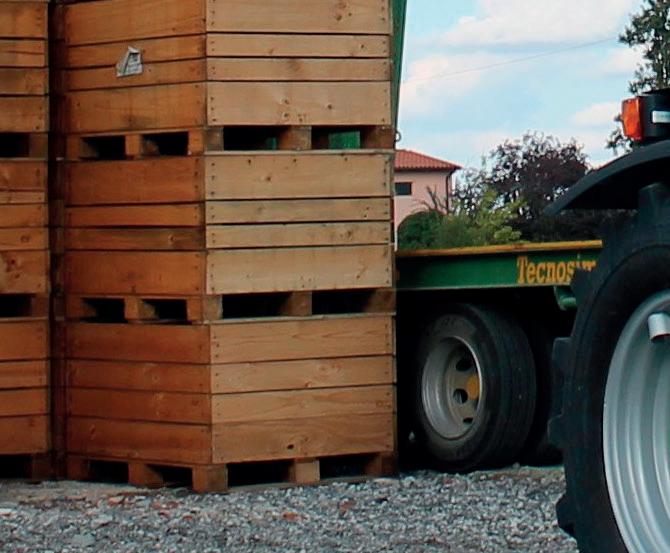








ENGINE 136 LIFT HEIGHT 8.6




LIFT CAPACITY 3.3 T


Don’t miss out! Visit the Merlo UK Stand T 207(A) at this years Royal Highland Show, taking place from 22nd-25th June. On display will be a variety of the Merlo agricultural & construction range and the brand NEW Turbofarmer 30.7. Be the first to see it!




merlo.co.uk
Heat stress in dry cows should not be ignored as results from a decade of research shows it affects the cow’s following lactation and subsequent generations. Dairy Farmer reports.
Avoiding heat stress in dry cows
Results from trial work carried out between 2012 and 2022 at the University of Florida, show that heat-stressed dry cows, which are close to calving, have lower milk yields and their calves performed below that of their herd mates which were — as unborn calves — in a cooler
Heat stress
JWhile stocking rates among dry cow groups might not be as high as in milking group housing, and dry cows might not move around and generate as much heat, dry cows are often in older buildings with less ventilation.
So, Ms Theeruth says it is just as necessary to keep an eye on conditions.
Similar rules apply for dry cows and for milking cows in heat stress conditions, such as providing plenty of clean fresh water and feeding space with shade. And also keeping fresh feed pushed up.
“These dry cows that are close to calving need plenty of encouragement to maintain

environment. Bianca eeruth, of Cargill, explains in the trial both the cooled and hot group were housed in the same building where temperatures averaged 25degC or more. e only di erence was that the cooled group had access to shade, fans and sprinklers whereas the hot group just had the shade of the building. Dry cows that were
intakes. Adding a feed product such as LiFT — Liver Function Technology, is an option for dry cow diets.
“The liver is the cornerstone of the cow’s energy system, and this feed product primes the liver and prepares the energy pathways for milk production.
Hydrate
“It will also hydrate the cow at a cellular level and reduce the risk of dehydration.
“These functions support the cow’s ‘wellbeing’ and encourage appetite and feed intake.”
Trials show that feeding LiFT in the 21 days before calving and in early lactation supports milk yield, with trials showing
Results from research at the University of Florida showed dry cows that were heat-stressed during the final 46 days of gestation, had lower feed intakes.

heat-stressed during the nal 46 days of gestation, had lower feed intakes and a shorter gestation of between two and eight days.
ey also had increased respiration rates and body temperatures compared with cooled cows.
And calf birth weights from the heat stressed dry cows were on average 4.6kg lighter than in utero
improvements of 3.4kg of milk a day in the first 150 days.
She says it is also just as important to prioritise dry cow feed quality.
“Far too often it is too dry and stale.
“Two day mixes are a ‘no’ and it should have at least 45% moisture and be pushed up regularly.
Make sure these dry cows have easy access to fresh moist appetising feed to encourage intakes at this vital time.”
Ms Theeruth says fans and sprinklers are also valuable in dry cow sheds.
And she says to avoid adding layers of clean straw on dirty bedding.
cooled cows, possibly due to the shorter gestation length, and 7.1kg lighter at weaning.
Heat-stressed dry cows went on to yield 3.6kg a day less than ‘cooled’ dry cows, which is thought to be linked to lower recorded mammary gland development that takes place in the dry period.
Colostrum quality was not
“These layers of straw and manure create a lot of heat generating bacterial activity and act like an electric blanket.
“Instead, clean the yard or pen and use fresh straw, or if the system allows, sand bedding.”
Grazing cows must have access to plenty of shade says Ms Theeruth.
“Do not leave heavily pregnant cows to bask in full sun, it is an almost guaranteed way of them suffering from heat stress.
“And, as the Florida work shows, how you look after the dry cows has an impact on her performance and that of her daughter and granddaughter.
“A few weeks of neglect here can have long-term implications.”
JULY 2023 56 BREEDING & FERTILITY

a ected in the heat-stressed dry cows, but their calves’ ability to absorb the immunoglobulins was lower than the control group
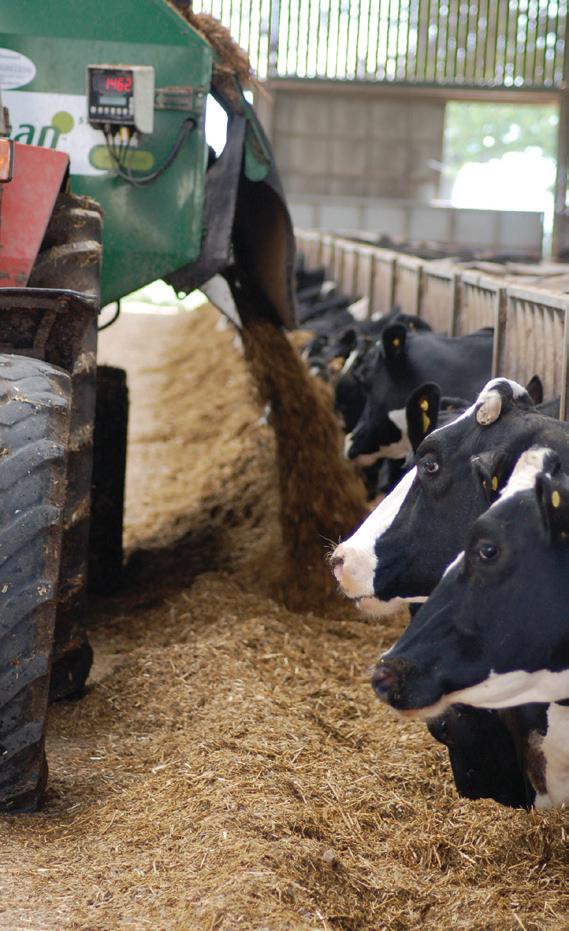
making them more likely to be predisposed to health challenges preweaning.
Ms eeruth says: “Lower birth weights and less immune response means these calves did not get the best start to life.
“ e trial results also showed that these calves went on to have lower rst, second and third lactation yields, averaging 2.2kg a day, 2.3kg a day and 6.5kg a day less milk respectively than in utero cooled calves.”
Lifespan
Lifespan of the in-utero heatstressed calves was also 11.7 months less than the control group with a reduction in productive life of ve months.
e trial also showed that subsequent generations from heat stressed dry cows was reduced.
“It seems that in-utero, heat stress has a permanent and multigenerational e ect on performance,” says Ms eeruth.
Taking the heat off
JMs Theeruth explains that heat stress is triggered by a combination of temperature and relative humidity.
“The temperature and humidity index [THI] is a good monitor and signals alarm bells if this increases.
“Ventilation and cooling devices will help keep the THI in the thermoneutral zone.”
There is plenty of data to demonstrate the effects of heat stress in the milking herd, but Ms Theeruth says when it comes to dry cows, heat stress is less talked about, probably because the effects are more longer term and less obvious than those seen in milking cows.
“But we do know that heat stress affects dry cows and there are lessons to learn.”
In the UK, relative humidity in summer is about 60% and if average daily temperature is 20degC or higher conception rates have been shown to drop and if it gets to 22degC for a few days, milk yield and quality start to fall.
Triggered
Ms Theeruth says for dry cows, heat stress in the UK is likely to be triggered when average temperatures are in the mid 20degC range, when the THI gets to about 68.
She says: “And while annual average UK temperatures may not be as high as those in Florida, we are seeing more prolonged heat waves and high humidity in many parts of the UK that will trigger heat stress in many dry cow sheds.”

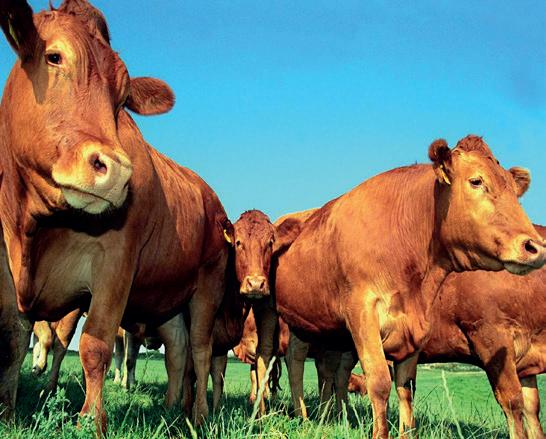

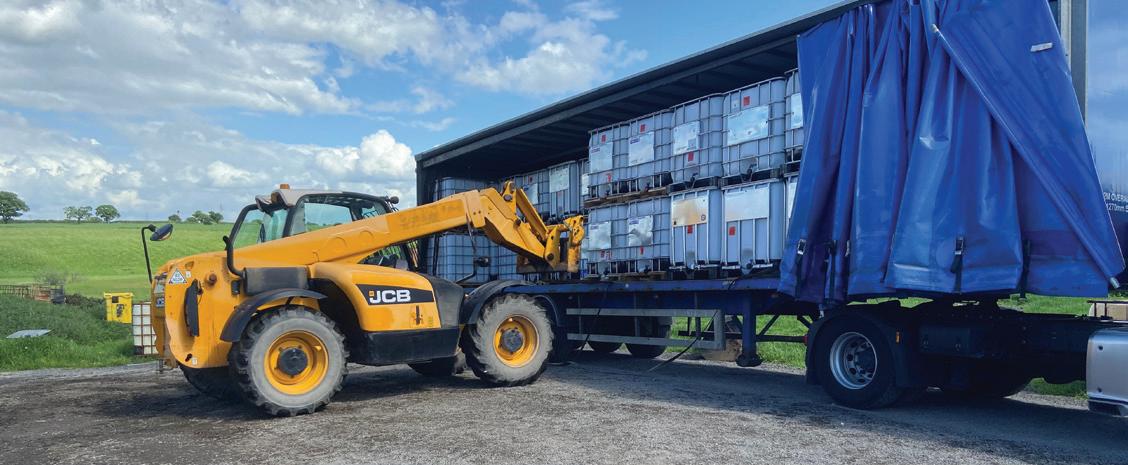





JULY 2023 57 BREEDING & FERTILITY 01270 295 025 | info@rumensupplies.com| www.rumensupplies.com 4 Molasses, Cubicle Lime, Grain Treatment & Much More 4 Yeast, Binders, Milk Powder 4 Formalin, HoofGuard & Dairy Hygiene 4 Protected Fats & Methionine 4 Minerals & Buffers
GET A QUOTE
Buying farm inputs has never been easier
Ease of access, building size and yard layout can often dictate machinery choice on dairy farms, with many yards growing organically in size and format over time. James Huyton looks at a range of different bedding machine market options to suit farm sizes and budget.
Bedding machinery options
Ian Cleasby Agriculture
JDesigned to be retrofitted on to new and existing tractor-mounted scraper units, the Scrapenser’ design offers users a one-pass system when bedding with sawdust.
Currently, two design options are available for flip and box scrapers.
The flip scraper version requires one double-acting spool, providing directional change to the belt, allowing the bedding material to be dispensed out of the chosen side. The manufacturer claims that, driven

direct from the motor, this system is simple and reliable with no requirement for drive chains, belts or gearboxes. Two


double-acting spools are required for the box scraper variant. A tipping box is incorporated into its design for extra capacity and
consistent delivery of bedding material to the feed belt.
Optional valve kits are available for tractors with a single doubleacting spool. The manufacturer also states hopper extensions can be specified for greater capacities.
Working widths vary from 1,600mm to 2,350mm across the range, with hopper capacities ranging from 0.352 to 0.686 cu.m. Current models are not intended to bed green bedding or sand with weight constraints making it unfeasible for most scraper tractors.
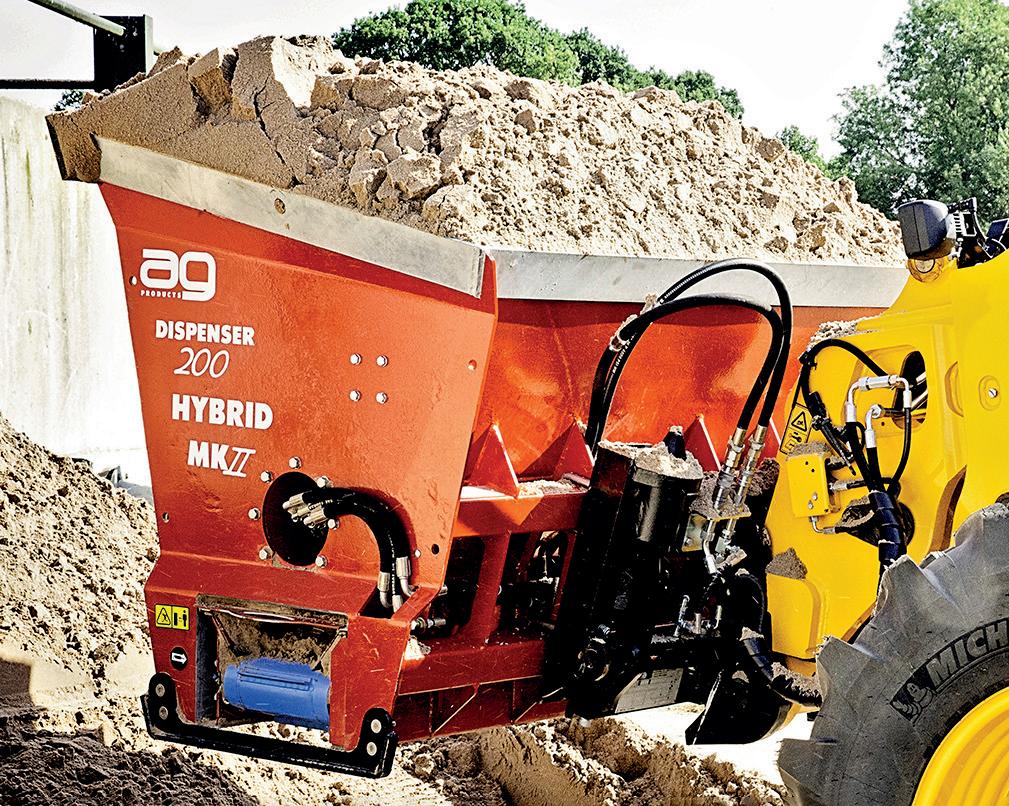
Ag Products

JAg Products offer a full range of cubicle dispensers including pedestrian, telehandler-mounted and trailed variants. Available in tractor and telehandler-mounted options, the AG200 Hybrid is the largest variant of the Hybrid range with a 2.1cu.m capacity. Capable of dispensing most commonly used
bedding materials including sand, sawdust and lime. Designed with an internal auger system to dispense bedding material and agitators to reduce bridging.
The manufacturer highlights the option to specify spinner units claimed to deliver a more even spread pattern when dispensing sand.
JULY 2023 58 MACHINERY INNOVATION EFFICIENCY RELIABILITY EXPERTS IN SLURRY HANDLING & BIOGAS SOLUTIONS FOR ALL YOUR FARMING NEEDS Separators & Green Bedding Screw Conveyors & Long Shaft Pumps Submersible Pumps & Agitators ABOUT US SEPCOM® and CHIOR® offer advanced solutions through a comprehensive range of machines and accessories for livestock manure treatment and for effluents in biogas production Livestock manure treatment Digestate agitating & pumping Biomass conveying & feeding WHY CHOOSE US ? Innovative products suitable for heavy duty operat on offered at a fair price 0 1 6 8 4 2 9 9 1 0 4 0 7 8 5 1 2 5 2 6 2 7 Owen Bond@Saveco-Water co uk www saveco-water co uk

Shelbourne Reynolds
JShelbourne offers three telehandler-mounted cubicle bedders, with the CB150 positioned in the middle of their range.
The unit has a holding capacity of 1.2cu.m with an overall height of 1,390mm and width of 1,900mm. Standard features on this hydraulicallydriven machine include 300mm wide, heavy-duty conveyor belt, which is two-way controllable allowing material discharge at both sides of the machine.
The manufacturer’s design includes a chain-driven internal agitator claimed to reduce material bridging and maintain constant belt feed.
Adjustment of the metering unit and different tines will allow the throughput of various bedding materials. Variations also include a three-point linkage mounting frame for tractor use suitable for 40hp and above. Optimum hydraulic flow rates are between 30-35 litres per minute.
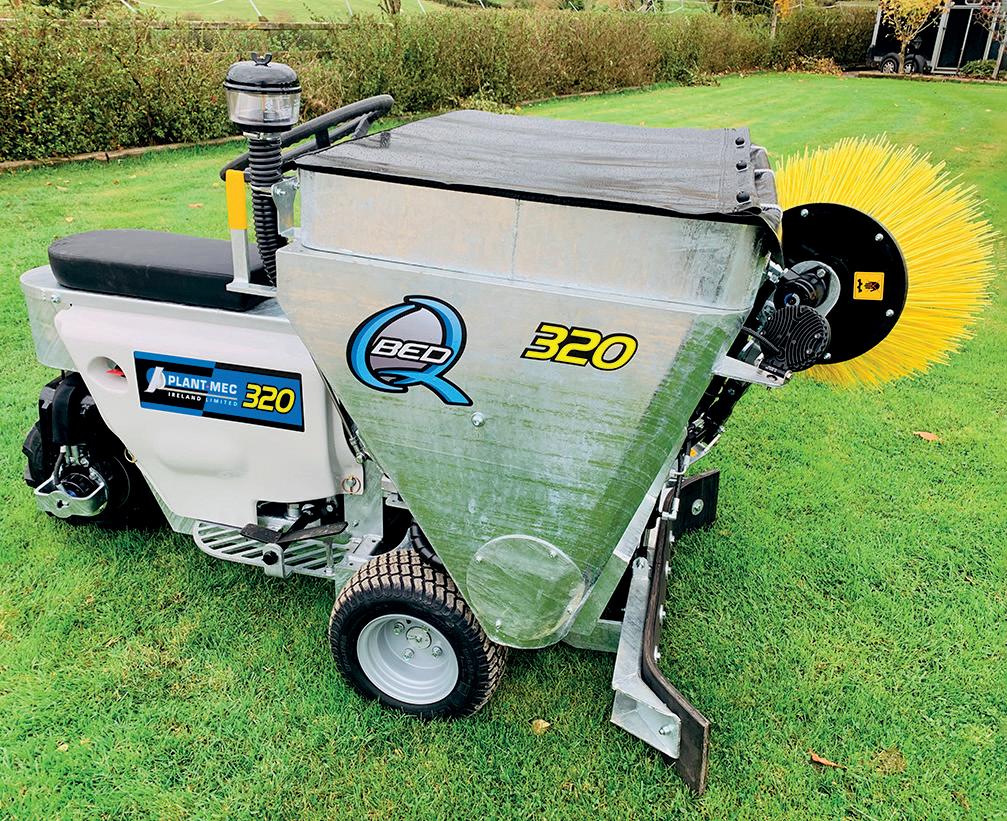
PlantMec Q-Bed 320
JFor smaller operating environments, the self-propelled Q-Bed from PlantMech comes with a fully galvanised chassis and 0.320cu.m hopper for bedding material. A hydraulically-operated front scraper and brush clean
the cubicles and slats, while the bedding machine follows with clean bedding, creating a one-pass system. The threewheel drive, hydraulically-driven machine has a 2.1m tuning circle, 10hp engine, hopper cover and LED lighting

JULY 2023 59 MACHINERY











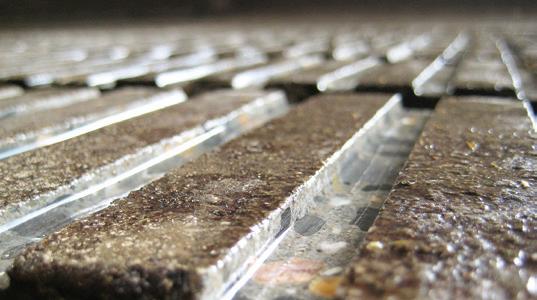
Arla Foods cuts 2 euro cents for June

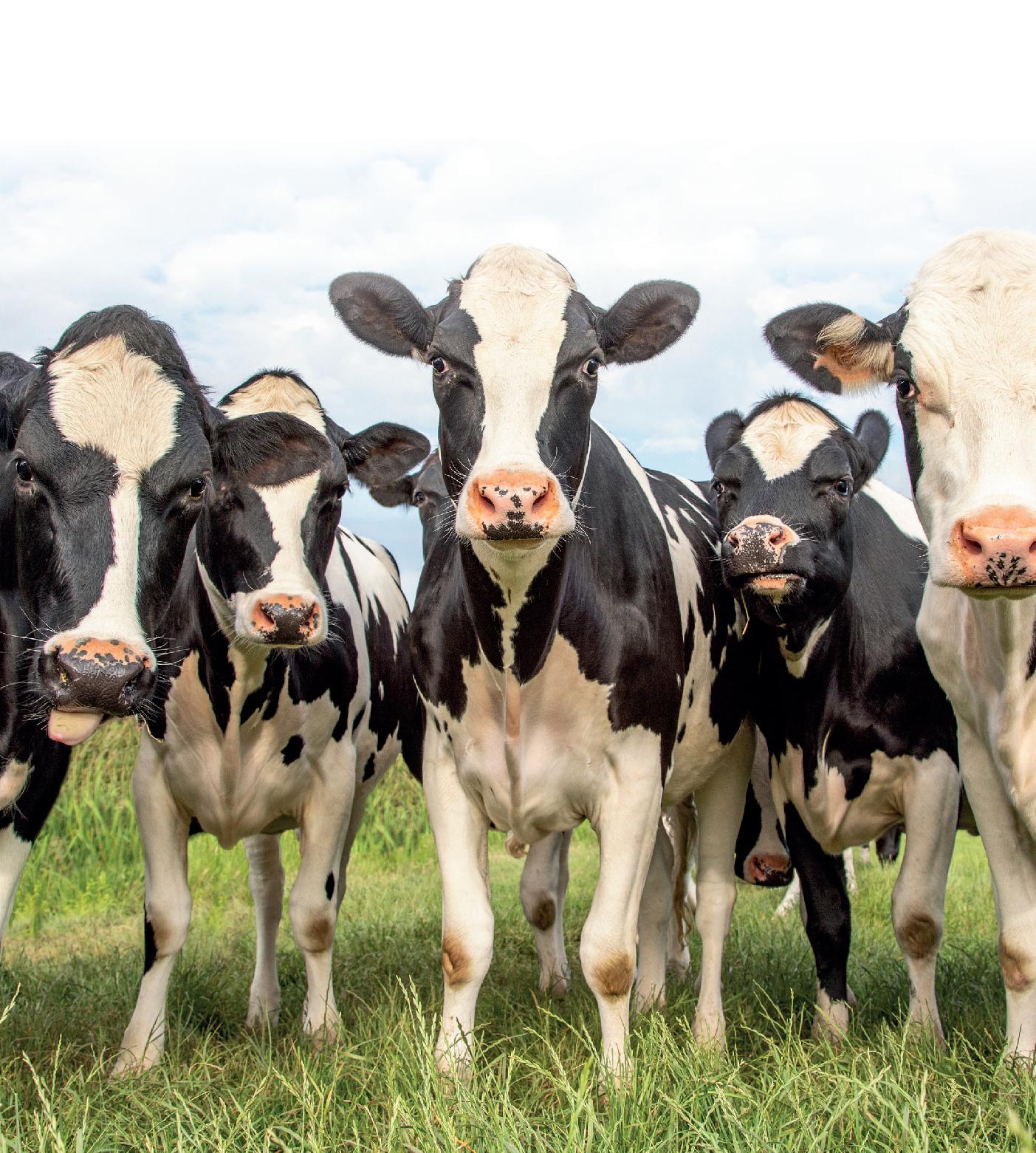



J e fact several milk buyers in late April took the tentative step of holding their milk prices for June, leading perhaps to some believing milk price cuts might be made, possibly made the Arla Foods announcement of its 2 euro cents reduction for June all the more of a surprise. If this were not the case, then it certainly sparked another round of milk price cuts for July, especially from those milk buyers who did hold for June.
With the Arla owners’ conventional price reducing by 2 euro cents and the organic price by further 1 euro cent, the reductions take the company’s total reduction for the year to date to 19 and 18 euro cents, respectively.
e company reports that while global milk supply continues to grow, albeit at a slower pace, the retail sector continues to come under pressure as consumers buy both fewer and cheaper dairy products, due to the ongoing cost of living crisis. On top
of this, retailers have started to reduce prices, while uncertainty remains as to future purchasing behaviour from consumers.
While commodity markets appear to be stabilising, the foodservice sector is also yet to get back to pre-pandemic levels. ere can be li le doubt the Arla price reductions for this year to date leaves a bi er taste for owners, who have enjoyed one of the top non-aligned milk prices for at least the last three years.
League table is month, our league table ranks the 12-month average prices for the 2022/23 milk year, supporting the case as the Arla price comes out as one of the top performing non-retailer prices with a 12-month rolling average of 46.54ppl, based on our liquid standard, while on manufacturing, their price occupies the pinnacle with a 12-month rolling average of 48.41ppl.
JThe Arla Foods Direct milk price continues to track down at the same rate as the owner price albeit, a month in advance. Following the price reducing by 2.64ppl from June 5, the company has reduced our manufacturing standard price by a further 1.78ppl for July to 32.67ppl, with our liquid price down 1.71ppl to 31.35ppl.
60
MILKprices
Arla reduces its Directs milk price JULY 2023 HAVE YOU HERD? THE DAIRY SHOW RETURNS ON WEDNESDAY 4 OCTOBER 2023 VISIT WWW.BATHANDWEST.COM/TICKETS TO BOOK MEDIA PARTNER HEADLINE SPONSOR DEEP GROOVES FOR SOLID FLOORS SLAT GROOVES DIAMOND CUT Call us on 01258 817372 email: info@tractorsuk.co.uk TRACTORS UK SOLE UK IMPORTER OF TAFE TRACTORS FROM THE BEST PEDIGREE BASIC, SIMPLE & RELIABLE TRIED & TESTED FOR GENERATIONS 08R04B � Drum or oil immersed brakes � Roll bar or cab � 2wd or 4wd � 2 Years’ warranty � Comprehensive parts backup www.tractorsuk.co.uk ✆ 01258 817372 ✉ info@tractorsuk.co.uk BASIC, SIMPLE & RELIABLE www.tractorsuk.co.uk • 2 Years’ warranty Comprehensive parts backup • Oil immersed brakes 2WD or 4WD
Milk price analyst
Stephen Bradley on the latest milk industry developments.
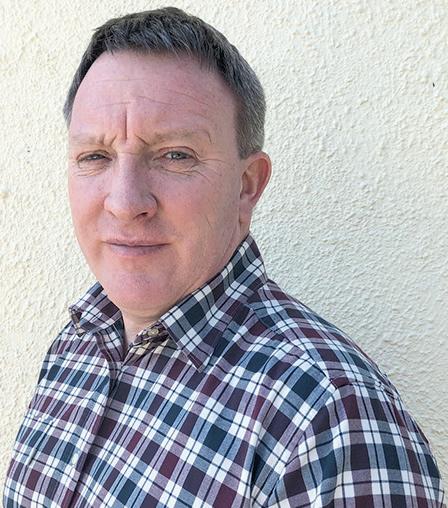
Muller’s 2ppl cut for July
JAfter previously holding its milk price for June, Muller has reduced its July Direct price by 2ppl for conventional with a penny reduction on organic.
The company reports that it is seeing continued market pressure, coupled with producer milk supply remaining ahead of forecast.
The reduction takes our liquid standard price down to 38ppl, while the organic price moves down to 48ppl.
The Lidl fixed price also declines 2ppl to 38ppl
after it was agreed with the discounter last year it would stay in line with the Muller Direct price movement.
Cheese produces a mixed bag
JA quick scan of the top milk buyers for cheese reveals a mixed bag of monthly price movements.
For example, Barbers Cheesemakers, which held for June, reduced from July by 2.06ppl on our manufacturing standard to 37.04ppl.
Parkham
Similar with Parkham Farms, which cut 1.75ppl for July to 37.25ppl (including the 2ppl Tesco premium) after its June hold.
On the other hand, companies such as Belton Farm, South Caernarfon and Wyke, which all reduced
As is normally the case, a move by Muller triggers further milk buyer movement in the middle ground liquid market, with the likes of Yew Tree moving down a penny from July to 37ppl, Crediton and Freshways down 2ppl to 37ppl and 36ppl, respectively, with BV Dairy, which held for June, down 1.97ppl to 38.03ppl. in June by 2ppl (37.05ppl) 1.75ppl (36.50ppl) and 1.04ppl (37.77ppl), respectively, have all held the price for July.
Other companies have made back-to-back monthly cuts. These include The Fresh Milk Company (Lactalis) which reduced 1.5ppl for June, followed by a further 0.3ppl for July to 36.94ppl, First Milk which followed its 1.4ppl cut for June with a further 1.04ppl reduction for July to 36.85ppl, and Saputo Dairy UK, which reduced its Davidstow price by 2ppl for June, before reducing by a further 1ppl to 37ppl for July.
* Our Liquid standard litre is 4%b/f & 3.3% protein and our Manufacturing 4.2%b/f & 3.4% protein. In both cases for Bactoscans of 30,000/ml & SCCs of 200,000/ ml, 1mltrs/yr on EODC (max vehicle accessibility) but before B pricing, balancing, seasonality, monthly profile payments, capital deductions or annual/part annual growth incentive schemes or supplements not directly linked to dairy market price movement.



Horizontal

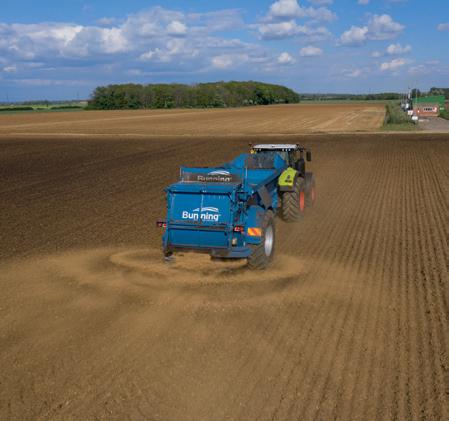


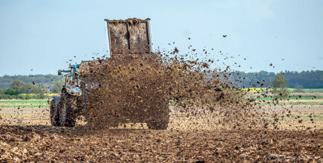











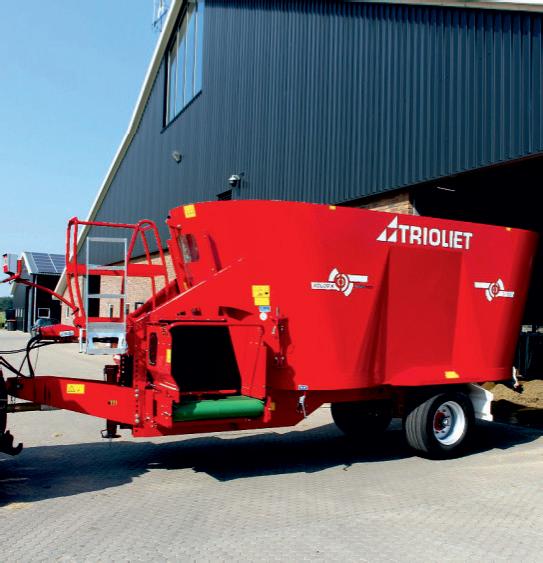


61
JULY 2023
® Manure Spreaders
Lowlander
TVA
6 –
Twin Vertical Auger
|
40 tonnes
HBD
8 –
bunning spreaders www.gtbunning.co.uk Tel: + 44 (0) 1362 860352
Year Warranty | Details available upon request
Beater & Spinning Disc
|
40 tonnes
3
Notes to table
Prices for both Liquid & Manufacturing tables paid for a producer sending 1mltrs/yr on EODC (max vehicle size accessibility) with Bactoscans of 30,000/ml and SCC’s of 200,000/ml with Thermodurics of 500/ml. Excludes capital retentions or AHDB levies, profile adjustments from level supply, seasonality, balancing and A&B price schemes (includes the winter premiums paid in NI). Excludes annual / part annual growth incentive schemes or supplements not directly linked to dairy market price movement. Liquid price for milk contains 4% b/f and 3.3% protein. Manufacturing price for milk containing 4.2%/b/f and 3.4% prot. All prices for non-aligned prices are before monthly retail supplements. (i) Feb’23 prices before seasonality or B pricing (ii) Mar’23 prices before seasonality or B pricing (iii) Table ranked on simple rolling 12mth average of monthly prices Apr’22 to Mar’23). (i) v (ii) The difference Mar’23 compared with Feb’23. UK Arla Farmers 2.54ppl decrease from Feb’23 includes forecast 13th payment holding on 1.23ppkg (1.267ppl) based on our liquid std litre. UK Arla Farmers 2.65ppl decrease for Feb’23 includes forecast 13th payment holding on 1.28ppkg (1.318ppl) based on our manufacturing std litre. UK Arla Farmers 3.39ppl decrease from Mar’23 includes forecast 13th payment holding on 1.23ppkg (1.267ppl) based on our liquid std litre. UK Arla Farmers 3.52ppl decrease for Mar’23 includes forecast 13th payment holding on 1.28ppkg (1.318ppl) based on our
Latest milk prices from JULY 2023
62
MILK PRICES
manufacturing
litre.
13th
Apr’23. First Milk Haverfordwest Tesco Cheese Group includes 2ppl retailer premium averaged as 1.5ppl based on seasonal profile. Fresh Milk Company price before Morrisons monthly cheese supplement (last payment made in Dec’22 of 0.072ppl for Jul’22 to Dec’22 period). MMG Direct price includes 1ppl Premium paid annually in arrears to Direct/Organic farms meeting specific Müller Direct criteria (Quarterly payments from Apr’22).Crediton Dairy price includes FarmMetrics Scheme Bonus of 0.5ppl paid monthly. South Caernarfon price includes flat 0.7ppl annual member bonus. ‡ Price includes 12mth average rolling profile fixed at 0.57ppl. * UK Milk Futures Equivalent (UKMFE) net to producer includes 5% processor margin and allowing 2.55ppl ex-farm haulage for Feb & Mar’23 + milk testing ** Ave delivered spot milk net to producer allows 3ppl covering haulage + milk testing and margin. (iv) Latest confirmed milk price at the time of going to press. UK Arla Farmers 5.10ppl
Apr’23
13th payment
on min 1.23ppkg
on our liquid std litre. UK Arla Farmers 5.31ppl decrease for Apr’23 includes forecast 13th payment increasing from 1.28ppkg (1.318ppl) to 1.29ppkg (1.329ppl) based on our manufacturing std litre. UK Arla Farmers 2.54ppl decrease from May’23 includes forecast 13th payment of 1.24ppkg (1.277ppl) based on our liquid std litre. UK Arla Farmers 2.65ppl decrease for May’23 includes forecast 13th payment of 1.29ppkg (1.329ppl) based on our manufacturing std litre. UK Arla Farmers 1.71ppl decrease from Jun’23 includes forecast 13th payment of 1.24ppkg (1.277ppl) based on our liquid std litre. UK Arla Farmers 1.78ppl decrease for Jun’23 includes forecast 13th payment of 1.29ppkg (1.329ppl) based on our manufacturing std litre. Arla Direct June decrease of 2.64ppl is from the 5th Jun’23. MMG Direct Premium for Direct/Organic farms meeting specific Müller Direct criteria confirmed as 1ppl for 2023 and paid quarterly, Apr’23, Jul’23, Oct’23 & Jan’24. All prices are before any additional monthly retail supplements. Milkprices.com cannot take any responsibility for losses arising. Copyright: Milkprices.com Feb’23 Mar’23 12mth Diff Latest 4.0/3.3 4.0/3.3 Ave Mar’23 Confirmed Before Before Apr’22 v Milk Seas’lty Seas’lty Mar’23 Feb’23 Price LIQUID PRICES (4% b/f & 3.3% prot) (i) (ii) (iii) (i) v (ii) (iv) Müller Milk Group – M&S 52.66 52.66 48.43 N/C 50.67 UK Arla Farmers – Morrisons (Grazing) 48.19 44.80 48.10 -3.39 35.45 UK Arla Farmers – Tesco 47.99 44.60 47.96 -3.39 35.25 UK Arla Farmers – Morrisons 47.96 44.57 47.86 -3.39 35.22 Müller Milk Group – Waitrose 50.00 49.50 47.21 -0.50 46.70 UK Arla Farmers 46.57 43.18 46.54 -3.39 33.83 Dale Farm NI 40.02 37.52 45.94 -2.50 34.93 Crediton Dairy 48.50 45.00 45.63 -3.50 37.00 Dale Farm GB (Kendal) 47.72 43.60 45.53 -4.12 38.59 Freshways 47.00 44.00 45.33 -3.00 36.00 Müller Milk Group – Tesco 47.00 44.00 45.27 -3.00 43.51 Paynes Farms Dairies 47.00 44.00 45.17 -3.00 36.50 Yew Tree Dairy 47.00 44.00 45.17 -3.00 37.00 Müller Milk Group – The Co-op Dairy Group 46.83 44.15 45.05 -2.68 40.95 Arla Foods – Tesco 46.75 43.75 45.02 -3.00 43.26 Müller Milk Group – Müller Direct 47.00 44.00 45.00 -3.00 38.00 Blackmore Vale Dairy 48.00 45.50 44.93 -2.50 38.03 Müller Milk Group – Sainsbury’s 46.50 44.44 44.86 -2.06 41.33 Müller Milk Group – Müller Direct (Scotland) 46.79 43.79 44.79 -3.00 37.79 Arla Foods – Sainsbury’s 46.38 44.32 44.76 -2.06 41.21 Meadow Foods Lakes 45.50 41.00 44.69 -4.50 35.50 Meadow Foods 45.50 41.00 44.69 -4.50 35.50 Grahams Dairies 44.00 40.00 43.33 -4.00 36.00 Simple Average 46.99 44.06 45.71 -3.07 Simple Average (excl. retail contracts) 46.20 42.81 45.13 -3.39 MANUFACTURING PRICES (4.2% b/f & 3.4% prot) UK Arla Farmers 48.47 44.95 48.41 -3.52 35.21 Wensleydale Dairy Products 49.27 45.45 47.63 -3.82 37.45 First Milk – Haverfordwest Tesco Cheese Group 51.19 47.19 47.44 -4.00 38.35 The Fresh Milk Company – Level Profile ‡ 49.24 44.06 47.21 -5.18 37.51 Barber’s Cheesemakers 50.02 46.11 46.96 -3.91 37.04 Wyke Farms 50.12 44.93 46.91 -5.19 37.77 Dale Farm NI 41.41 38.41 46.83 -3.00 35.92 Parkham Farms Tesco 47.90 40.90 46.70 -7.00 37.25 The Fresh Milk Company (Lactalis) 48.67 43.39 46.64 -5.28 36.94 Saputo Dairy UK – Davidstow 49.50 46.50 46.56 -3.00 37.00 First Milk 49.69 45.69 45.94 -4.00 36.85 South Caernarfon 47.00 44.00 45.81 -3.00 36.50 Arla Foods – Direct Manufacturing 48.58 45.93 45.75 -2.65 32.67 Glanbia – Llangefni (Constituent) 47.25 43.25 45.60 -4.00 34.00 Belton Farm 47.05 44.05 45.49 -3.00 37.05 Simple Average 48.36 44.32 46.66 -4.04 Simple Average (excl. retail contracts) 48.17 44.36 46.60 -3.81
Price Indicators StoneXMilkprices.com UKMFE (gross) 32.11 35.33 47.00 3.22 *StoneXMilkprices.com UKMFE (net) 27.95 31.01 42.04 3.06 **Delivered spot milk (net to the producer) 34.38 29.91 -4.47
std
First Milk price includes 0.5ppl Member Premium accrued as a
payment paid
decrease from
includes forecast
holding
(1.267ppl) based
‘B’
MAKE EVERY BITE PAY.

PERMITTED FOR USE IN ORGANIC FARMING SYSTEMS
Whether your herd is housed or at grass, the rumen works like an engine to power performance. Actisaf® Sc 47 live yeast helps keep this engine running smoothly and efficiently, meaning more milk from the same amount of feed.
By supporting a healthy and balanced rumen microbiome, Actisaf® is scientifically proven to drive feed efficiency in even the highest performing cows. This means improved milk constituents, dung consistency, and up to 1ppl reduction in cost of production.
Trial work with the University of Nottingham’s dairy herd showed that feeding just 10g/day of Actisaf® results in:
• +5.5% feed efficiency
• NO negative impact on fertility, body condition score or health parameters
• 2.8kg/day increase in energy corrected milk at peak lactation or up to 580kg of extra milk per 305-day lactation. For a farm supplying 1,000,000L can mean £10,000 per year!
Ask your feed miller for Actisaf® live yeast by name... No other live yeast compares!
Learn more at www.yeastsolutions.co.uk
or call us at 028 9334 3900.
Sc 47
HEATSTRESS?
The climate in the barn is the key!


THE SOLUTION:
ABBIFAN 140-XXP-2
The latest motor technology now applied on our fans! Direct drive.
DC-permanent magnetic motor
40-70% energy savings
No frequency control needed
No motor protection switch needed
No special wiring needed
No maintenance
Mains: 230/400V 50Hz


CROSS
VENTILATION blows fresh outside air in your barn!
Simpler installation
Less electric wiring
No obstacles inside
No restlessness when doing maintenance
Shorter suspension of the fans
Lower total investment
Airflow in length of cubicles
EU prices remain in the doldrums
As a result of the GDT and plentiful stocks, EU commodity prices are remaining similarly lacklustre and there are no major changes in prices for Q3 compared to now.
Spot prices are still about €4,600/tonne (£3,946/t) for butter; SMP is between €2,400 (£2,059) and €2,500 (£2,145); and gouda is just under €3,600 (£3,089). But there is some movement on mozzarella.
The latest Dutch Dairy Board prices are €4,780 (£4,101) for butter, so this is higher than the current spot prices. Spot SMP prices are about the same.
In the UK, cream prices have risen to about the £1.75/kg threshold – the highest in several months as a shortage of cream stimulates the market.
Some traders say it is on its way to £1.80/kg, but others say it might be a week or two away from that still.
Much will depend on the weather and the state of the milk fields which were drying out prior to some much needed rain for some in mid-June.
Indicative forward prices for mild Cheddar are £3,600
for the next quarter – similar to current levels, but rising to £3,700 for Q4.
And the prospects for young cheese prices – particularly mozzarella – are continuing to increase, but from a low base.
Back in February, mozzarella was trading for as low as £2,700, but now prices have lifted to £3,100, with the prospects higher for Q3 and Q4, as traders say stocks are already tight and buyers cannot get extra supplies easily.
A more realistic price is now £3,050 to £3,100, with Q3 prices in Europe reported to be at €3,800 (£3,260).
The price has not been as high as this since January, which will give a boost to mozzarella makers who are currently paying the lowest farmgate price in GB.
The spot price is also increasing, with some traders thinking it might hit 40p by mid to late June. If it does then it may also give a boost to cheese prices.
www.abbi-aerotech.com
www.rumitechs.co.uk
Ph: 07714 846987
Milk price average drops below 36p
JThe latest official Defra milk price for April is 39.43ppl at 4.27% fat and 3.37% protein, which equates to about 38p at a standard 4% fat, 3.3% protein standard litre.
The estimated non-aligned average price for July is at 35.5p now, after 11 additional price drops from the main
processors for July (and counting). There have been 13 price holds, though – an indication that prices might be stabilising. AMPE and MCVE are showing no signs of improvement, either.
The latest AMPE figure for May is 32.01p, which is just 0.2p higher on April.
After an allowance for a margin and additional supply chain costs, it equates to a price well below 30p.
Farmgate equivalent
MCVE is at 37.26p, before costs and a margin, down 0.3p. After a margin and costs, the farmgate equivalent is about 33p.
JULY 2023 64 MILK ANALYSIS
NEW! NEW!
EEX
) Nov 2022 Dec Jan 2023 Jan 2023 Feb Feb Mar Mar Mar Apr Apr May May Jun 5,700 5,200 4,700 4,200 3,700 3,200 2,700 Mild Cheddar Gouda
curd
weekly European cheese indices (€
Cheddar
Mozzarella


GDT as prices drop again
JAfter two consecutive increases on the auction comes two consecutive falls: the GDT Index for the first June auction was down again, but only marginally, by 0.9%; the same reduction as the auction before.
The average price settled at $3,400 (£2,709) compared to $3,488 (£2,779) at the previous auction. The commodities convert into an approximate UK milk price equivalent of 29.4p.
The average premium that
Arla farmers have received over the GDT for the past 24 months – from June 21 to June 2023 – is 4.6p. Therefore, if we add 4.6p to the current GDT price of 29.4p, we get 34p, which is where Arla’s price is for June.
In addition, Ornua – the Irish Co-operative – has just released its Purchase Price Index (an indication of market returns for May), which equates to 33.5p, which again is very close to Arla’s price.


JULY 2023 65 MILK ANALYSIS Autoflush Footbath Benefits of the Autoflush Footbath Improved animal health Suitable for all chemicals Increases the herd performance Minimises contact with chemical Reduced labour costs Reduced water consumption Efficient cleaning Cowcare SYSTEMS Features Pump positions: (left, right or centre) Standard length: 2 or 3 meter Non-slip flooring One Touch system programming Heavy-duty stainless steel construction For a no obligation quote or more information Scotland/N. England Wales/Midlands/S. England N. Ireland/ R.O.I John - 07732348225 Will - 07591833853 Fred - 07762800149 Andrew - 07803124235 info@cowcaresystems.com ✓ ✓ ✓ ✓ ✓
REDUCE RATES OF LAMENESS TODAY! Are you fed up with manual foot bathing? D o you hate working with chemical ? Innovators in Dairy Farming
GDT estimated auction payout vs. Arla price (ppl) Jul 2019 AugSepOct Nov Dec Jan 2020 Feb Mar AprMayJun Jul AugSepOct Nov Dec Jan 2021 Feb Mar AprMayJun Jul AugSepOct Nov Dec Jan 2022 Feb Mar AprMayJun Jul AugSepOct Nov Dec Jan 2023 Feb Mar AprMayJun Jul 55 50 45 40 35 30 25 20
Arla GDT
The spot price is increasing, with some traders thinking it might hit 40p by mid to late June.
NEWProducts
This month, we feature advances to calf feeding, mastitis monitoring, a new slurry inoculant, plus updates to a cultivator and changes to farm management software.
Farmplan customers to move to Herdwatch
J Farmplan’s livestock management software customers are to move across to the Herdwatch platform, following a new partnership between the two companies.
Upgrade
This will see customers who are currently using Farmplan’s livestock software suite dedicated to sheep and cattle products, such as Livestock Manager, Cattle Manager and Sheep Manager, upgraded to the Herdwatch platform from June 2023.
r The Herdwatch app for cattle and sheep can be downloaded in the app store or at herdwatch.com
Got a new product?
JNew products are featured in each issue of Dairy Farmer. Please send details and pictures to Hannah Morgan at hannah. morgan@agriconnect.com, or call 01772 799 450.
Teat system with ‘slow-feed’ available for hutch buckets
Calves reared in hutch systems can now benefit from the ‘slow-feed’ design of Milk Bar teats, thanks to the introduction of the new Milk Bar Calf Buddy system, which enables the teats to be fitted into hutch buckets.
The new Calf Buddy system is the result of a collaboration between Milk Bar and hutch bucket specialist Hiko. It consists of a newly designed Calf Buddy teat, which is attached on to a new pink connector, and this fits into the 38mm hole of any Hiko bucket or standard hutch bucket.
Manufacturers say the Calf Buddy system will be valuable for hutch systems where calves are reared in pairs: the slower feeding on Milk Bar teats results

in their instinct to suckle being met, so they do not need to cross-suckle after feeding.
A starter pack of 10 Milk Bar Calf Buddy teats plus connectors has a recommended retail price of £74.50 plus VAT.
Thereafter, a pack of 10 Calf Buddy Teats retails at £43.00 plus VAT and a pack of 10 Calf Buddy Connectors is £31.50 plus VAT.
rMore information from Dairy Spares on 01948 667 676, or info@dairyspares.co.uk
Slurry inoculant improves nutrient value
JA new slurry inoculant, SlurryForSoil, is available from manufacturer Sylgen Animal Health. A complex blend of 18 different plant growth-promoting rhizobacteria and fungi, the manufacturer says this is the only slurry inoculant specifically formulated for soil and plant health.
Company director Geoff Hooper says: “As well as all the usual benefits – making storing
and applying slurry easier, quicker and cheaper – the microbes have been proven to retain and mobilise nutrients, improve plants’ stress tolerance, control pests and disease and bioremediation.”
In trials, SlurryForSoil has been shown to improve the nutrient value of slurry, as well as grass quality and yields.
In trials at Duchy College last year comparing treated and untreated slurry, nutrient analysis
of the slurry demonstrated that SlurryForSoil increased the retention of key nutrients, such as ammonium nitrogen, phosphorus, potassium and sulphur, as well as magnesium, copper, zinc and calcium. Silage dry matter yields increased by 24.3% and quality indicators were also higher where slurry was pre-treated with the inoculant.
rMore details on sylgenanimalhealth.com
66
JULY 2023
NEW PRODUCTS
Cultivator updates launched
JA new version of Opico’s HE-VA Combi-Disc is now available. Launched at the June Cereals event, new features include ultra-low disturbance legs and a choice of different points depending on the level of sub-surface action required.
Now available in working widths from 2.45 metres to 5.25m in both mounted and trailed formats, the CombiDisc has two leading rows of soil-loosening legs followed by two rows of serrated Sabre discs, which is all followed up with a V-profile roller.
Designed to be an adaptable tool when conditions require it, the discs can be lifted completely out of work,
enabling the unit to be used as a subsoil loosener/pan-buster or shallow disc cultivator.
Legs
New 15mm-wide soilloosening legs are also designed to make it a low disturbance subsoiler with the added ability of being able to provide some surface tilth creation at the same time.
Those wanting increased soil loosening across a wider profile can opt for a wider 200mm point. Both widths are available with and without long-life tungsten facing.
rMore information on opico.co.uk

JDevelopers behind the smaXtec advanced health system have identified a new early standard for mastitis detection. This new early diagnostic standard, Level Zero, has identified a specific temperature pattern which indicates the early onset of mastitis through in-depth analysis of data collected through smaXtec’s continuous monitoring.
Based on the accurate
measurements of inner body temperature generated by its health monitoring boluses, smaXtec has identified three rapid temperature increases over a short period as the trigger for mastitis.
The Level Zero classification, the lowest in severity, is described as inflammation already being present but with a normal-appearing mammary gland and visibly normal milk.
rMore details on smaXtec.com


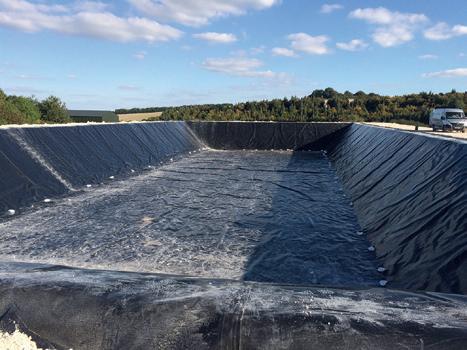
Comprehensive
Materials




















67
JULY 2023 In print, in pocket, informed, in profit. App Edition farmersguardian.com/app YOUR DEPENDABLE PARTNER FOR SLURRY STORAGE SOLUTIONS enquiries@enviroseal.co.uk t: 01695 228626 www.enviroseal.co.uk
LAGOON FLOATING COVERS
rainwater out of slurry Reduces odour from lagoons Covers comply with EA and SSAFO legislation
LINERS
Breakthrough mastitis detection
SLURRY
Keeps
SLURRY LAGOON
warranty
25 year
meet EA and SEPA requirements Installed and tested by certified technicians Enviroseal provide a complete range of products for slurry storage


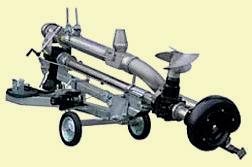
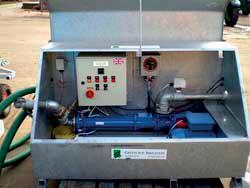








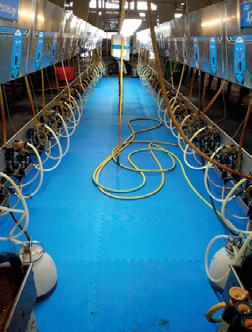




Equipment & Accessories SEPCOM The unique separator Slurry pumps & lagoon mixers 01328 701992 | enquiries@greencrop co.uk | www greencrop co.uk Multicam dirty water irrigator Slurry pump Pump in a box CLASSIFIED TELEPHONE: 01772 799400 1 8m x 1 2m / 6ft x 4ft Each 30kg Per Mat Easy Grip Handles Animal Proof Weather Resistant 100% Rubber Construction R U B B E R S Y S T E M S F O R A G R I C U L T U R E DAIRY MAT ARK www arkmat co uk C a l l o r E m a i l F o r P r i c i n g A n d F u r t h e r D e t a i l s 01392 209 394 info@ark-rubberandresin co uk PARLOUR MATTING HEAVY DUTY SILAGE PIT MATS SUPERSOFT CUBICLE MATS ALLEY MATS 5 YEAR G Feedstuff GPS Trackers Delaval mobile milking bale for hire/sale. Delaval Blue Diamond 32/32 fast exit MM25s. Save energy, Ice Builders : Bulk Milk Tanks. Heavy duty replacement troughs for most parlours. Delaval VMS Robots : Milk meters, keypads, feeders etc. Everything for the Dairy Farmer Call Vic/Tracey Brown Tel: 01260 226261 www.milkingequipment.com Milking Equipment Building Services SPRAY FOAM INSULATION To Crop & Livestock Stores, Poultry Sheds, Cattle & Pig Buildings, Workshops & Barns. Frost & Condensation Protection. Temperature Control Energy Saving Tel: 01405 812682 www.webstersinsulation.com info@webstersinsulation.com JULY 2023 68



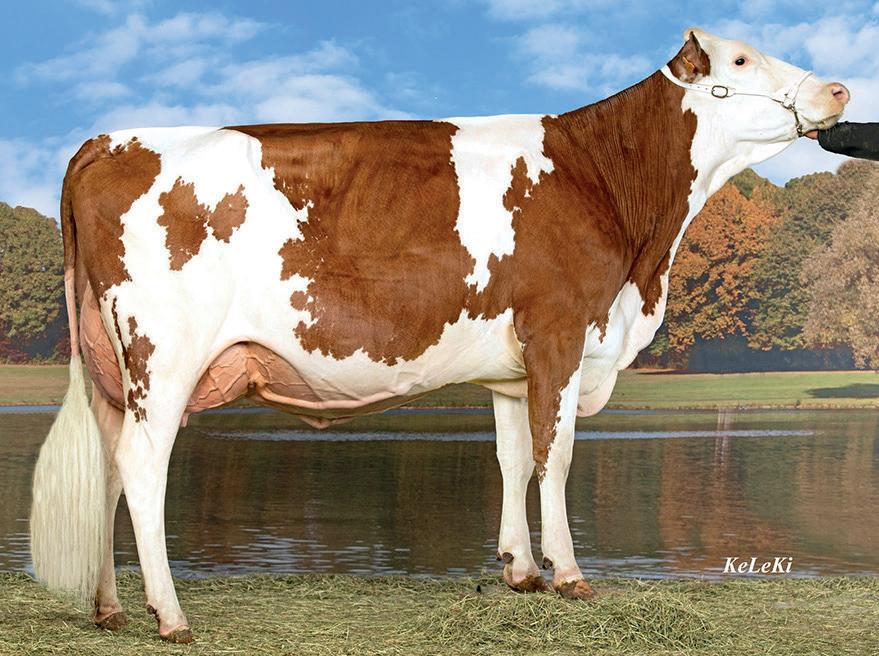











69 JULY 2023 Dairy Cattle THE UK’S PREMIER EVENT FOR FARMERS AND LANDOWNERS farmbusinessshow.co.uk To find out more about exhibiting, scan the QR code or visit: REASONS WHY YOU SHOULD EXHIBIT Attendance of 15,000 people is across four shows Generate quality sales leads Build awareness of your brand and products Make innovative business connections Speak directly to your target market Connect with major buyers and key decision makers DIVERSIFY AND INNOVATE YOUR BUSINESS Forthcoming Events Livestock Services FARM HEALTH SOLUTIONS Ask about Herd Health Analysis T . 01756 749444 W . www.crossgateshealth.co.uk PROBLEMS WITH HIGH SCC /MASTITIS? - WANT TO REDUCE USE OF ANTIBIOTICS? - COST EFFECTIVE PRODUCTS WITH EASY WATER TROUGH ADMINISTRATION - DISCOUNTS - WE CAN HELP WITH SHEEP PROBLEMS TOO - CALL FOR A FREE SAMPLE KIT APPLE CIDER VINEGAR (ACV) Nationwide (01948) 662910/663143 george@greenfieldsrise.f9.co.uk Highest yielding alternative to Holstein. For udder health and fertility See updated website www.Formakin-Montbeliardes.com In Calf Heifers & Bulls available from France Formakin Montbeliardes Telephone: Robin McMurrich 07971 973155 Email: formakin44@gmail.com
GOODEvans
‘People can’t eat trees and wildflower meadows’
This month, Roger Evans discusses his fascination with the stories behind old farming pictures, how farmers are no longer recognised for the work they do in producing food and why romance certainly is not dead in the countryside.
Iget my weekly farming x from my weekly subscription to Farmers Guardian. I read all the articles and nd them interesting. e arable pages do not a ect me, but I still like to know what is going on.
But I must confess that my favourite piece is the old photographs sent in by readers. Old photos invariably tell a story; it may be an old story, but it o en went on to shape the agriculture we know today.
Recently (see below) the photo was of two men wearing the big overcoats of that time, riding four big horses through the deep snow of the 1947 winter. e caption said they were on their way to feed some ca le. It looked as if they were carting a load of loose hay to those ca le.
If we look behind the picture, if it was loose hay it probably meant they had to get the hay out of a rick and they probably had to cut it out with a hay knife, a laborious activity, but whatever they did they almost certainly had to load it by hand.
It is not easy to make a then and now comparison. But although those men certainly worked harder they were limited by how much work a horse could do and by daylight hours.
Outdoor clothing is much be er now than it was and muscle power has been replaced by the power of hydraulics. However, I suspect that on farms today, longer hours are worked in the milking parlour or on tractor at night. But it remains that none of us are using as much of our own power.
Fitness
When I was a teenager and into my early 20s I spent week a er week pitching small bales of hay and when that was done we moved on to small bales of straw and bags of corn. No need to go to the gym in those days.
e biggest di erence of all would be that what those men did and the hard life they endured would be appreciated by most of the population. at would make such a di erence.



70 JULY 2023
FG CLASSIC ★★★
Wallace Connett taking fodder to cattle at Cranham in the Cotswolds in 1947. Sent in by Wallace’s son, Christopher.

“Don’t worry, farmers’ opinions will count just as soon as food security becomes an issue
I recently read an article that told the story of a collaboration between the National Trust and a university. If I jump to the conclusion, its focus was to ‘improve the biodiversity of the UK and to manage our precious landscapes’. e whole population was to be involved in this task.
I read this article three times to make sure, but the word farmer never appeared. e sad fact is that it doesn’t ma er, farmers’ opinions count for nothing, so why include it?
e other sad fact is that when this report reaches its conclusions, the fact that farmers were not involved will not ma er. Why would you involve farmers when it is an easy shot to blame them for most of our woes?
But don’t worry, farmers’ opinions will count just as soon as food security becomes an issue. You just have to be patient and my feeling is that you won’t have to be patient for long.
e big story this week is that wild ower


meadows have declined by 90% since the 1930s. No-one quali es that by saying that in the middle of that, U-boats tried to starve us and we had several years of food rationing. Farmers responded well in the 1950s and 1960s to make sure that never happened again.
People can’t eat trees and wild ower meadows. But unfortunately some people seem determined to prove this for themselves.
ere is this youngish boy I know, who lives locally, that I have a lot of time for. is is largely because he always seems to have time for me.
Sheep hurdles
Recently his partner celebrated her 21st birthday, so he bought her 21 sheep hurdles. She has a ock of ewes to lamb and if you have some ewes to lamb you can never have enough sheep hurdles.
I am only telling you this so you know romance is alive and well in the countryside and living near me.

JobsInAgriculture Jobs in your field Let us keep you updated by email and never miss another great job JobsInAgriculture.com
Receive the latest jobs in your inbox with our free email alert service 71 JULY 2023
Find Jobs Faster
Grass is a major resource in the USA, with farmers and researchers paying more attention to its value and potential. Cedric Porter finds out more on a trip to Nebraska.
Grass is a key feature of US agriculture, not just providing forage, but improving its environment. The country is 914.8 million hectares (2.26 billion acres), of which just 17.3% is cropped.
The biggest single use is grassland and range land which can be grazed.
It accounts for 29% of land or 265mha (655m acres), just ahead of forest land. Protected land, such as reserves and urban land, accounts for most of the rest of the land.
That grassland helped feed 9.4m dairy cattle in 2022, up 0.2% on the year before. The total number of cattle and calves in the country last year was estimated by the US Department of Agriculture at 89.3m head, down 2.8% and near to the 2012 figure – the lowest number seen in the last 70 years.
At the beginning of the 1970s, there were more than 130m cattle in the US.
Nebraska is not a major dairy state – it has just 57,000 dairy cows –but it is a major beef cattle state, with
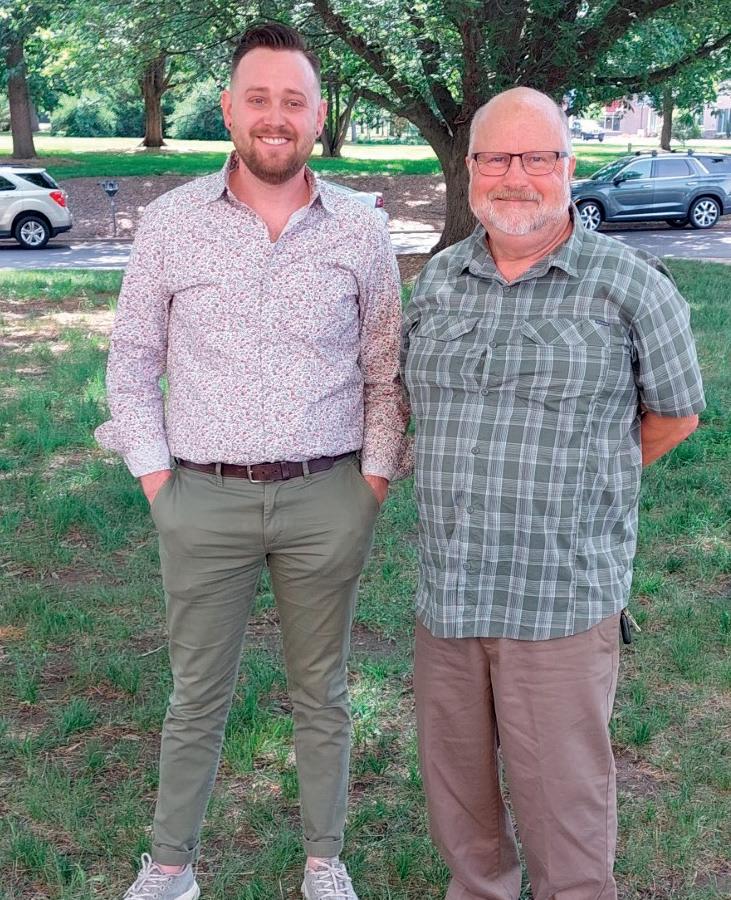

America turns to its grass to save water and carbon
6.5m head, making it the fourth most populous cattle state.
It is a global centre for grass and cattle research, partly because of the richness of its grassland.
The state is 200,000sq.km, only 18% smaller than the whole of the UK. Of that, nearly 60% is grass and almost one-third of the state is in the Sandhills region, which is regarded as the world’s most intact continuous prairie land.
Grass is so important to the state that the University of Nebraska has its own Centre for Grassland Studies. There, one of its directors, Dr Dave Wedin, explained how he is establishing a ‘Coronation Meadow’.
He said: “King Charles is passionate about restoring grassland biodiversity, so we wanted to honour his desire to establish flower-rich grasslands in Britain and elsewhere by creating one here in Nebraska.”
Dr Wedin added that the state’s grassland does not only have a biodiversity value, but it helps preserve the Ogallala Aquifer, an underground water reserve, which is used by crop farmers in the state for irrigation and helps feed water to arable states to the south.
He said: “Unlike in Kansas, Oklahoma and Texas, the water
level of the aquifer in Nebraska has risen over the last 70 years, because our large area of permanent grassland is capturing rainwater and snow melt and feeding it underground.”
The preservation of such a precious resource is aided by the Conservation Reserve Programme (CRP), which is similar to current Defa policy in paying for soil management.
It is a US Government scheme initially introduced in the 1980s to take land out of production to support grain prices.
Contracts
Farmers sign up for 10- to 15-year contracts and are paid a rent according to soil fertility. This can be as much as US$346/ha or US$140/acre (£275/ha or £111/acre), said Dr Wedin’s colleague Dr Nic McMillan.
Dr McMillan said: “Farmers can break the contract if they want to revert to crops because of high prices, but despite the rise in grain prices over the last two years, the area of land in Nebraska in the CRP is at an all time high of 566,000ha.”
The introduction of higher payments has helped increase uptake of the CRP, with 2mha (4.9m acres) entering the scheme in 2023, 25% more than the area of contracts
expiring this year. Separately, the new US Farm Bill is set to pump US$500m (£395m) into conservation programmes in Nebraska alone over its five-year lifetime.
The focus on carbon management of grassland is also increasing in the US, although interest in carbon trading among farmers seemed to lag behind the UK.
Work by the University of California has found that grasslands store more carbon than forests if they are not ploughed.
Lead author Pawlok Dass said: “Grasslands store more carbon than forests because they are impacted less by logging, droughts and wildfires.
“This does not even include the potential benefits of good land management to help boost soil health and increase carbon stocks in rangelands.”
The value of that management is being studied at the University of Nebraska, with early work suggesting that sympathetic grazing of permanent pasture sinks more carbon than grassland which is left wild.
The university’s work focuses on beef production, but professor of ruminant nutrition, Prof Galen Erickson, explained that it applies to all cattle and the department collaborates with Harper Adams University’s Prof Jude

JULY 2023 72 GLOBAL
Dr Nic McMillan (left) with Dr Dave Wedin.


Capper on improving production. He and his colleagues have calculated that in a cow/calf beef rearing system, 3,110kg of CO2 equivalent is emitted as enteric methane as a result of rumination, 6,110kg from respiration and 2,568kg from manure, soil and energy, giving a total of 12,288kg of emitted CO2 equivalent.
However, using permanent grassland in such a system sequestrates 12,513kg of CO2 equivalent, effect-
ively making it carbon neutral. Finishing cattle on bought-in feed also reduces beef carbon footprint, because of quicker times to achieve higher yields.
A study at Oklahoma State University found that grain-finished beef could have up to a two-thirds lower carbon footprint than grassfinished, with higher carcase weights and a higher dressed weight percentage contributing to the advantage.

Steer beef yields have increased by about one-third on average, said Prof Erickson, with hormones contributing to the increase.
He defended their use, saying that an estrogenic implant leads to 1.2 nanogrammes of estrogen in an 85g serving of steer beef, compared to 0.85ng in a non-implanted one.
However, that is way behind the 94ng in eggs or 19m nanogrammes of estrogen in tofu.
Stimulant
Although not routinely used, US dairy producers can use the hormonal stimulant recombinant bovine somatotropin. The UK has stated that it will not allow hormone-treated meat into the country in any trade deals it negotiates.
Prof Erickson also questioned the criticism of water use in production. He said: “It is often quoted that beef uses 15,000 litres of water to produce 1kg of beef, but this is rarely put in context, as 90% of that water is ‘greenwater’ which falls as rain and


snow, captured in the soil and evaporated by plants, which would happen if there were no cattle.”
Average US milk production has increased from 4,450 litres in 1970 to 10,950 litres now, a rise of 146% as the industry consolidated from an average of just 19 cows per herd to more than 330 now.
There were 2.6m more dairy cows in the US in 1970, so the carbon footprint per litre of milk produced has reduced dramatically over the last 50 years.
It is a similar story in the UK, where the number of dairy cows has fallen by 30% since 1996, while milk production has increased by 9%.
rThe trip Cedric Porter joined was arranged by the US Sustainability Alliance, a group of 24 commodity associations, including the US Dairy Export Council. It has three roles: providing information on the sustainability of US agriculture; sharing best practice; and engaging with regulators and consumers across the world.





JULY 2023 73 GLOBAL
sure to find what you
on
. Start listing your items FREE today! Browse. Sell. Buy at FGBuyandSell.com
Brought to you by Farmers Guardian, FGBuyandSell is the platform for you to sell your items to a responsive farming community.
From dairy cattle, milking parlours, calving equipment and everything in between, you’re
need
FGBuyandSell.com
Cattle in the Sandhills region of Nebraska.
A study has shown that giving heifers a non-steroidal anti-inflammatory drug (NSAID) at critical time points can have a substantial and long-lasting benefit. Dairy Farmer reports.
Using an NSAID at calving and during lameness treatment
Anew study has identi ed the bene ts of using NSAIDs routinely in heifers at rst and subsequent calvings and, in conjunction with conventional best practice of a therapeutic trim and a hoof block, every time a dairy heifer is identi ed as lame.
For the study, 528 dairy heifers were recruited for a 34-month trial to investigate the e ects of routine treatment with an NSAID at calving and during treatment for lameness on the future probability of lameness and culling.
e animals were exposed to normal farm conditions and were split into four groups:
rGroup one – Received a therapeutic trim and a hoof block on the sound claw (if deemed necessary) every time they were treated for lameness.
rGroup two – Received the same treatment as group one, with the addition of a three-day course of a NSAID (single dose daily) every time they were treated for lameness.
rGroup three – Received the same treatment as group two, with the addition of a three-day course


of a NSAID (single dose daily) starting 24-36 hours a er each calving.
rGroup four – Animals received a three-day course of an NSAID (single dose daily) every time they were identi ed as lame.
Animals were monitored for the duration of the study and probability of lameness was assessed by a lameness outcome score collected every 14 days.
Data on culling was also extracted from farm records. Some 438 animals were included in the nal analysis which revealed that treating a group of cows following the group three protocol led to an absolute reduction in lameness of about 10% and severe lameness of 3%, compared with animals treated in accordance with conventional best practice (group one).
James Wilson, foot health consultant and lead researcher on the trial, says: “It appears that through giving heifers an NSAID at critical time points we have imparted a substantial, long-lasting bene t to them.
“When freshly calved heifers enter the herd for the rst time,

we understand they are typically naive to lameness and have good hoof health.
“By utilising NSAIDs strategically, we believe we have preserved the functionality of the foot, thereby reducing the risk of lameness.
“ is is a highly e cacious, cost-e ective means of managing ca le mobility on-farm.
Surprised David Bacon, of Gleadthorpe Grange Farm, Mans eld, No inghamshire, whose dairy herd was used in the study, says: “We were really surprised with the outcome of the study, but what surprised us the most was the long-term e ects on heifers and how administering a three-day course of an NSAID routinely 24-36 hours a er calving, and as and when required in conjunction with a therapeutic trim and hoof block, dramatically reduced lameness and increased life expectancy.
“We have now incorporated an early detection and prompt e ective treatment protocol into our herd health plan.
“In addition to a three-day course of an NSAID [single dose daily] 24-36 hours a er each calving, we now mobility score our milking cows every two weeks. We carry out therapeutic trims the following day, use hoof testers to identify lesions and use blocks and an NSAID, as and when required.
“We have also incorporated more routine trims at 60 days for heifers and 90 days and 200 days for all adult ca le, as well as a trim at drying o , which is 42 days pre-calving.”
ere is a wide range of NSAIDs available with di erent properties, including duration of action and withdrawal times.
In dairy cows, it is advisable to consider using a zero milk withhold NSAID which is fully licensed to treat lameness in ca le to avoid any need to discard milk.
However, no NSAID is currently licensed in the UK to treat the pain associated with calving and advice should be sought from a farm vet as to the right choice for individual farms.
JULY 2023 74 RESEARCH
James Wilson
Strategic use of NSAIDs can help preserve the functionality of heifer’s feet, and reduce the risk of lameness according to results of a recent study
15-16 NOV 2023
NEC BIRMINGHAM




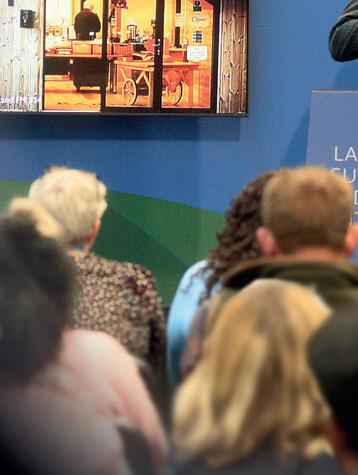





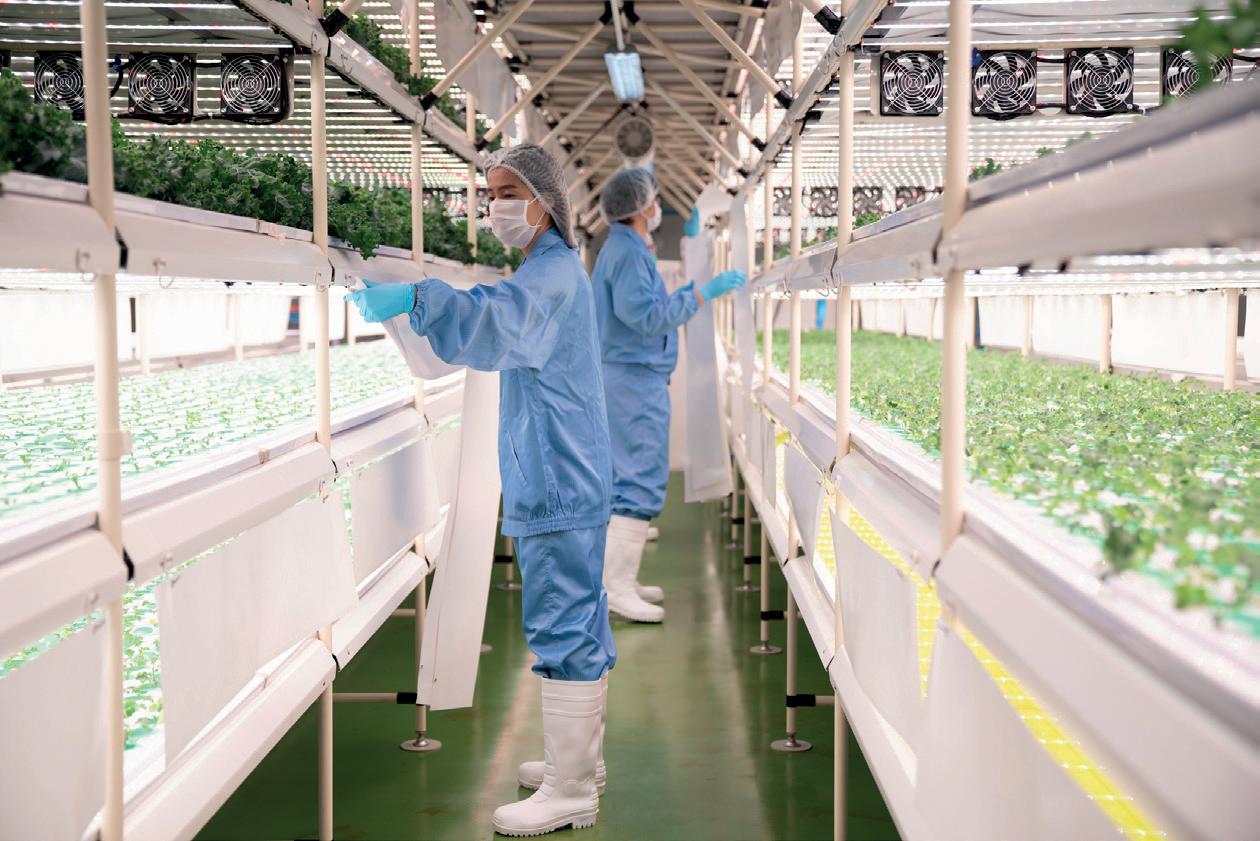

11,539 attendees
62 %
of exhibitors would highly recommend the show to others
THIS EVENT RUNS ALONGSIDE:


us to book your stand
visit: farmbusinessshow.co.uk or

74 %















BUSINESS
Contact
today THE UKS PREMIER EVENT FOR FARMERS AND LANDOWNERS
TASTE OF THE COUNTRY
GREAT
FIGURES FROM 2022 SHOW



SUPERCHARGE YOUR BUSINESS IN THE AGRICULTURAL INDUSTRY





Exhibit at Future Farming Expo today to boost your business, forge valuable connections and be at the forefront of agricultural innovation.


Book your #FFX23 stand today and connect with industry leaders, innovators and 3,000+ visitors hungry for new solutions.
Total farm businesses (2021): 7,184
Total area in ha (2021): 951,617
2,879 farms and rural businesses see high value in current farming periodicals
2,257 farms and rural businesses value information on the latest technology to help increase profits
The farming industry in Scotland has a strong record of innovation and investing in farm technology and machinery.
Source - Kynetec, Farm Structure Models
Reach millions of potential customers with us:
Contact Joanna Wignall today:
07881 386 250 | joanna.wignall@agriconnect.com
(Figures representative of parent company Agriconnect’s reach)
CONNECT
AN
SECTOR IN SCOTLAND. Aberdeen (within a 100-mile radius) ✓ 1.2 million web users ✓ 360k social followers ✓ 98.6k readers
EXHIBIT WITH US TO
WITH
ENGAGED FARMING
































































































 Liz Haines
Liz Haines























































































































































































































































































































































































































































































































